|
|
 |
Cover story |
|
|
| 2025 |
|

Vol.27 No.6 |
LIPUS treatment in ED
Current erectile dysfunction (ED) treatments often focus on symptom management, with limited capacity to address underlying tissue pathology. Low-intensity pulsed ultrasound (LIPUS) has emerged as a potential non-invasive strategy aimed at facilitating penile rehabilitation. By delivering low-intensity acoustic energy, LIPUS is thought to stimulate endogenous repair mechanisms within the corpus cavernosum. Preclinical and clinical observations suggest LIPUS may reduce fibrosis, promote angiogenesis and innervation, and contribute to the recovery of erectile function through mechanobiological pathways. As a potential supplement for existing options, LIPUS represents a promising approach that shifts focus from symptomatic relief to structural restoration. Further research is needed to optimize treatment parameters and explore its combined use with other therapies, which may help realize its full potential for managing ED. Please refer to pages 673–679 for details. |
| |
|
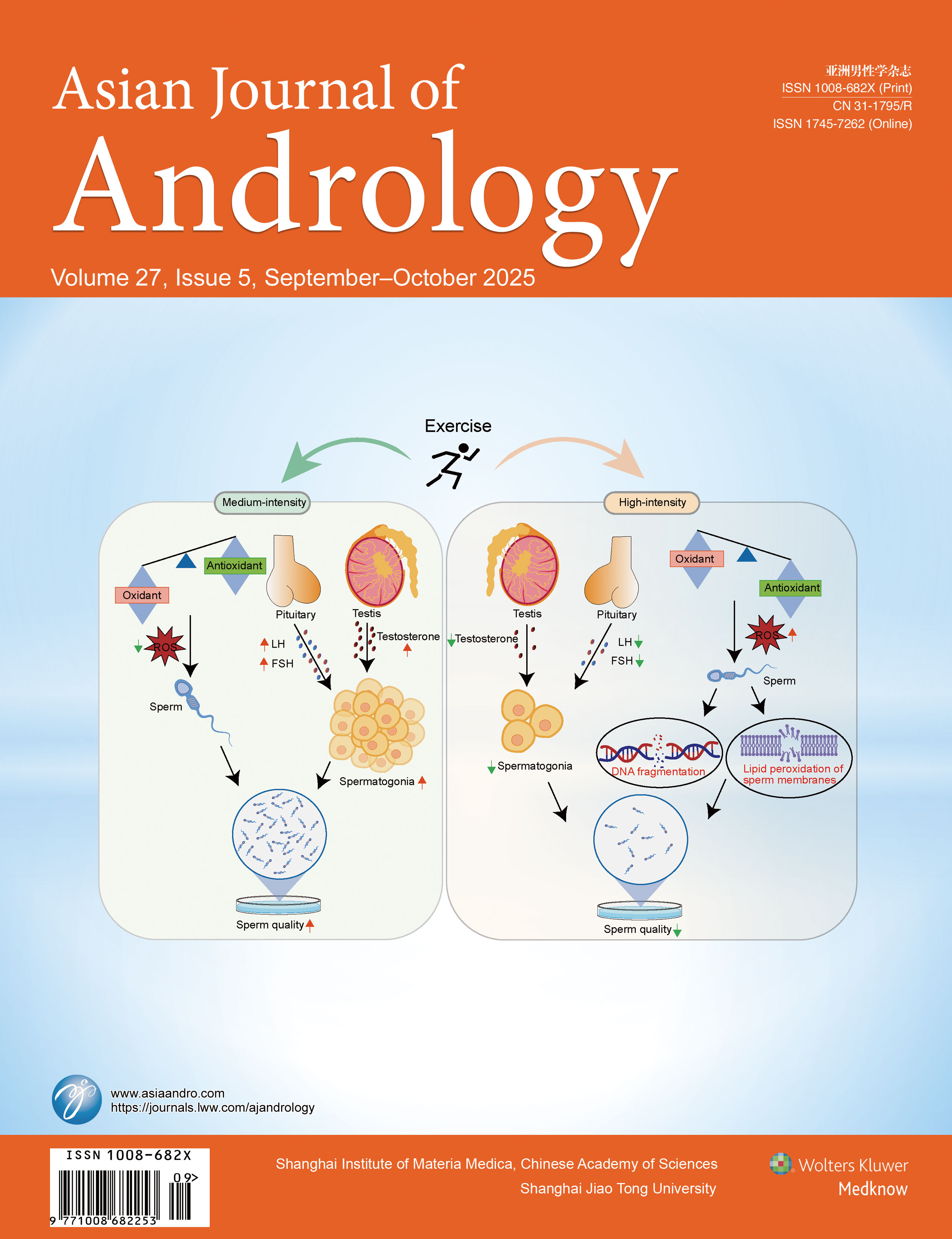
Vol.27 No.5 |
Physical activity and semen quality
Exercise is increasingly recognized as a promising modifiable factor influencing male reproductive health. However, evidence on whether physical activity improves semen quality remains inconclusive. Variations in study populations and methodological designs lead to inconsistent findings. This review provides a comprehensive overview of current research, emphasizing the roles of fertility status and different study design in shaping outcomes. It also summarizes the biological mechanisms by which exercise may influence semen quality, such as hormonal regulation, oxidative stress, and inflammatory responses. Besides, we highlight the need for further research to investigate the potential impact of physical activity on the epigenetic information carried by spermatozoa. Please refer to pages 574–580 for details. |
| |
|
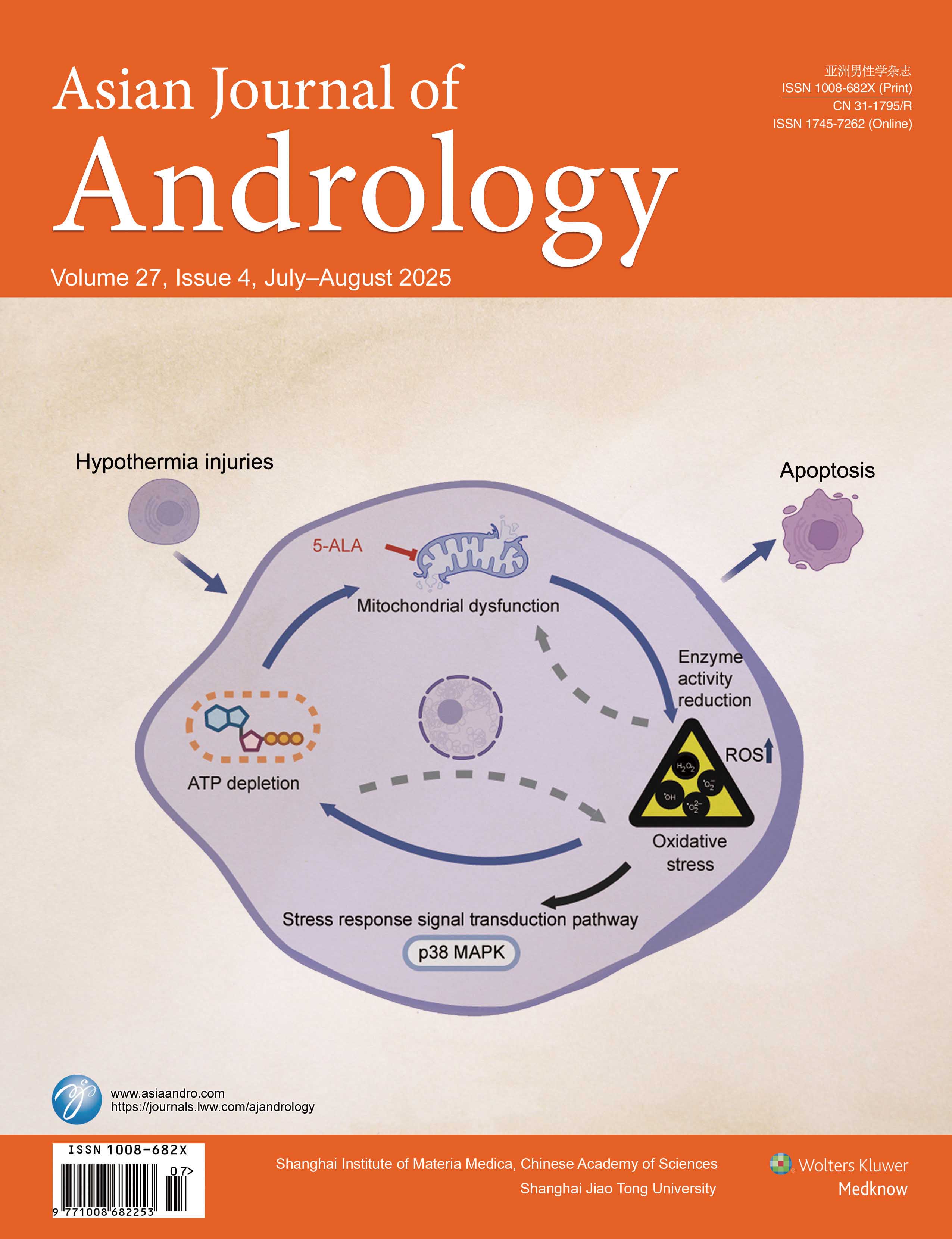
Vol.27 No.4 |
Fertility preservation for prepubertal males undergoing gonadotoxic therapies remains a critical challenge, as these patients cannot produce mature sperm. Key advancements in this field, such as spermatogonial stem cell (SSC) transplantation and testicular tissue grafting, provide promising avenues for future reproductive success. This study investigated optimal storage conditions for mouse testicular tissue during hypothermic transport. It was found that Hank’s balanced salt solution (HBSS) better maintained tissue integrity, while supplementation of 5-aminolevulinic acid (5-ALA) significantly enhanced SSC survival. Mechanistically, 5-ALA may exert protective effects by downregulating the p38 MAPK pathway. These findings contribute to improving prepubertal fertility preservation strategies, ensuring safer tissue transport for future clinical applications. Please refer to pages 454–463 for details. |
| |
|
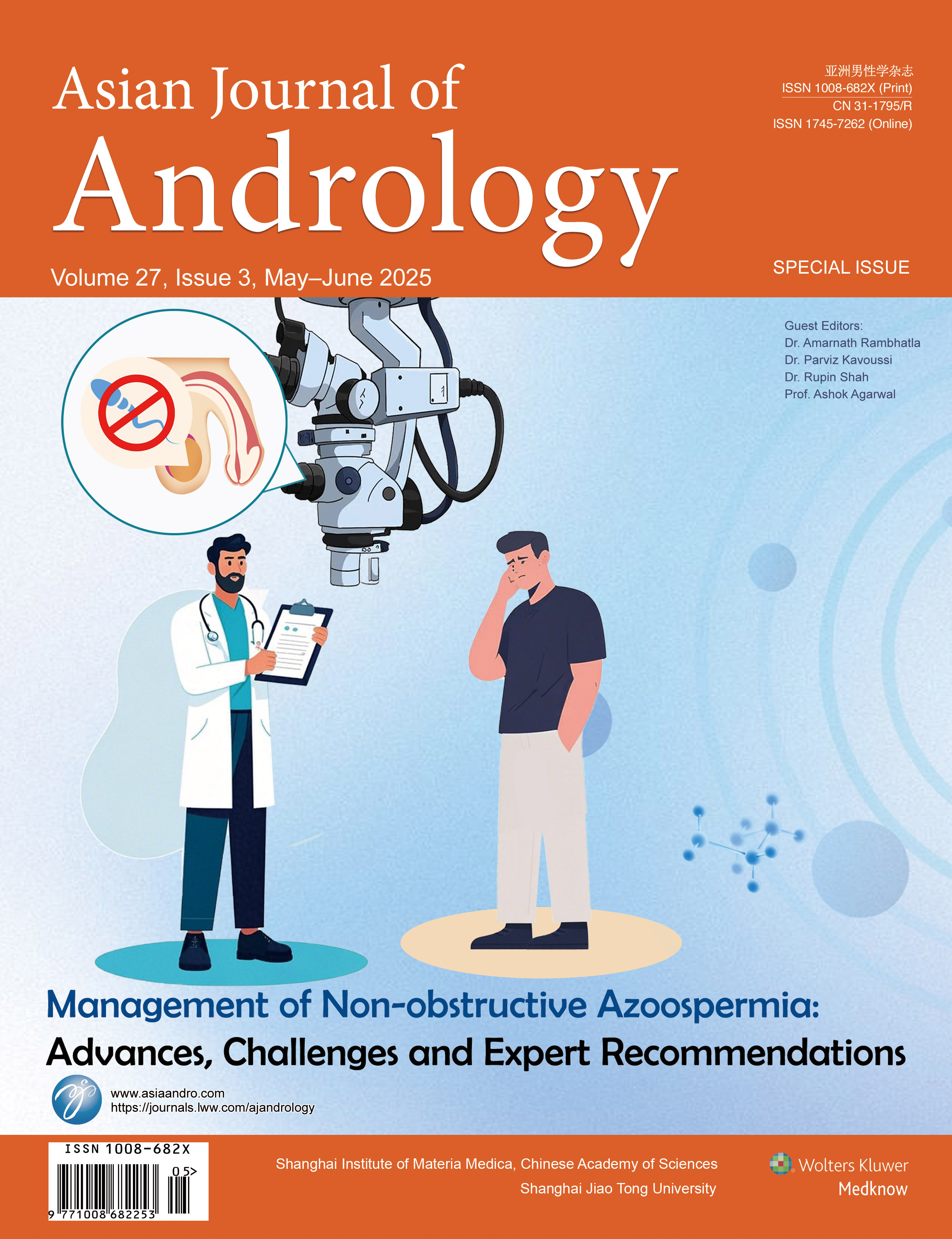
Vol.27 No.3 |
Management of non-obstructive azoospermia: advances, challenges, and expert recommendations
The advent of intracytoplasmic sperm injection (ICSI) has transformed male infertility treatment, offering solutions even for men with very low sperm counts or poor motility. However, in cases of non-obstructive azoospermia (NOA), where no sperm is present in the ejaculate due to testicular failure, the treatment depends entirely on the expertise of the andrologist to retrieve sperm, if any exist. NOA remains one of the most complex and challenging conditions in reproductive medicine.This special issue is dedicated to exploring the full spectrum of NOA, including its causes, diagnostic approaches, and current therapeutic options. Featuring expert and evidence based reviews, this special issue aims to provide practical and up-to-date guidance for clinicians working with these difficult cases and highlights strategies to support couples facing one of the most severe forms of male infertility. |
| |
|

Vol.27 No.2 |
Autophagy in erectile dysfunction
Erectile dysfunction (ED) involves reduced parenchymal cells and increased fibrosis, with limited treatment efficacy. Autophagy, a cellular self-protection mechanism, plays a dual role in ED by regulating apoptosis and fibrosis. It reduces oxidative stress and inflammation, which are key fibrosis drivers, while influencing smooth muscle and endothelial cell fate. Autophagy can either oppose or enhance apoptosis, depending on stress levels and cellular context. Enhancing autophagy lowers inflammatory markers and boosts antioxidant capacity, potentially reversing fibrosis. However, excessive autophagy may trigger cell death, underscoring its complexity. This review highlights autophagy’s therapeutic potential in ED with a focus on its role in apoptosis and fibrosis, and advocates for further research to develop targeted treatments. Please refer to pages 166–176 for details. |
| |
|

Vol.27 No.1 |
Epimedium, a botanical known for its potential benefits on male reproductive health, contains the active compound icariin, which has been extensively studied for its positive effects in this domain. Research indicates that Epimedium may elevate testosterone levels, enhance erectile function, and support sperm health. The mechanism involves the upregulation of nitric oxide production and improved blood circulation, addressing prevalent conditions such as erectile dysfunction and reduced libido. Ongoing scientific investigations aim to further elucidate the comprehensive benefits of Epimedium, thereby establishing its potential as a viable natural therapeutic option for male reproductive health. Please refer to pages 20–29 for details. |
| |
| 2024 |
|
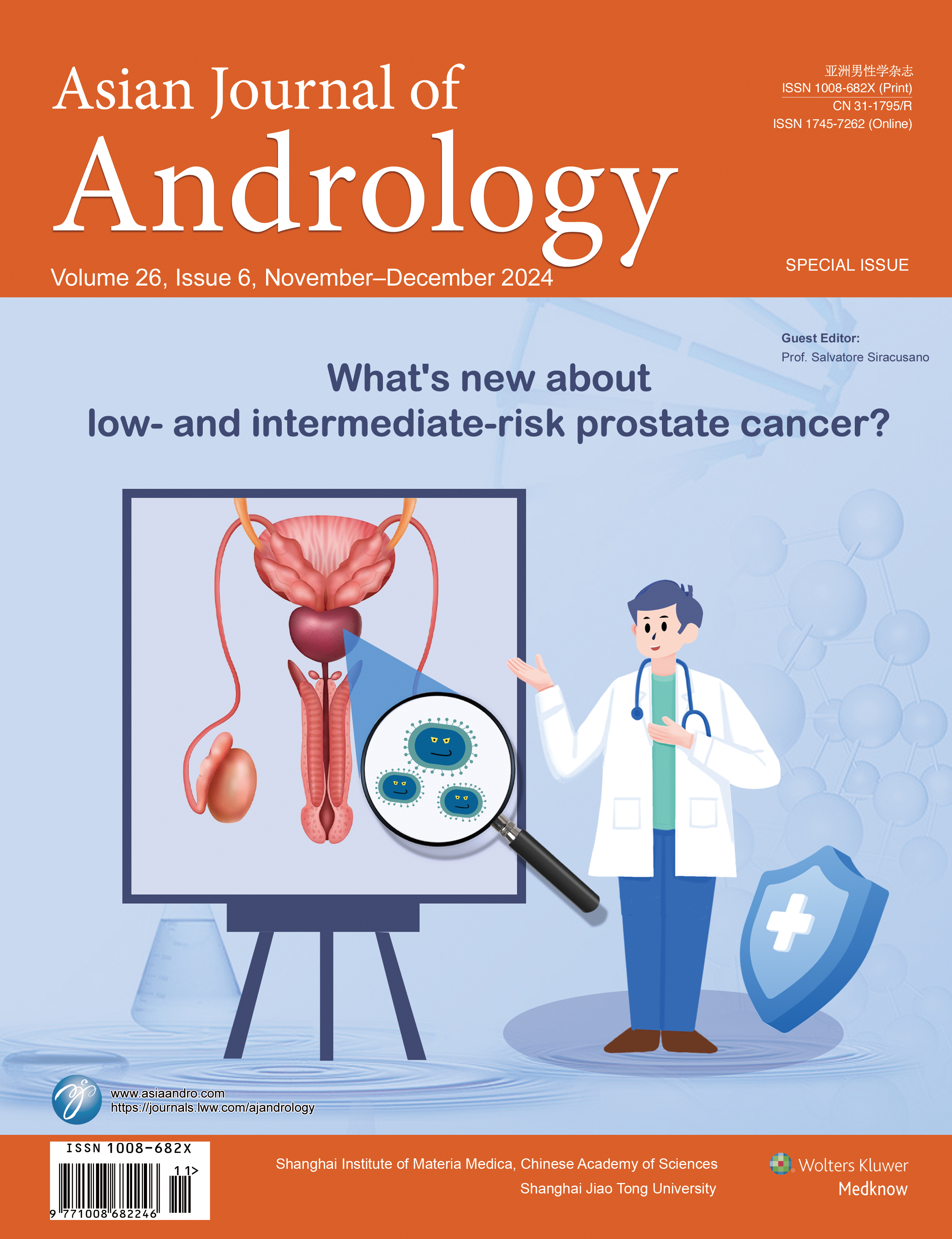
Vol.26 No.6 |
What’s new about low- and intermediate-risk prostate cancer?
Prostate cancer (PCa) has become the second leading cause of death in males. The most represented clinical patterns, low-risk and intermediate-risk PCa, are undoubtedly most subjected to technological innovations. This special issue of Asian Journal of Andrology, titled “What’s new about low- and intermediate-risk prostate cancer”, contains six opinions, five reviews, and one original article. This special issue aims to analyze the most recent diagnostic and therapeutic options available in the area of low- and intermediate-risk PCa. The combination of technological innovation and advances in molecular biology, makes it possible to optimize therapy and improve the quality of life of patients. |
| |
|

Vol.26 No.5 |
Artificial intelligence in predicting varicocele repair effectiveness
Which patients with varicocele will benefit from the treatment is still a matter of controversy. Physical (degree and laterality of varicocele), ultrasound (extent of reflux, size of varicose veins, increase in testicular hardness on elastosonography), hormonal (FSH level), sperm (total motile sperm count) and other (proteomics) parameters have been considered as possible markers to predict the patient who might benefit from the treatment. To date, none of them alone appears to be sufficiently predictive. Artificial intelligence could be a tool which, by combining this information and through the creation of algorithms, may be capable of correctly selecting the patient to undergo varicocele treatment. Please refer to pages 441–450 for details. |
| |
|

Vol.26 No.4 |
The ratio of the second to the fourth digit (2D:4D) is associated with prenatal androgen exposure. This study found that the 2D:4D ratio was significantly increased in boys with hypospadias and it was positively correlated with the severity. The discrepancy was mainly caused by a shift in 4D. This was validated in a mouse model with low prenatal testosterone obtained by knocking out the hypospadias-associated risk gene. Mechanistic exploration revealed that low testosterone during the androgen-sensitive window impedes 4D endochondral ossification, restricting its growth and increasing the 2D:4D ratio (the cover image illustrates the mechanism of the higher 2D:4D ratio in hypospadias). This study indicates that the 2D:4D ratio is a risk marker of hypospadias and provides a potential molecular mechanism. |
| |
|

Vol.26 No.3 |
The penis corpus cavernosum (CC) is named for its unique cavernous vascular sinuses. Artificial CC-like tissues based on acellular or three-dimensional (3D)-printed scaffolds were inconvenient and high costed. Here, we describe a simple, fast and economical method of constructing artificial CC-like tissue. A large number of bubbles were formed in Matrigel by vortexing combined with pipette blowing, creating a porous, spongy, and spatial structure. The CC fibroblasts produced a variety of signaling factors and a 3D-grid scaffold. This human artificial CC-like tissue provide an improved experimental platform for exploring the function and structure of the CC microenvironment, and conducting drug screening for erectile dysfunction therapy. Please refer to pages 260–267 for details. The main cover image was generated using DALL·E 3 and the authors reviewed it. |
| |
|
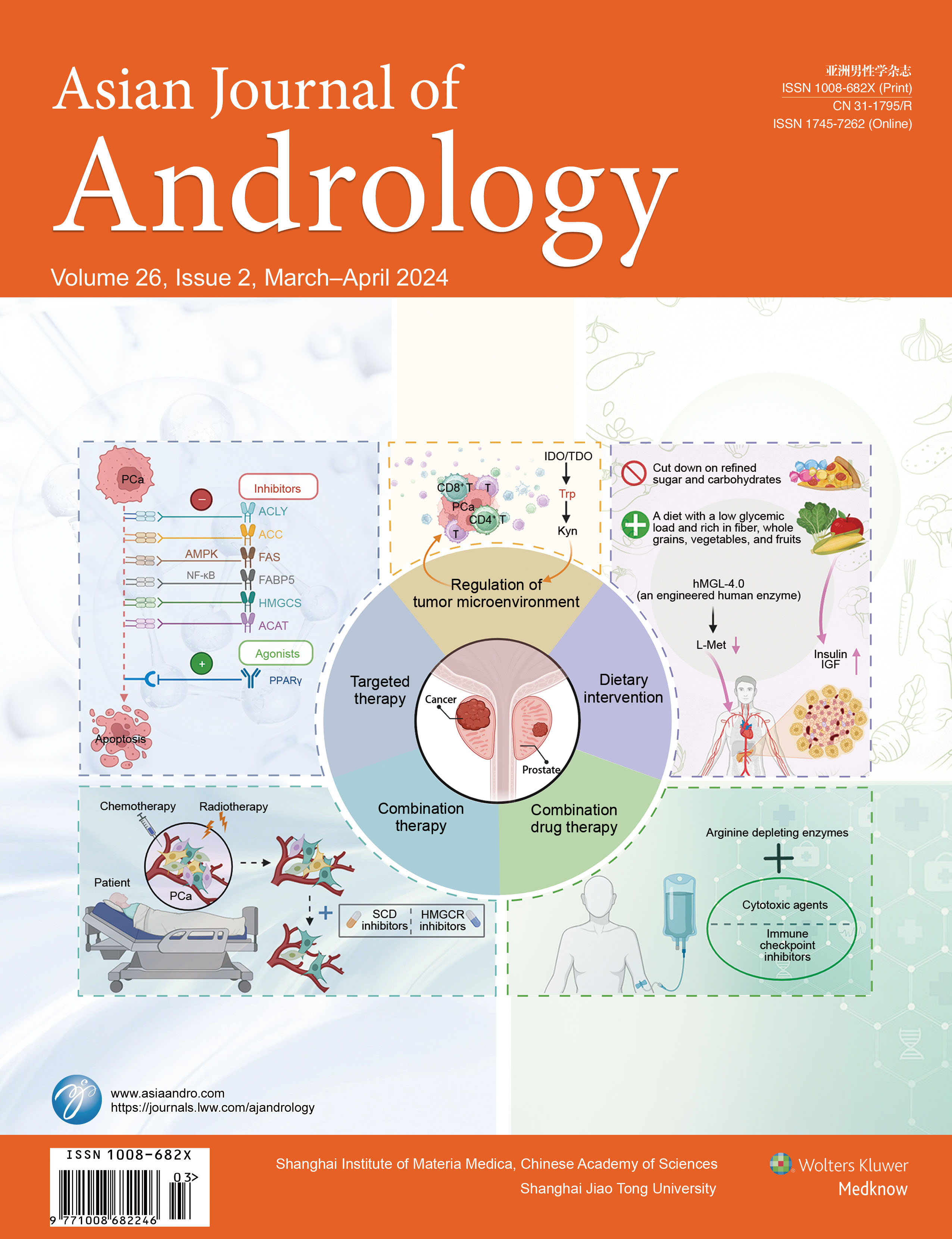
Vol.26 No.2 |
Metabolic characteristics in prostate cancer
Exploring the metabolic regulatory mechanisms in prostate cancer reveals the pivotal roles of lipid synthesis and amino acid metabolism in cell proliferation, metastasis, and disease progression. Cancer cells elevate lipid synthesis and modulate amino acid metabolism to meet the demands of growth and energy requirements. These metabolic features are closely associated with the progression and therapeutic responses of prostate cancer, offering new insights for early diagnosis and treatment. In-depth investigation into the metabolic characteristics of prostate cancer cells, particularly the regulatory mechanisms of lipid and amino acid metabolism, holds promise for the development of more effective therapeutic strategies and diagnostic approaches. Please refer to pages 123–134 for details. |
| |
|

Vol.26 No.1 |
The fundamental pathology of urethral stricture is chronic tissue fibrosis, resulting in the narrowing of the urethral lumen. Despite the availability of various endoscopic treatment methods, additional application of anti-fibrosis agents is anticipated to achieve the desired therapeutic effects. This has been incorporated into the Urethral Stricture Disease Guideline Amendment (2023) of the American
Urological Association. In this review, a summary of drugs tested in vivo to date is provided. The review elaborates on the primary anti-fibrosis targets, along with pressing issues in the pharmacotherapy of urethral stricture, encompassing optimal drug selection
and appropriate administration. The authors also advocate for further research to advance drug treatment for urethral stricture. Please refer to pages 1–9 for details. |
| |
| 2023 |
|

Vol.25 No.6 |
Sertoli cells are susceptible to X chromosomes
Klinefelter syndrome (KS), 47,XXY, is one of the most frequent genetic causes of infertility. We have long been troubled by such clinical observations. First, why do the testicles of KS patients atrophy so much while other organs (such as heart, lung and kidney) remain their proper sizes and basically intact function? Second, why there is a severe loss of cells inside the seminiferous tubules (such as Sertoli cells and germ cells) but interstitial cells (such as Leydig cells and endothelial cells) keep quantity steady or even abnormal proliferation? Recently, scRNA analyses have explained the reason for the heterogeneity, with Sertoli cells expressing inadequate X-inactive-specific transcript (XIST) RNA, resulting in failure of X chromosome inactivation and thus potentially severe dysfunction in KS patients. Please refer to pages 622–673 for details.
|
| |
|

Vol.25 No.5 |
Exosomes in testicular development.
Exosomes not only transmit information among cells, but also regulate cellular functions and biological behaviors. Exosomes play important roles in male infertility-related diseases, such as azoospermia, varicocele, and testicular torsion. This review summarized the functions of exosomes in testicular development and spermatogenesis, including multiple stages of testicular development, testicular immune environments, spermatogenesis, and in vivo disease models. We also proposed potential future research directions to apply exosomes and exosome-encapsulated small molecules to prevent and treat male infertility-related diseases. Please refer to pages 547–555 for details. |
| |
|

Vol.25 No.4 |
Cyclophosphamide, which is widely used to treat tumors and autoimmune disorders, often leads to testosterone deficiency, thereby affecting patients quality of life. The currently recommended testosterone replacement therapy suffers from serious disadvantages, which highlight the need for alternative therapeutic strategies. Bone marrow mesenchymal stem cells-derived exosomes (BMSCs-exos) could be absorbed by Leydig cells through the blood-testosterone barrier in mice, thereby inhibiting cell death in cyclophosphamide-exposed Leydig cells, promoting autophagy in Leydig cells via the AMPK-mTOR signaling pathway, and improving the low testosterone synthesis ability of cyclophosphamide-induced Leydig cells. |
| |
|
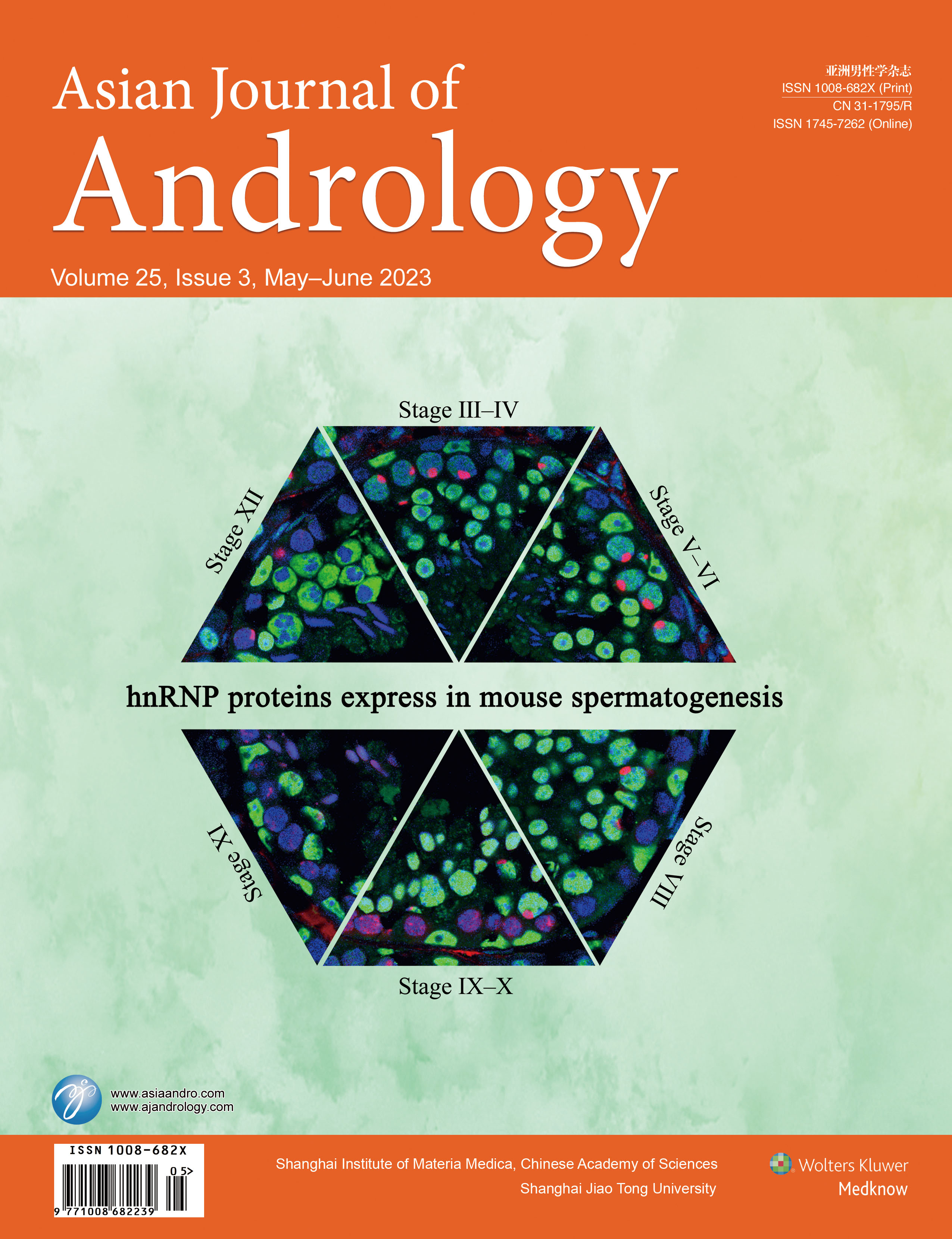
Vol.25 No.3 |
RNA binding proteins (RBPs) play an essential role in male germ cell development due to the high transcriptome complexity of mammalian testis and two unique periods of transcriptional cessation during spermatogenesis. Currently, the expression pattern of an RBP family, 12 heterogeneous nuclear ribonucleoproteins (hnRNP) proteins, was investigated in mouse spermatogenesis. Intriguingly, most detected proteins are highly expressed in the nuclei of pachytene spermatocytes, round spermatids, and Sertoli cells, whereas some proteins locate in the specific organelle, such as manchette. These findings imply the potential function of hnRNP proteins in male germ cell development and spermatogenesis. |
| |
|
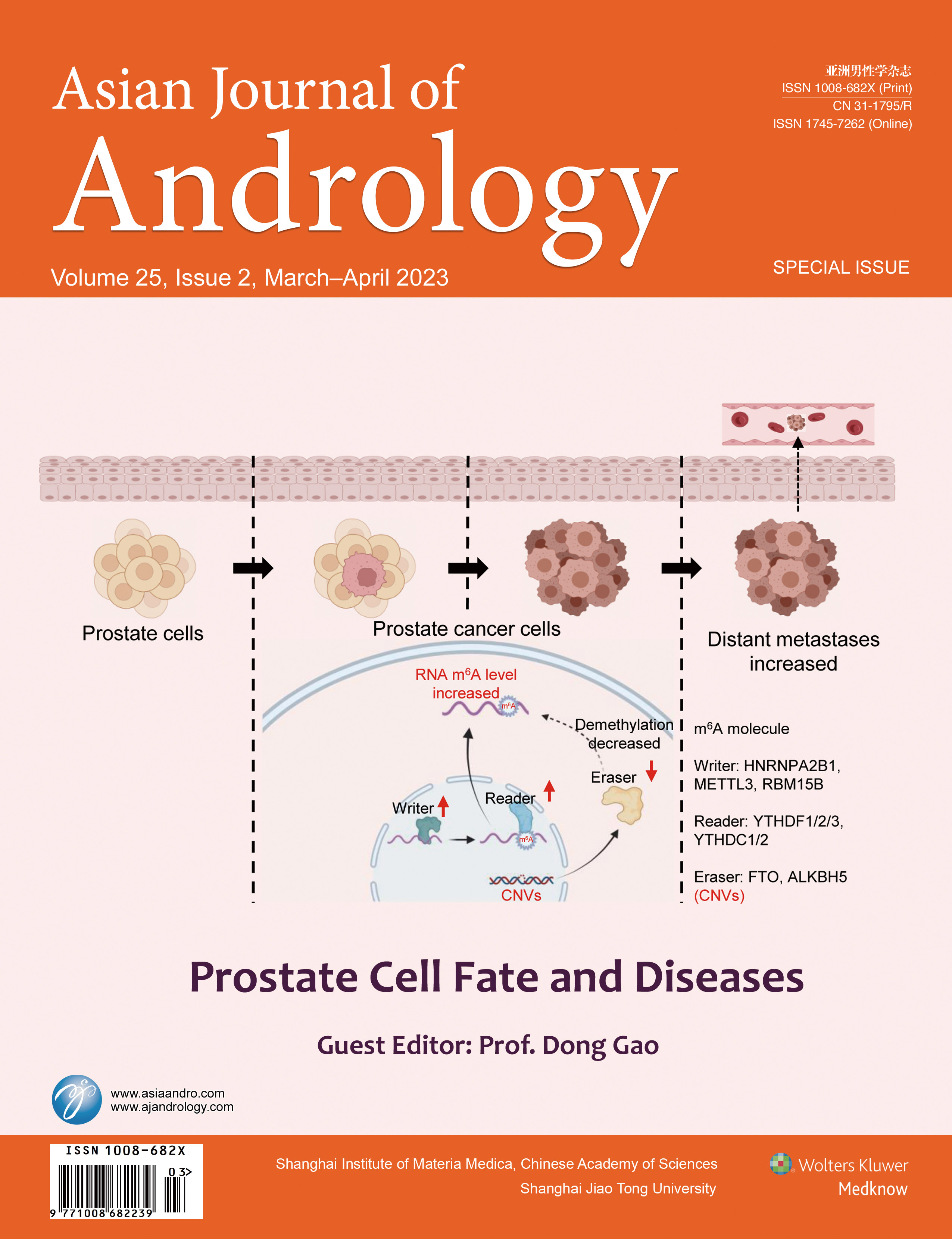
Vol.25 No.2 |
Prostate Cell Fate and Diseases
Prostate Cell Fate and Diseases
Prostate cancer (PCa) initiation, progression, and therapy resistance involve genetic and epigenetic alterations that lead to aberrant cell lineage specification and plasticity. This special issue, “Prostate Cell Fate and Diseases”, contains six original articles and five reviews to introduce some recent PCa research progress in the field of prostate cell fate determination and lineage plasticity. As highlighted in this special issue, genetic alterations, epigenetic events, master regulators, chromatin modulators and microenvironmental factors play important roles in PCa cell lineage determination and plasticity. Remarkably, each of these factors has the potential impact on the drug sensitivity and patients’ survival.
|
| |
|

Vol.25 No.1 |
One of the sex chromosomes that affects an organism’s sex is Y chromosome. The long arm of Y chromosome, which contains the region linked to particular spermatogenesis, is referred to as an azoospermia factor (AZF) where microdeletions most frequently occur. With the help of assisted reproductive technology, paternity inheritance of Y chromosome with AZF microdeletions can occur. Different deletion types result in different spermatogenesis abnormalities. The family accounts of AZF microdeletions are compiled in this review, with an emphasis on the vertical inheritance of the formation of extended deletion fragments, whose possible negative effects need our attention. Please refer to pages 5–12 for details. |
| |
| 2022 |
|
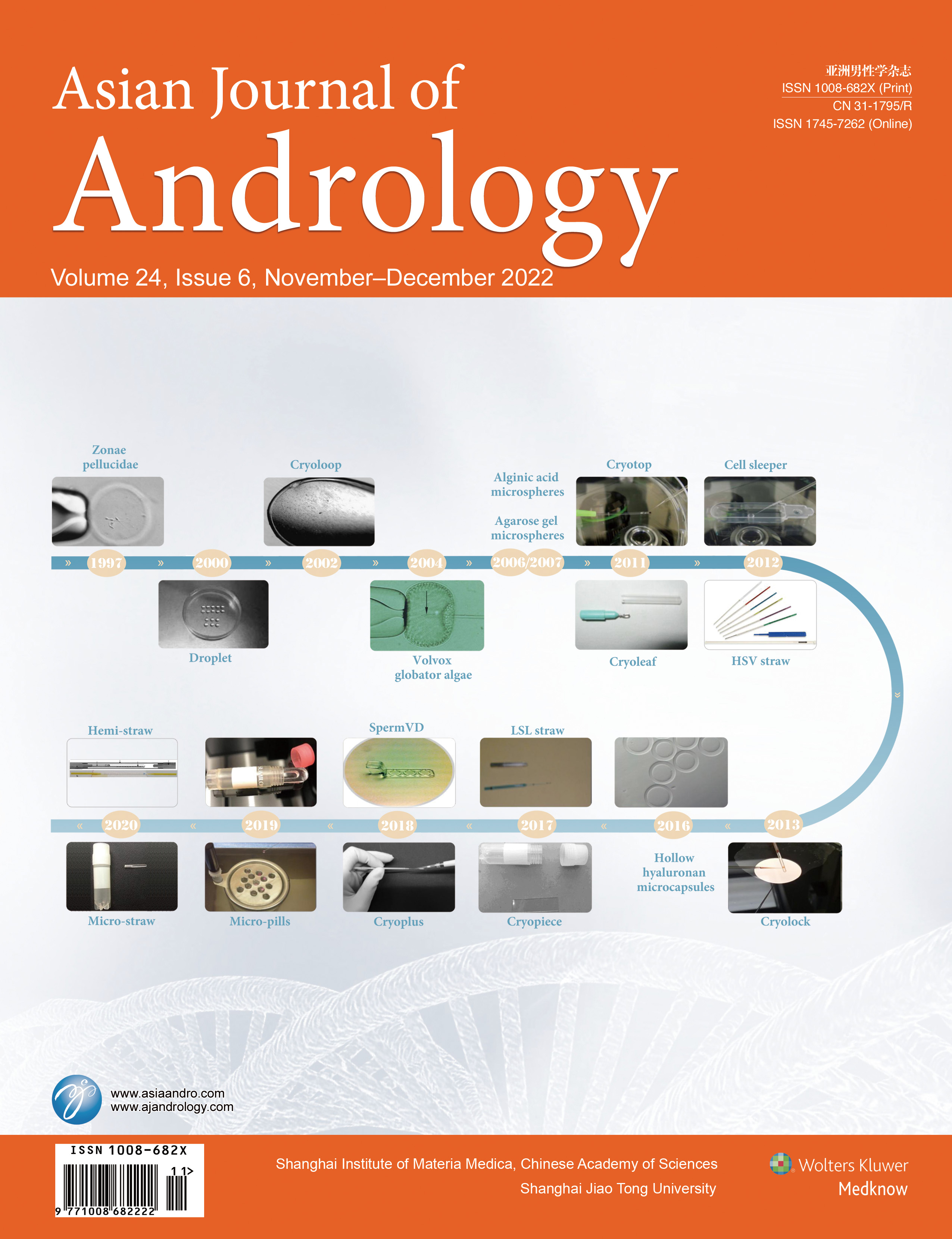
Vol.24 No.6 |
Currently, techniques for the cryopreservation of human sperm have been widely used in assisted reproduction. Certain carriers and techniques have been investigated to avoid spermatozoa loss during freezing process using multiple microquantities of equally divided spermatozoa, or even a small number of isolated spermatozoa. This review discusses recent advances in different cryopreservation techniques, cryoprotectants, and freezing and thawing methods during cryopreservation and new indications for the use of cryopreserved spermatozoa. Please refer to pages 563–569 for details. |
| |
|
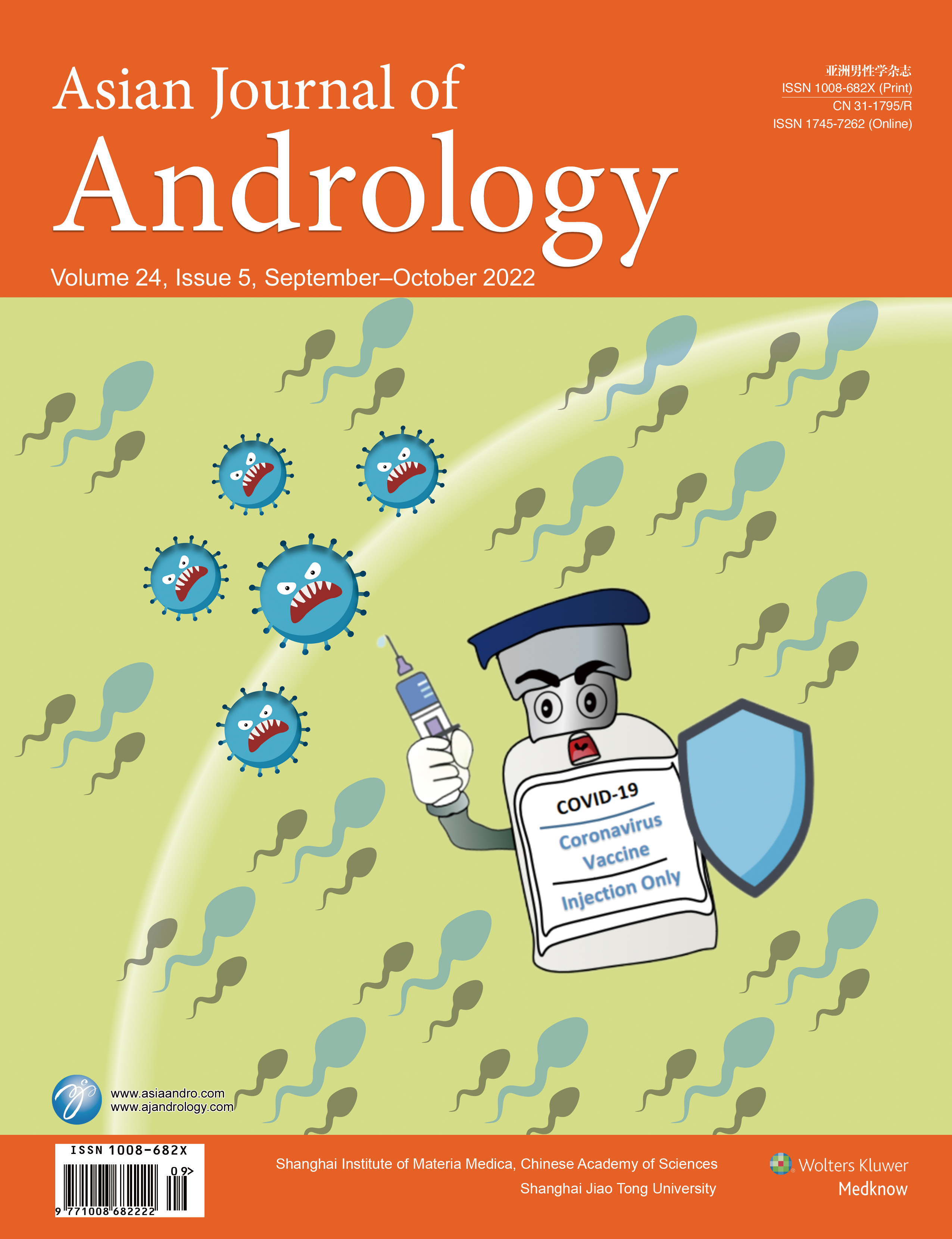
Vol.24 No.5 |
Effect of COVID-19 vaccine on semen parameters. The coronavirus disease (COVID-19), caused by SARS-CoV-2 has lasted for more than two years in the world, and it continues to spread worldwide, posing serious threat to public health. While vaccination is an important method to protect the body from infection, couples who planned pregnancy, clinically treated with ART, and sperm bank donors have been having concerns about the impact of vaccine on the sperm quality. In this context, the importance of determining the impact of COVID-19 vaccine on male’s semen quality is not just for medical research purpose, but also for vaccination decision-making by couples and donors. Please refer to
pages 441–444 for details. |
| |
|
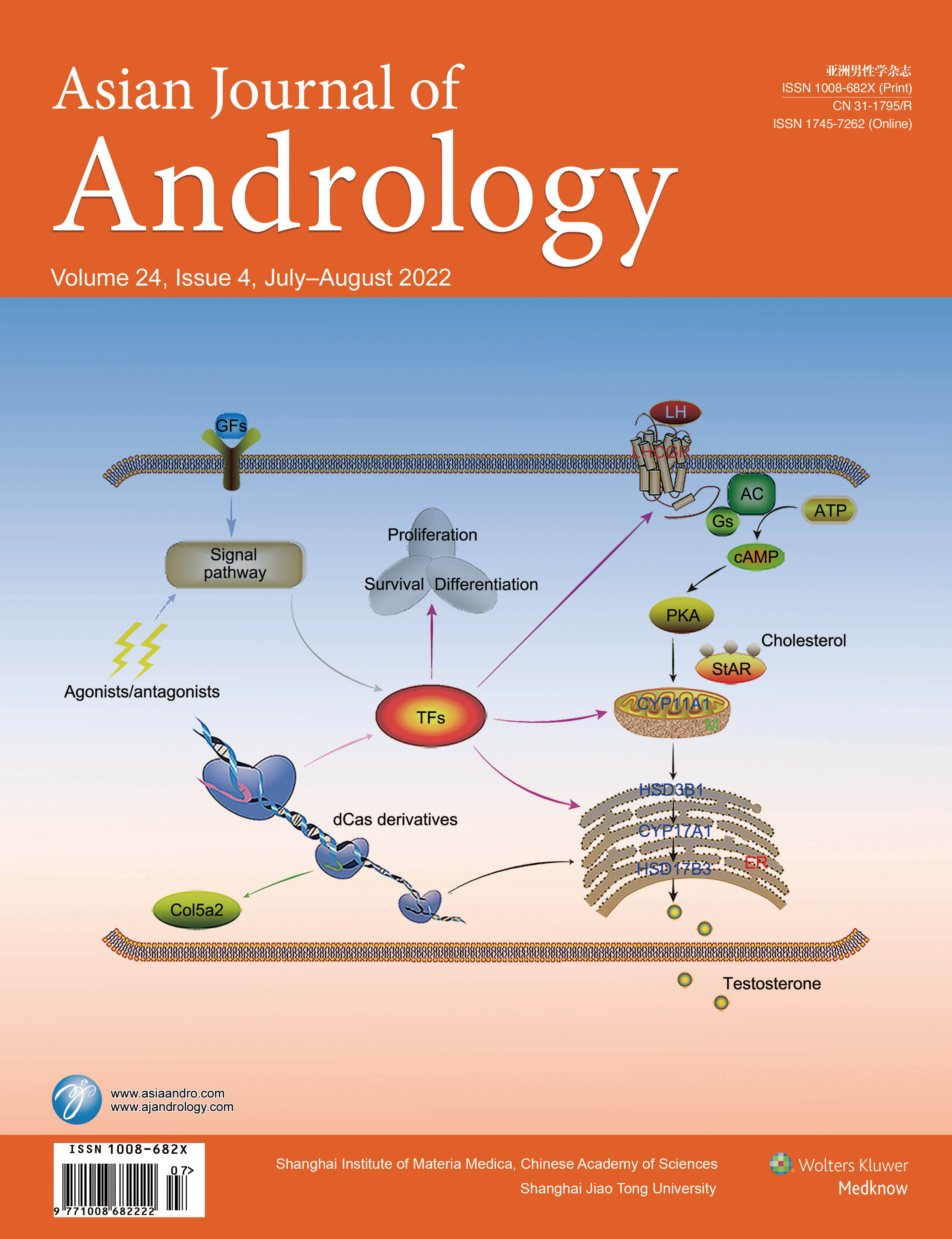
Vol.24 No.4 |
Male hypogonadism, a common clinical syndrome caused by testosterone deficiency, adversely affects males of all ages. Since testosterone is mainly produced in the testes by Leydig cells, the therapy involving testosterone-producing cells has a good promise in managing primary hypogonadism in the future. This review summarized the recent advances in generating Leydig-like cells from various stem cells and somatic cells, with an emphasis on comparing the effectiveness and safety of different protocols used and the cells generated. Meanwhile, potential challenges in Leydig-like cells preparation and clinical application were also discussed. Please refer to pages 335–344 for details. |
| |
|
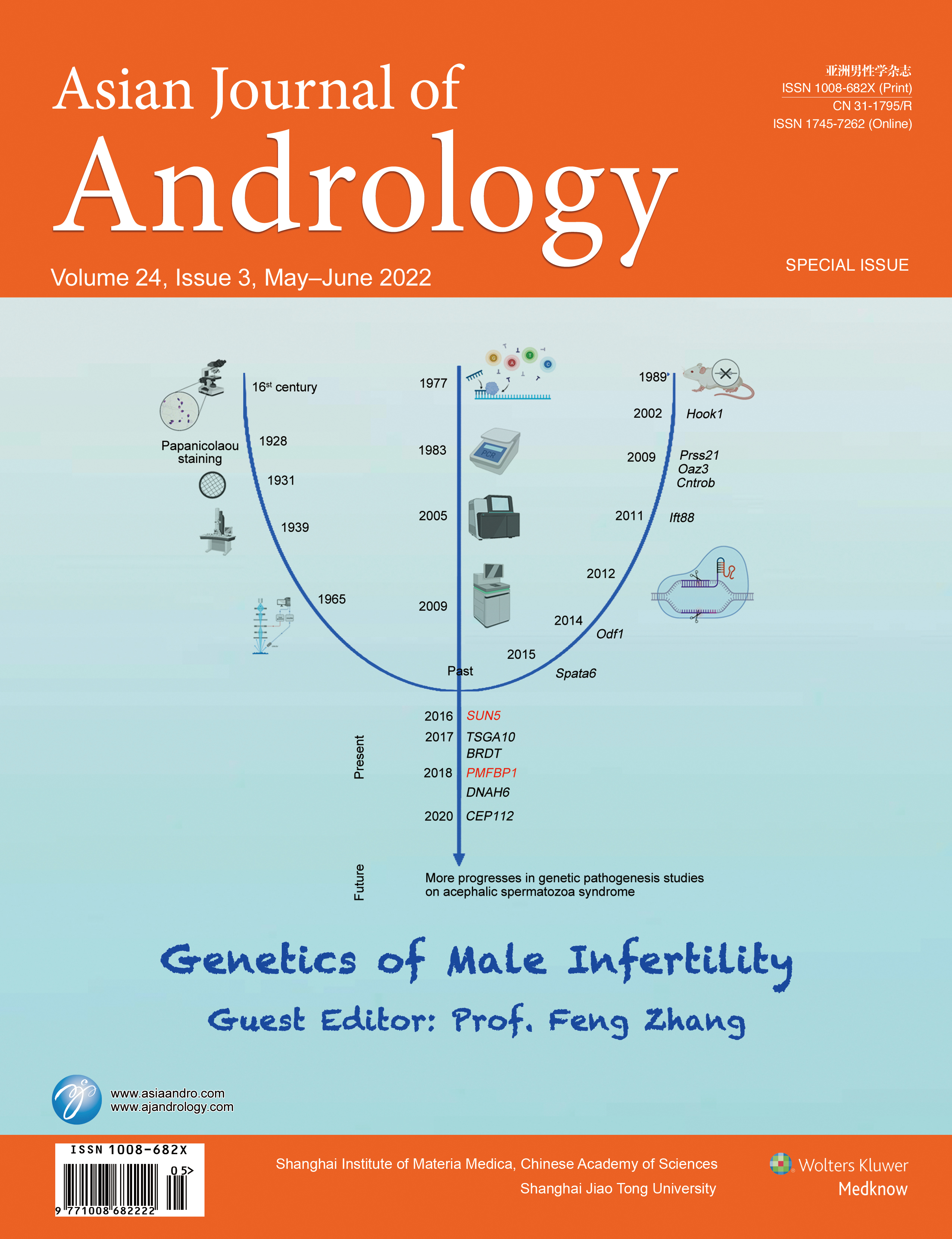
Vol.24 No.3 |
Genetics of Male Infertility
Genetic factors play important roles in the etiology of male infertility. This special issue of Asian Journal of Andrology, titled “Genetics of Male Infertility”, contains two reviews, five original articles, and one commentary to introduce some recent research progresses in the genetic field of male infertility. As highlighted in this special issue, rapid progresses in the genome technologies and animal models have provided a better understanding of the genetic etiology of male infertility. It is trustworthy that the genetic etiology of male infertility will play an indispensable role in the treatment of male infertility. |
| |
|
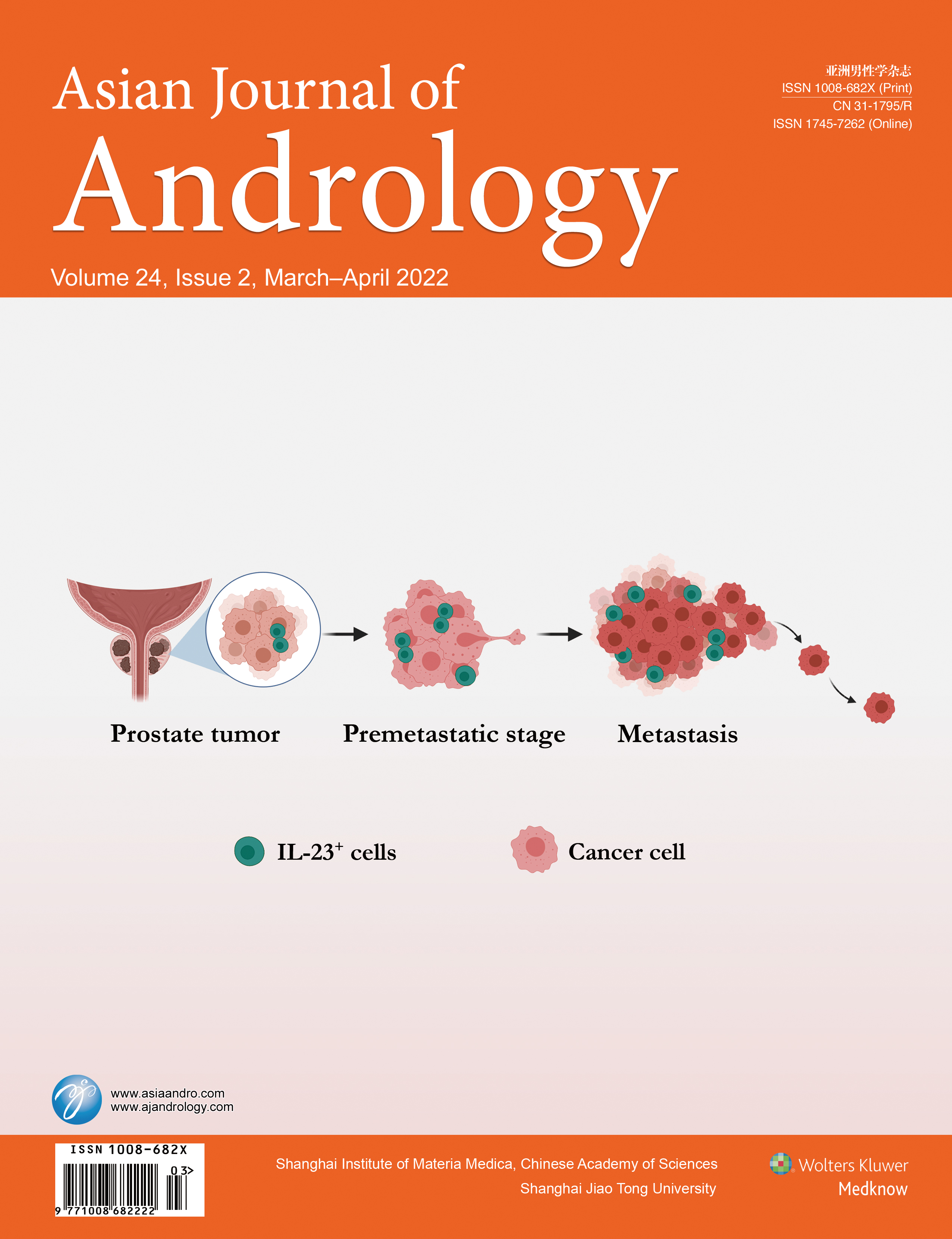
Vol.24 No.2 |
Impact of IL-23 in prostate cancer
Cytokines play a crucial role in dictating immune response towards different types of cancers and decide tumorigenesis fate. IL-23 is one cytokine belonging to IL-12 family cytokine and plays a critical role in prostate tumorigenesis. The abundance of IL-23 positive cells was shown to directly impact tumor progression, starting from initiation of tumor growth to metastatic stage. Moreover, patients with high IL-23+ cells abundance have poor clinical outcomes related to an increased risk of death and CRPC grade. This demonstrates the implications of IL-23 in the diagnosis and treatment of prostate cancer and how targeting IL-23 might benefit to limit the tumor growth and metastasis of prostate cancer. Please refer to pages 223–224 for details. |
| |
|
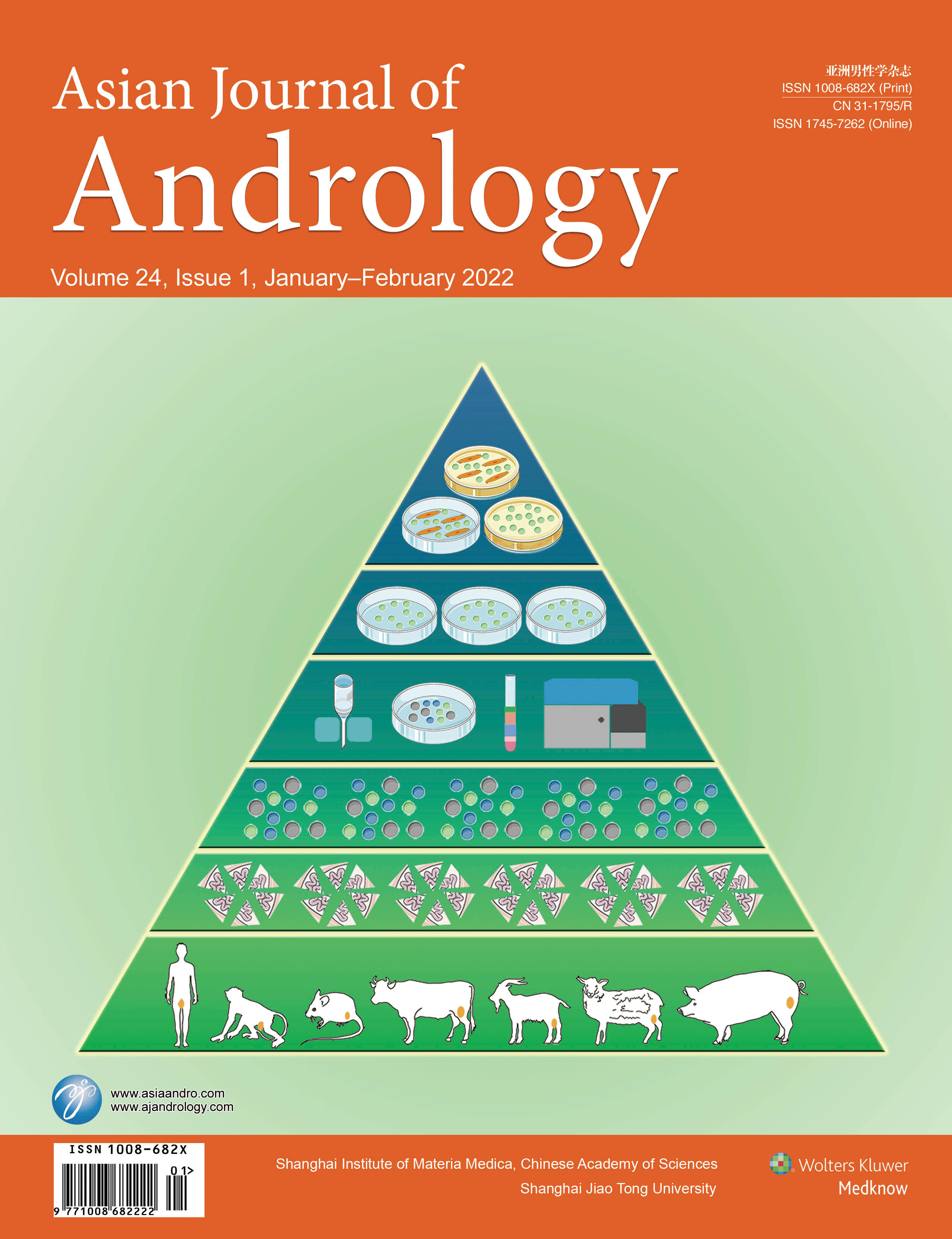
Vol.24 No.1 |
Continuous spermatogenesis depends on the self-renewal and differentiation of spermatogonial stem cells (SSCs). Rodent SSCs are well defined, and a culture system has been successfully established for them. In contrast, available information on the biomolecular markers and a culture system for livestock SSCs is limited. This review summarizes the existing knowledge and research progress regarding mammalian SSCs to determine 1) the mammalian spermatogenic process, 2) the biology and niche of SSCs, 3) the isolation and culture systems of SSCs, and 4) the biomolecular markers and identification of SSCs. This information can be used for the effective utilization of SSCs in reproductive technologies for large livestock animals, enhancement of human male fertility, reproductive medicine, and protection of endangered species. Please refer to pages 5–14 for details. |
| |
| 2021 |
|
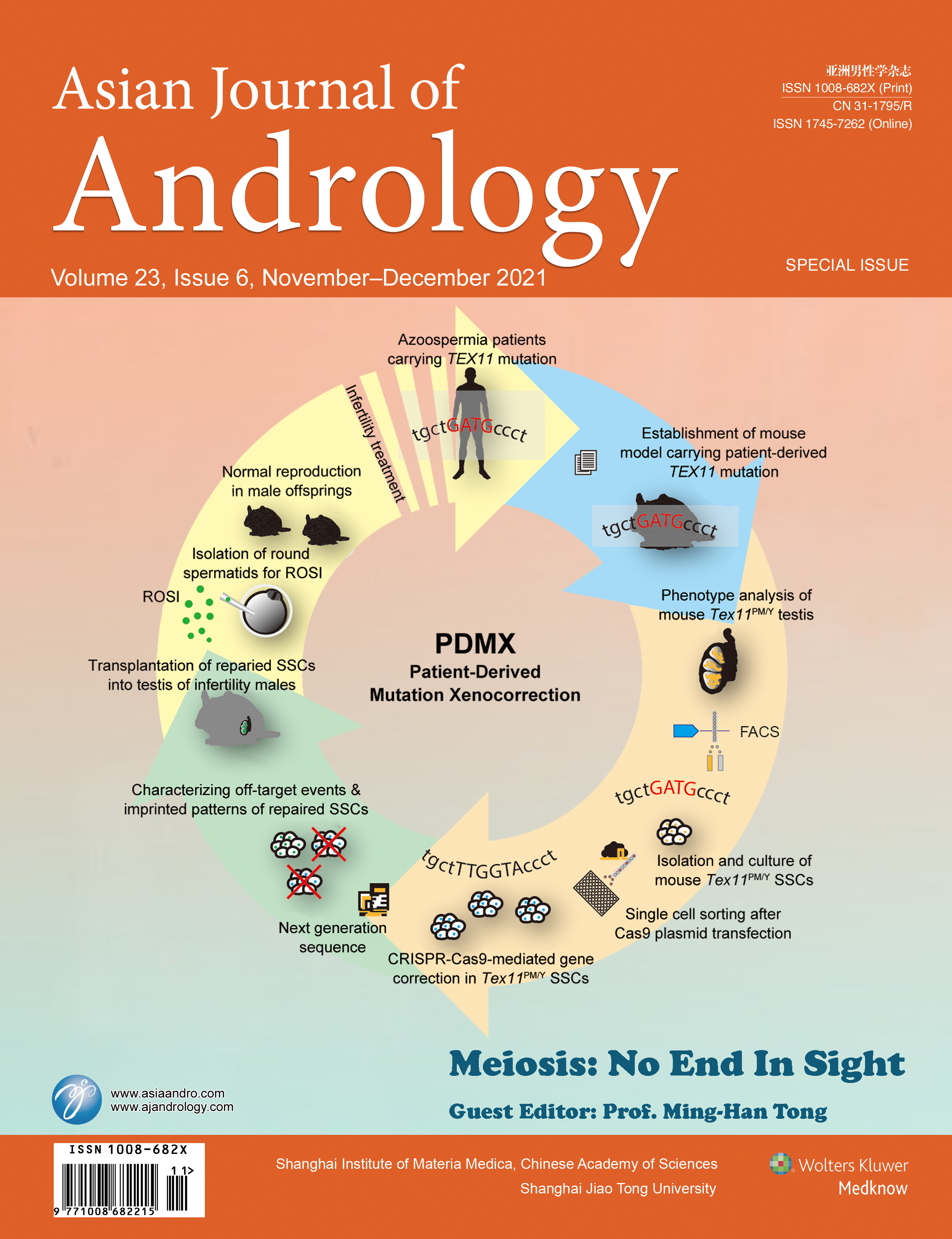
Vol.23 No.6 |
Meiosis: No End In Sight
The fundamental to sexual reproduction and genetics makes meiosis at the central of life science research. This special issue of Asian Journal of Andrology, titled “Meiosis: No End In Sight”, contains seven papers summarizing and reviewing the non-negligible role of meiosis in reproduction. From bench to bedside to bench, the relationship between meiosis and fertility, gene therapy, and its underlying mechanisms were discussed in detail. As highlighted in this issue, advances in research from recent years improved our understanding of mammalian meiosis, yet many outstanding and fascinating questions remain to be explored. Meiotic biology has thus no end in sight. |
| |
|
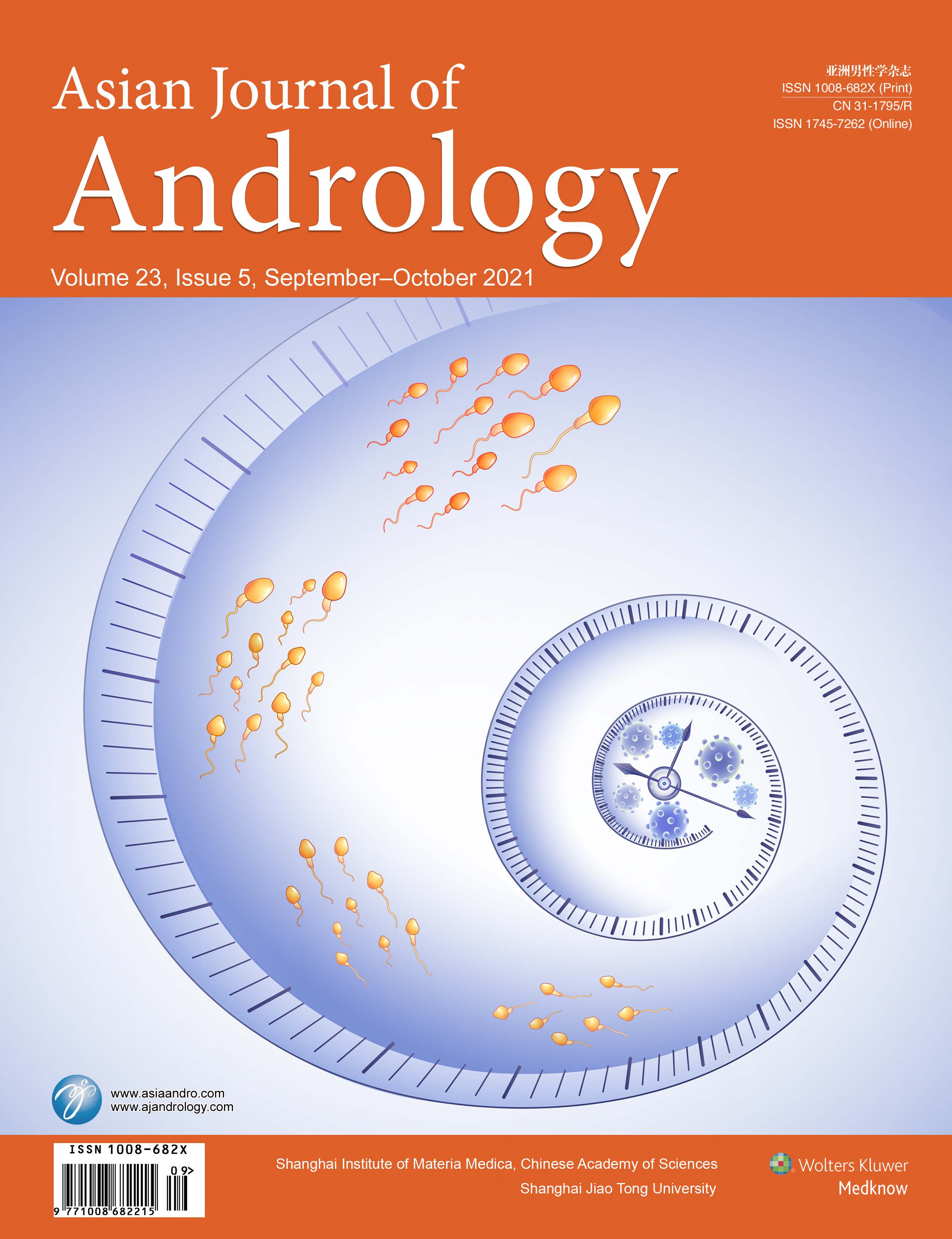
Vol.23 No.5 |
To understand the consequences of COVID-19 on spermatogenesis in humans, semen analyses were performed at different time-points in men recovered from COVID-19. Compared with the controls who did not suffer from COVID-19, sperm concentration, progressive sperm motility, and sperm motility were significantly reduced in patients at the first sampling conducted at a median of 56 days after hospital discharge. Interestingly, total sperm count, sperm concentration, and motile sperm count were significantly increased in the patients at the second sampling conducted at a median of 84 days after hospital discharge compared with those at the first sampling. This study suggests an adverse but potentially reversible consequence of COVID-19 on sperm in humans. Please refer to pages 479–483 for details. |
| |
|
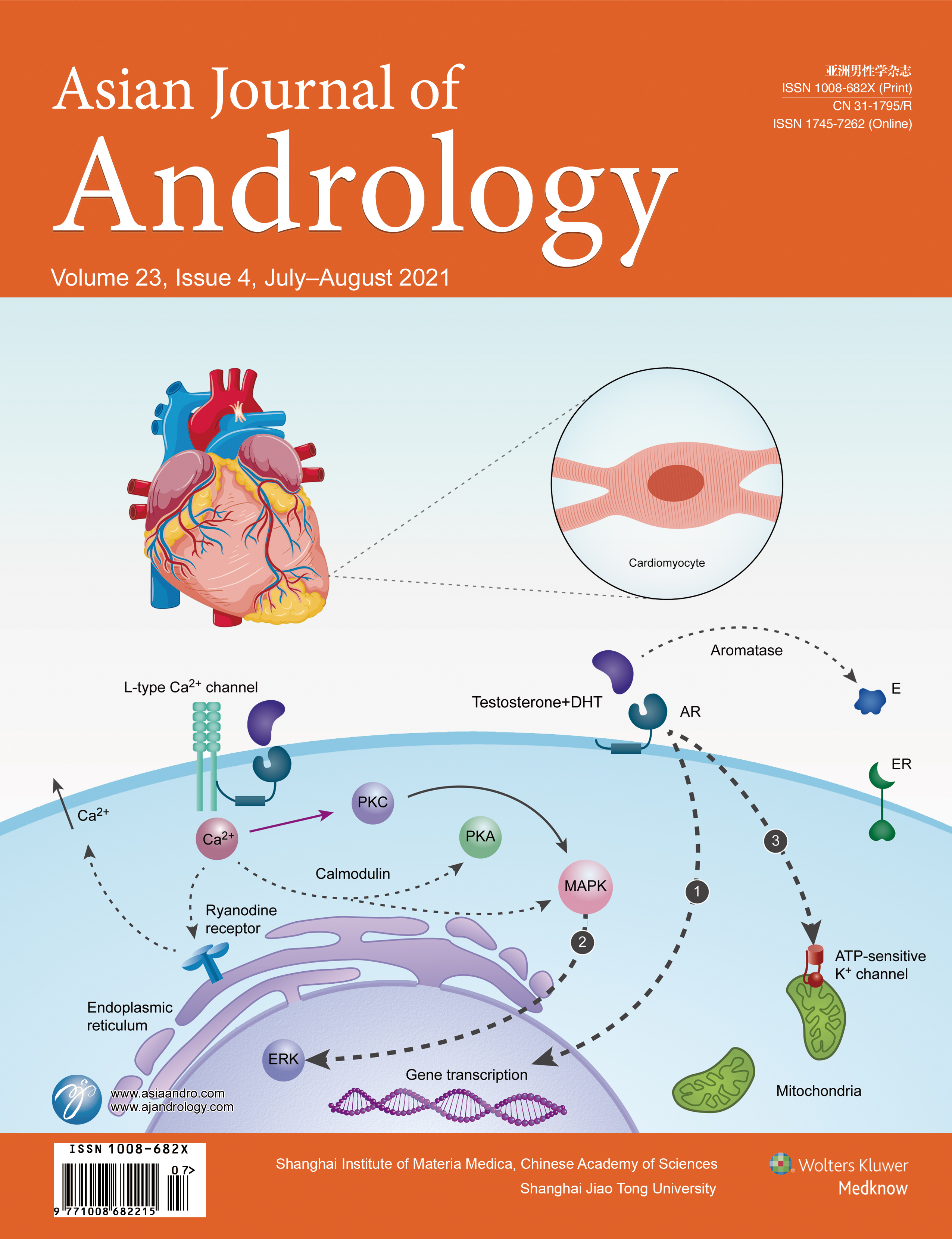
Vol.23 No.4 |
Testosterone, cardiomyopathies, and heart failure
Androgens have several important effects on the cardiovascular system and exert their physiological actions through a genomic mechanism mediated by the androgen receptor and through nongenomic mechanisms. There is a growing body of evidence linking testosterone deficiency to different aspects of cardiovascular pathology, and the effects of testosterone replacement therapy on heart disease is a dynamic area for research. Heart failure is a major cause of hospitalizations and death worldwide and discovering new ways to modulate this disease could significantly impact patient prognosis. Our review focuses on testosterone relationships in heart failure and specific forms of cardiomyopathies. Please refer to pages 348–356 for details. |
| |
|
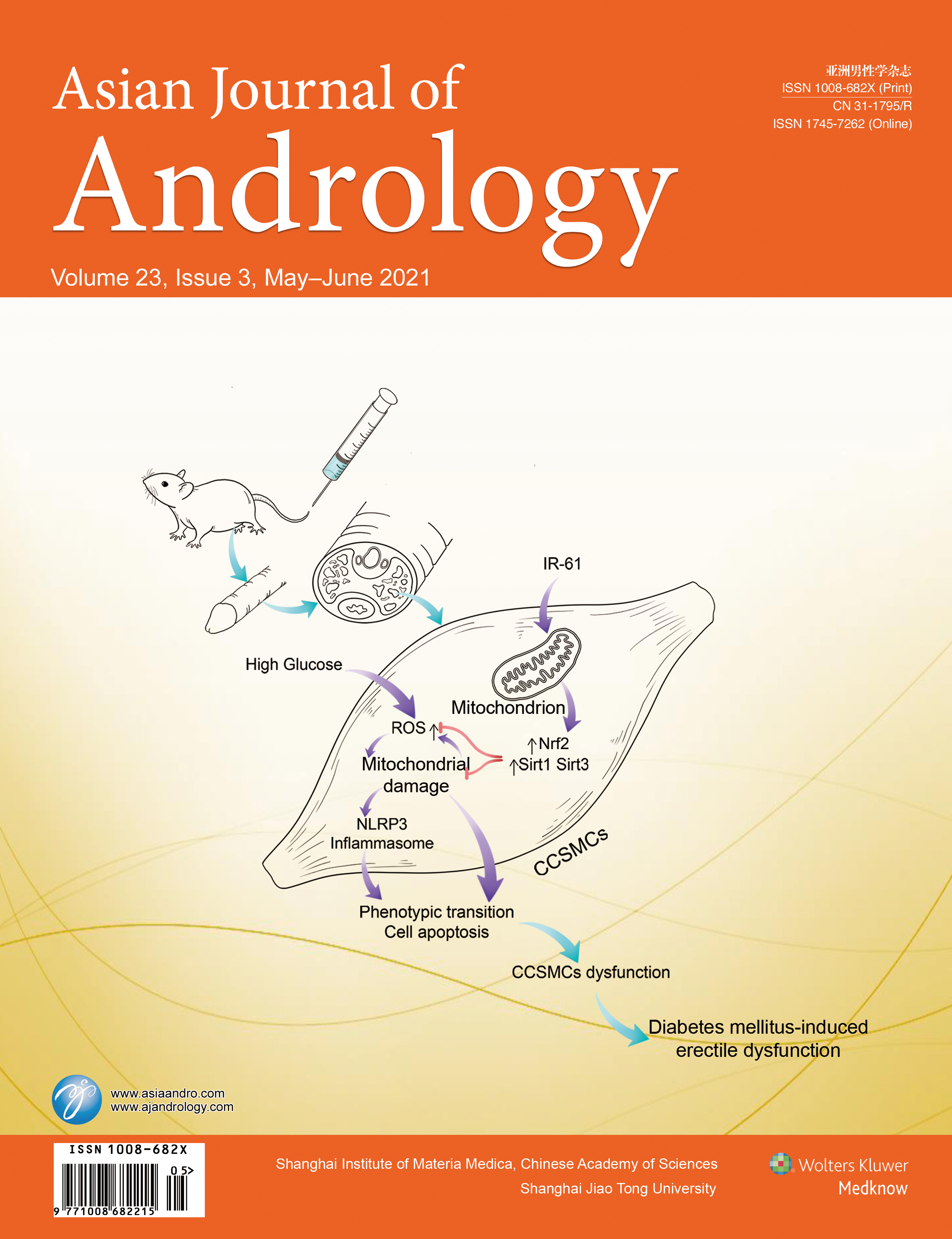
Vol.23 No.3 |
The near-infrared dye IR-61 restores diabetic erectile function
Although the treatment of erectile dysfunction has been well studied, treatment for diabetes mellitus-induced erectile dysfunction (DMED) remains a challenge. In this study, we evaluated the therapeutic effect of IR-61, a novel mitochondrial heptamethine cyanine dye with antioxidant effects, on DMED. Our study suggested IR-61 was highly accumulated in the penis after intravenous injection and improved erectile function of diabetic rats by protecting the mitochondria of corpus cavernosum smooth muscle cells (CCSMCs), which may be mediated by activation of the SIRT1, SIRT3 and Nrf2 pathways. Please refer to pages 249–258 for details.
|
| |
|
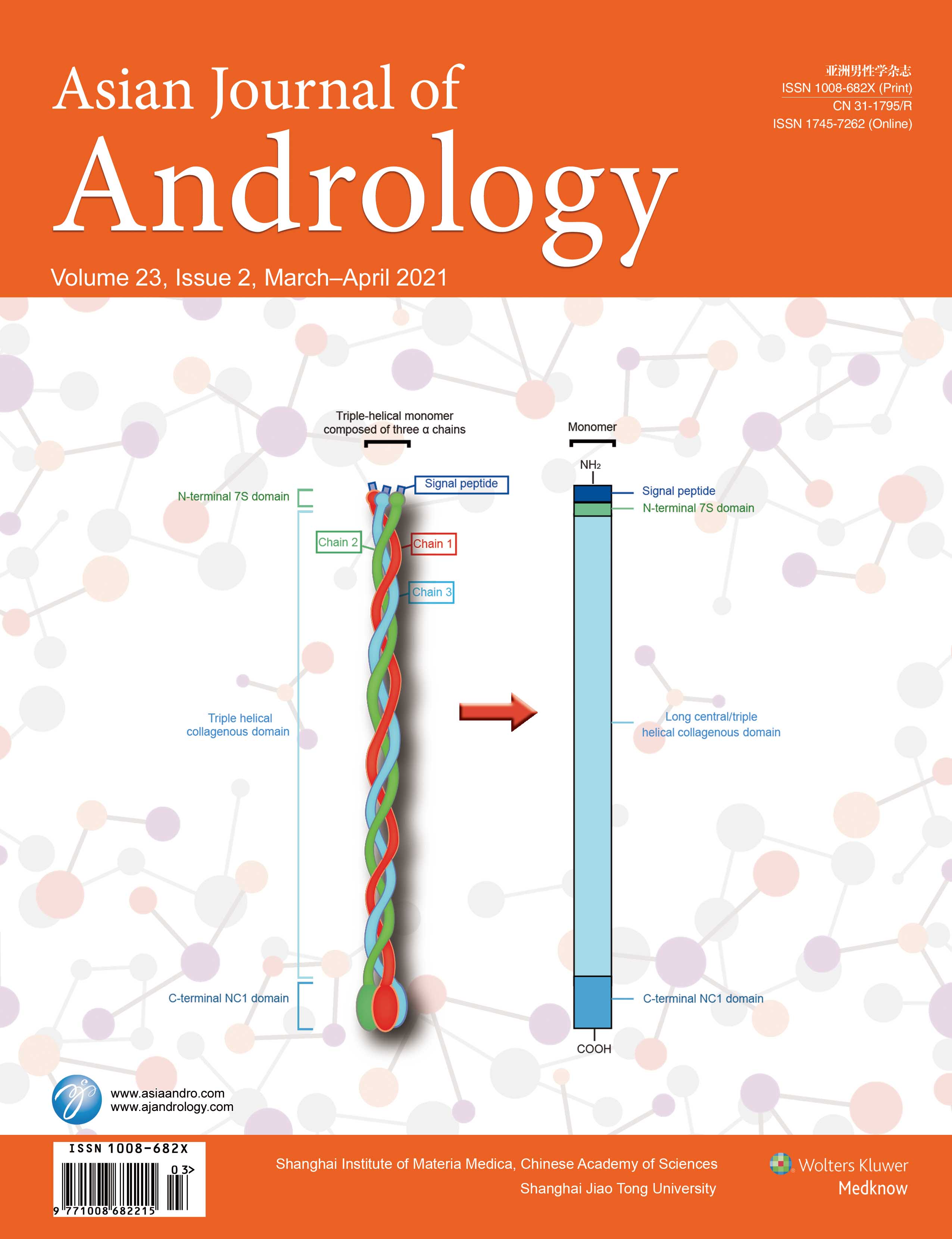
Vol.23 No.2 |
In the testis, spermatogenesis produces millions of spermatozoa daily in adult rodents and men, which takes places in the epithelium of the seminiferous tubules. The base of the seminiferous epithelium is in direct contact with the basement membrane, which is known to support spermatogenesis through mechanism(s) that remain to be elucidated. Studies have shown that noncollagenase (NC1) domain resides near the N-terminus of collagen α3 (IV) chains – one of the constituents of the basement membrane in the testis. Through the action of matrix metalloproteinase 9 (MMP9), NC1 domain released from the collagen chain is a potent bioactive peptide designated NC1-peptide that regulates spermatogenesis. In this review, we summarize results of recent findings, discussing the role of NC1-peptide and its downstream signaling proteins and cascade that regulate spermatogenesis. Please refer to pages 123–128 for details. |
| |
|
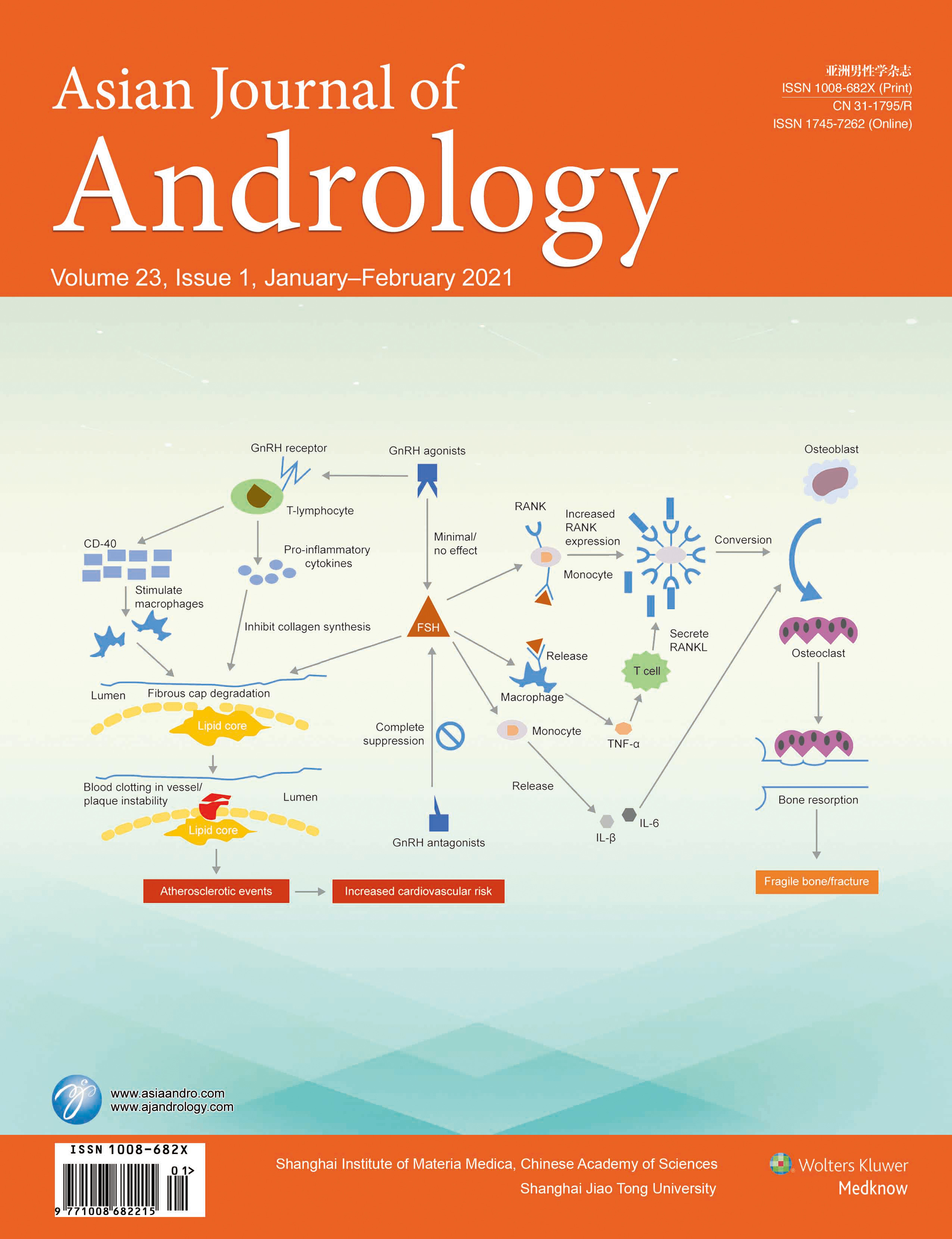
Vol.23 No.1 |
Androgen deprivation therapy (ADT), while potentially life prolonging when used in the correct setting, is known to have multiple side effects. This figure highlights the various biological mechanisms by which ADT can lead to increased risk of cardiovascular disease and osteoporosis. Moreover, this figure highlights some potential reasons to think that the risks may differ for GnRH (LHRH) agonists vs antagonists. Please refer to pages 3–10 for details.
|
| |
| 2020 |
|
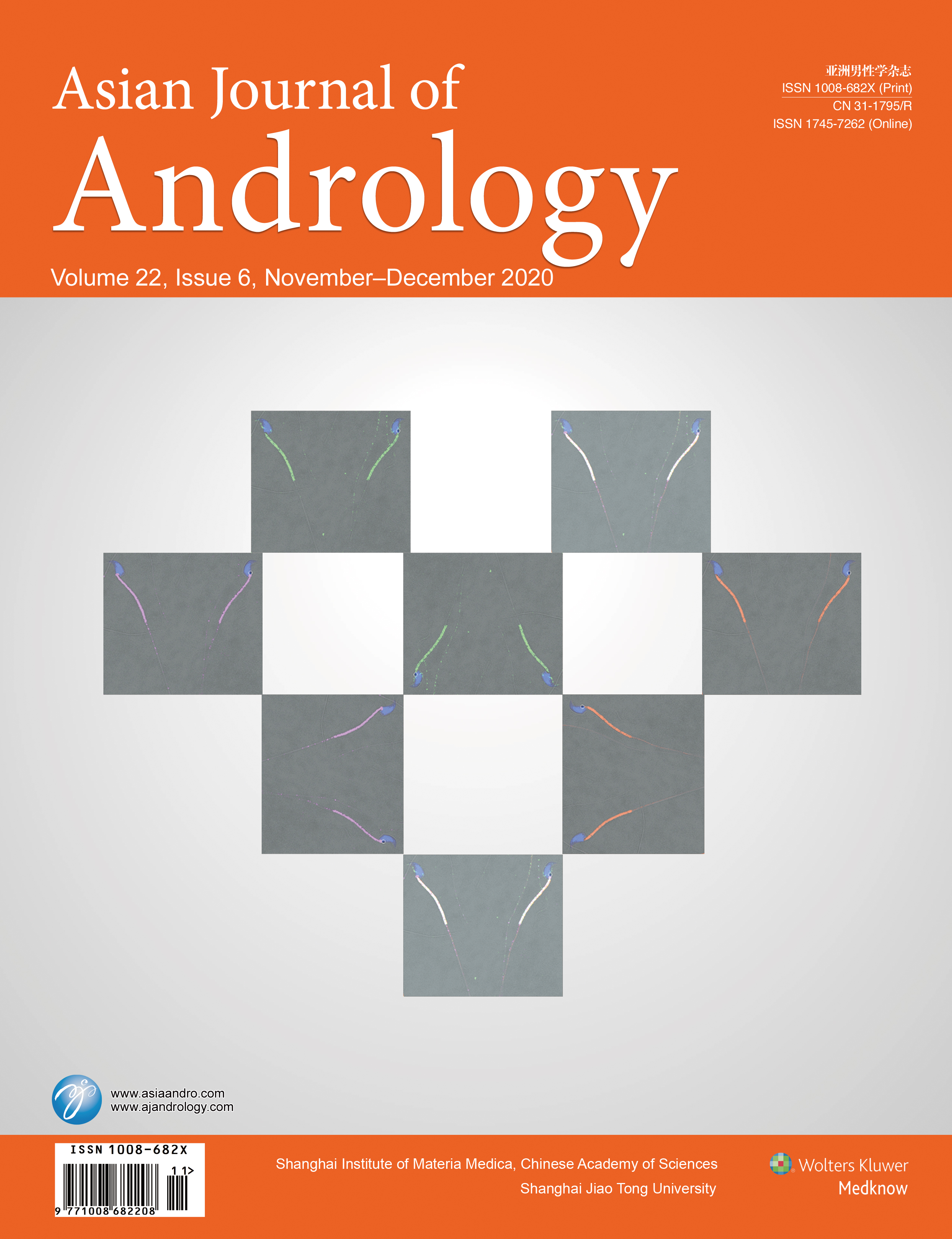
Vol.22 No.6 |
Prohibitin interacts with AKT to modulate sperm motility
Prohibitin (PHB) is an evolutionarily conserved mitochondrial inner membrane protein. Recently, we demonstrate that mitochondrial PHB expression plays a role in sperm motility. However, the mechanism of PHB-mediated regulation of sperm motility remains unknown. Here we demonstrate for the first time that PHB interacts with AKT and exists in a complex with phospho-PHB (pT258) and phospho-AKT in the mitochondrial sheath of murine sperm. Moreover the interaction of PHB with AKT in the mitochondrial sheath is critical for sperm motility, where PHB phosphorylation level (pT258) and PI3K/AKT activity are key regulatory factors. Please refer to pages 583–589 for details.
|
| |
|
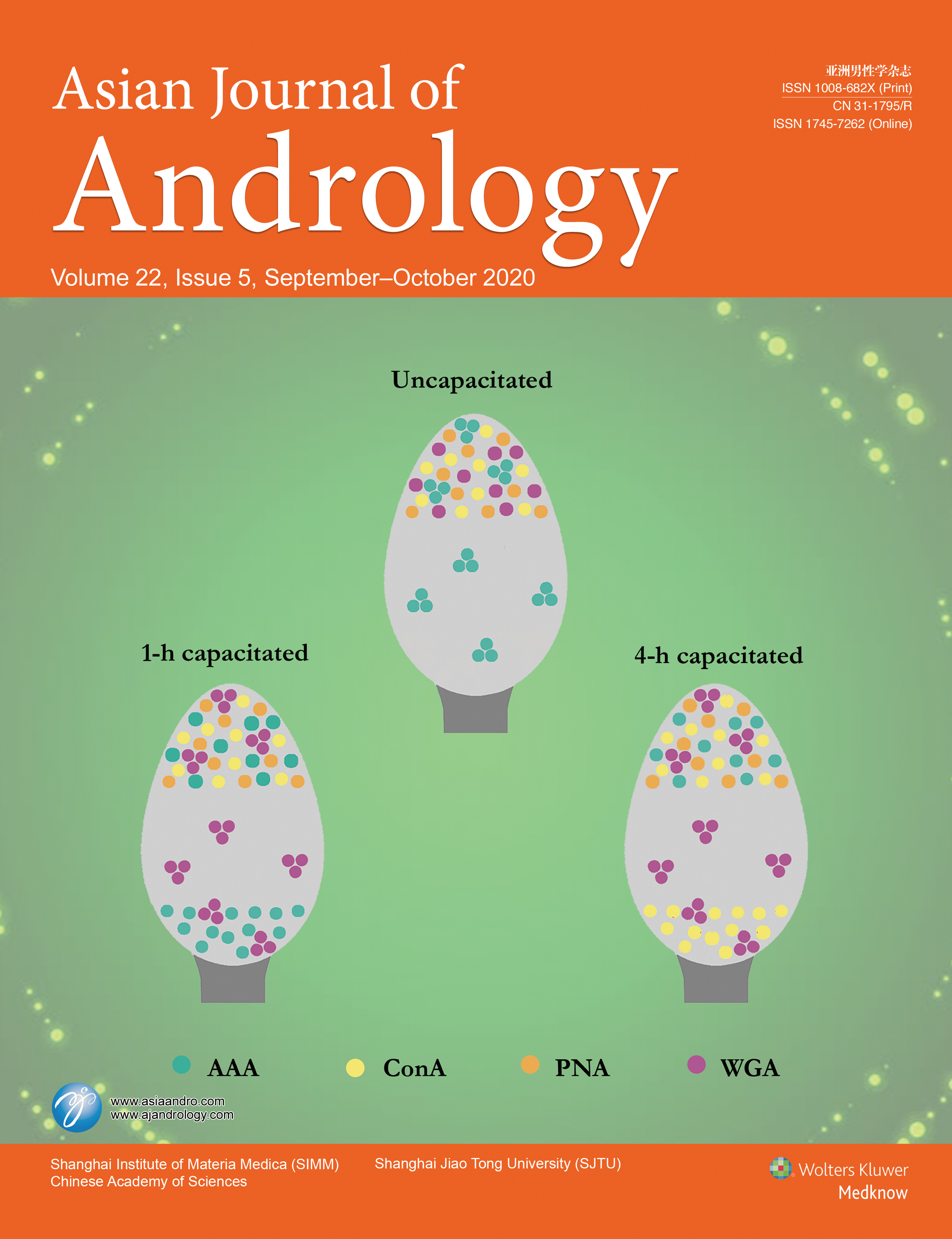
Vol.22 No.5 |
Surface sugars redistribution in human spermatozoa during capacitation
The glycoconjugates on the spermatozoa’s surface are reorganized considerably during capacitation, preparing for the interaction with the zona pellucida and the oolema of the oocyte. However, due to the high heterogeneity of the human spermatozoa glycocalyx, sugar patterns and their reorganization during capacitation remain poorly defined. Here, we have characterized the detailed reorganization patterns and the heterogeneity of the sugars recognized by the Aleuria aurantia agglutinin (AAA), Concanavalin A (ConA), Peanunt agglutinin (PNA), and Wheat germ agglutinin (WGA) lectins after one and four hours of capacitation in the human spermatozoa glycocalyx. Please refer to pages 447–453 for details.
|
| |
|
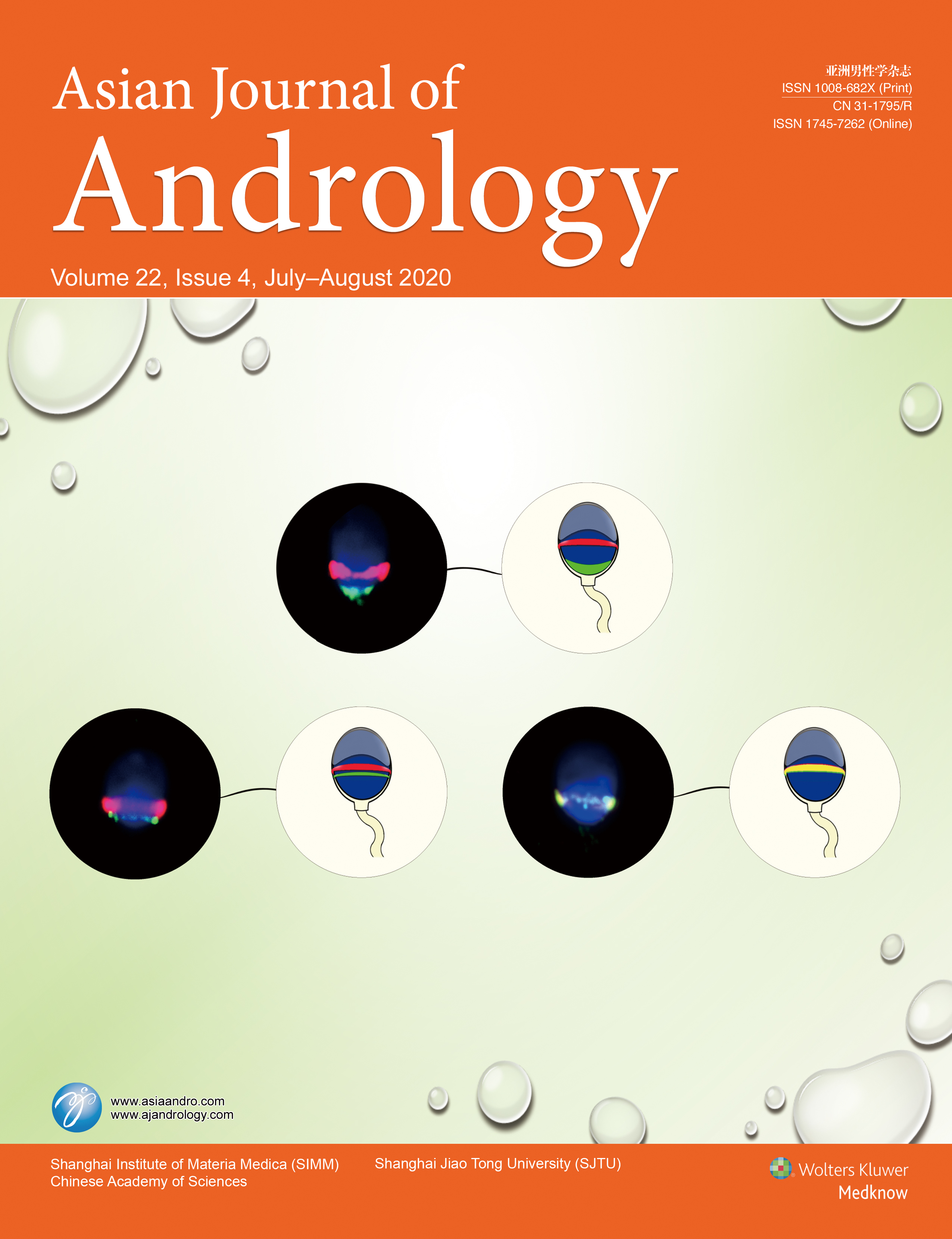
Vol.22 No.4 |
Distribution of DNA damage in the human sperm nucleus
Human sperm chromatin contains two structural domains commonly considered as susceptible to DNA damage: the nucleosomal domain, associated with histones and the MAR domain, associated with nuclear matrix proteins. Using a qPCR approach, we demonstrated that the number of lesions promoted in different genes depends on the genotoxic agent and not on their location on a particular domain. Immunodetection of 8-OHdG after H2O2 treatment confirmed that oxidative lesions did not colocalize with histone 3 neither with type IIα + β topoisomerase, but matched perfectly with peroxiredoxin 6, involved in H2O2 metabolism. Results reveal that the head architecture, driving the access of the genotoxicants, highly contributes to the differential susceptibility of nuclear areas, the chromatin packaging playing a minor role. Please refer to pages 401–408 for details. |
| |
|
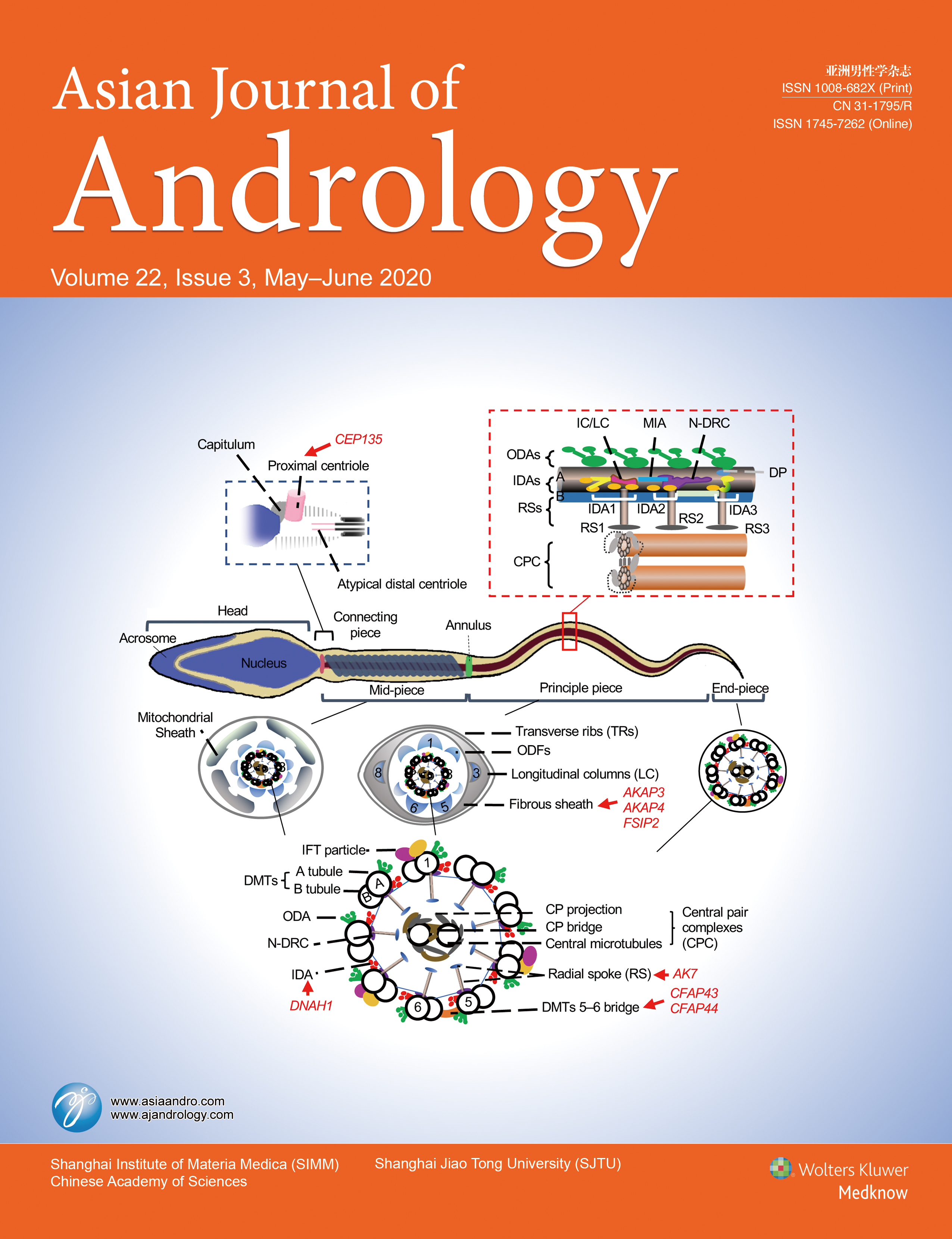
Vol.22 No.3 |
Multiple Morphological abnormalities of sperm flagella
Multiple morphological abnormalities of the sperm flagella (MMAF) is a specific kind of asthenoteratozoospermia characterized by a combination of aberrant flagellar phenotypes (absent, short, angulated, and irregular flagella). MMAF was proposed in 2014 and has attracted increasing attention; however, it has not been clearly understood. In this review, we elucidate the definition of MMAF from a systematical view, the difference between MMAF and primary ciliary dyskinesia, the knowledge regarding its etiological mechanism and related genetic findings, and the clinical significance of MMAF for ICSI and genetic counseling. Please refer to pages 236–245 for details. |
| |
|
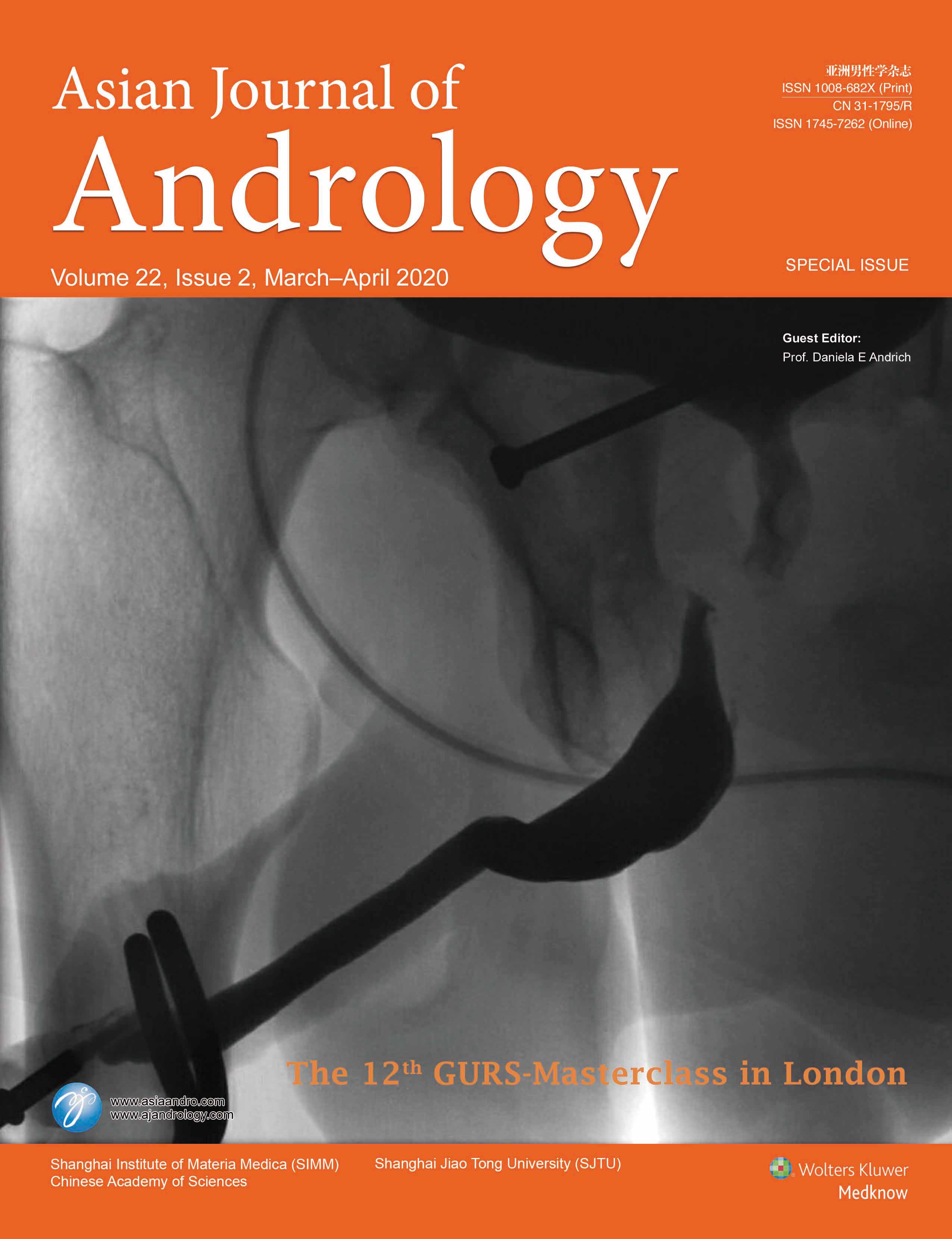
Vol.22 No.2 |
The 12th GURS-Masterclass in London
Reconstructive Urological Surgery is a fast-evolving field that includes highly complex surgical techniques which are difficult to learn outside expert centres and involve a high degree of individualised decision making for increasingly complex patients. For Urologist and Andrologists practising in this speciality, the annual Genitourinary Reconstructive Surgeons (GURS)-Masterclass in London offers a unique opportunity to interact with experts in the field over a three-day event through state-of-the-art lectures and live-surgery of urethral and genital reconstruction. In this special issue of Asian Journal of Andrology, speakers of the 12th GURS-Masterclass have written up the topic of their lecture for deeper insights and understanding to allow a wider audience to participate in the debates. |
| |
|
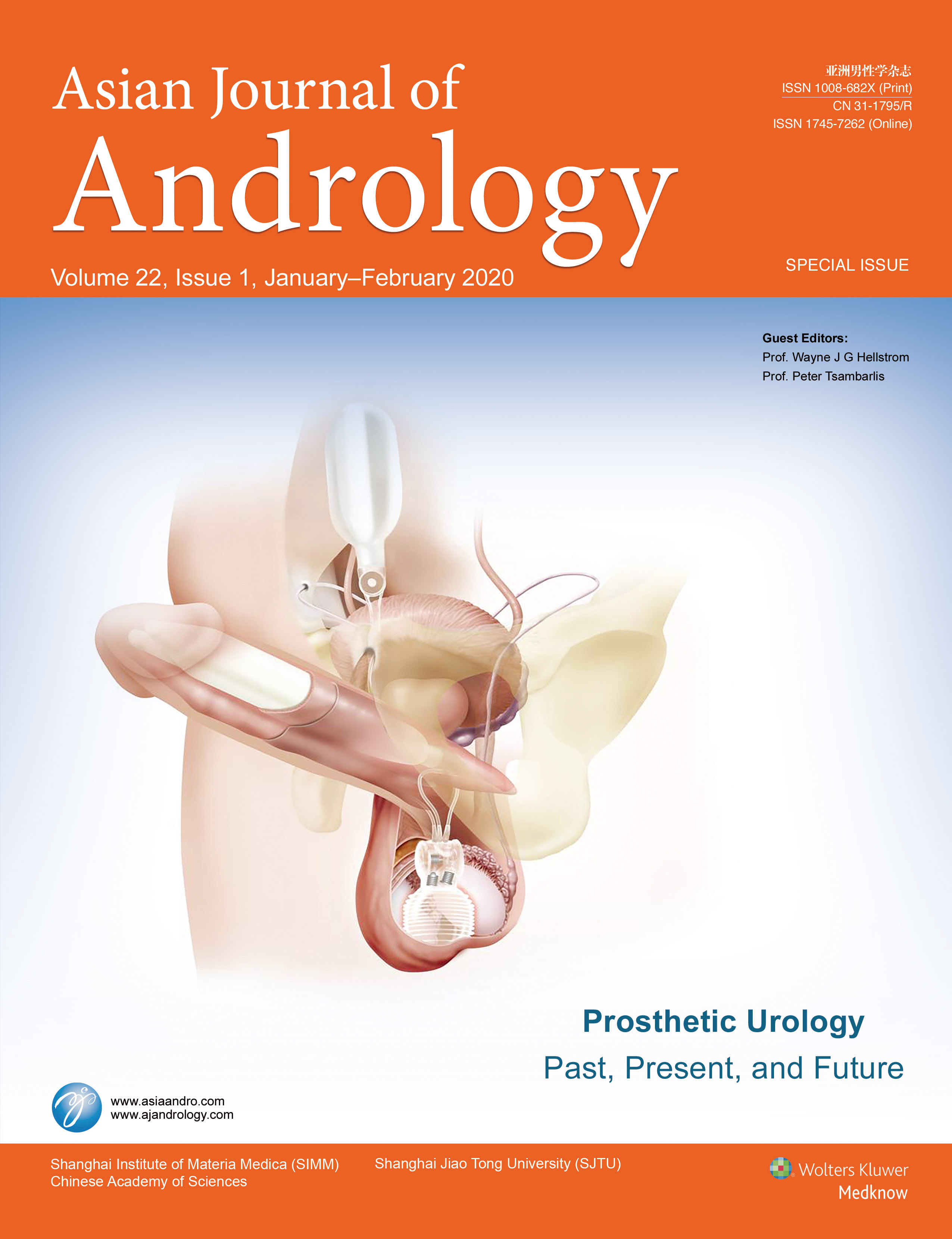
Vol.22 No.1 |
Prosthetic Urology: Past, Present, and Future
The three-piece inflatable prosthesis and the artificial urinary sphincter are currently considered gold standards for the treatment of refectory erectile dysfunction and significant stress urinary incontinence. On the market for over 40 years, more than 500000 prostheses have been implanted. Both devices offer restorative therapies to a physically and psychologically damaging problem. There has been a gradual evolution with small but meaningful changes in both devices. This special AJA issue aims to expand our understanding of these devices and anticipates future innovations. We discuss both technological and procedural advances with the goal of providing optimal care for our increasingly complex patients. |
| |
| 2019 |
|
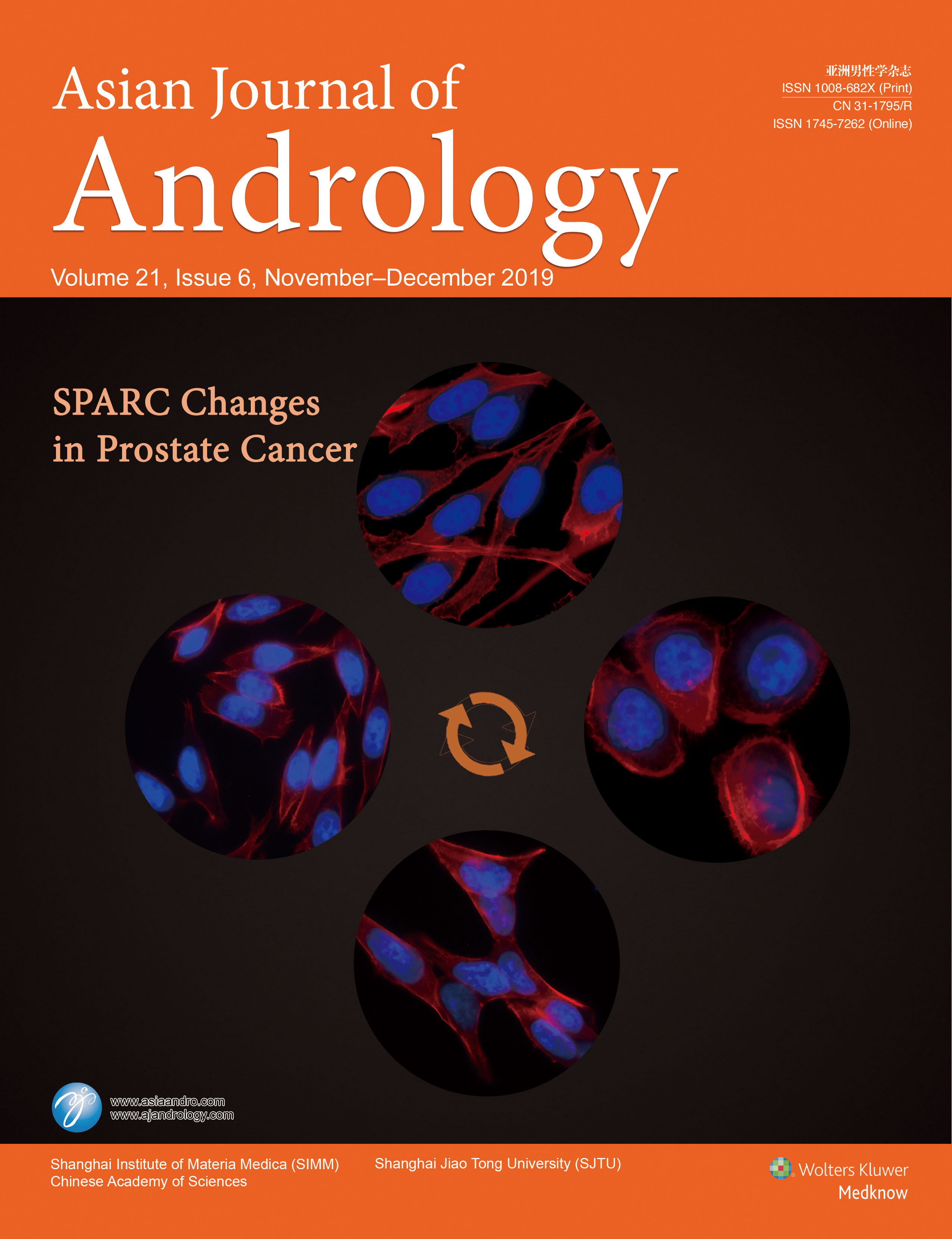
Vol.21 No.6 |
Secreted protein acidic and rich in cysteines (SPARC) is a matricellular protein highly expressed in bone tissue that has been described as a chemoattractant factor promoting the arrival of prostate cancer cells to the bone marrow. However, there is no consensus regarding its contribution during the early stages of tumor progression. In this cover, we show that the knockdown of SPARC in prostate cancer cells changes the fusiform shape, typical of mesenchymal cells, to a more polygonal and larger one, which is consistent with an epithelial morphology. In our work, we found that SPARC induces several other changes in the molecular, morphological and functional characteristics of prostate cancer cells, associated with the epithelial-mesenchymal transition program. Please refer to pages 557–564. |
| |
|
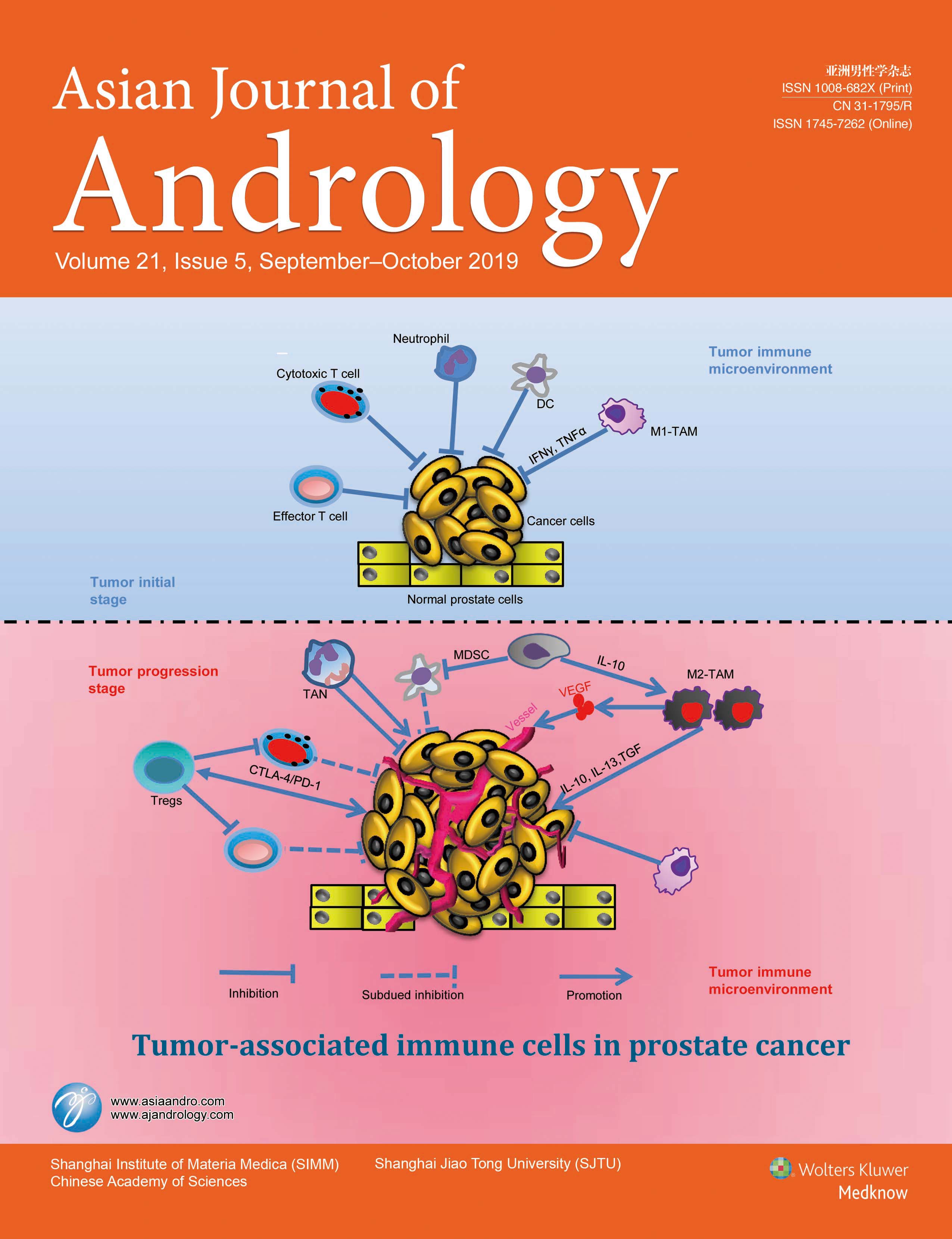
Vol.21 No.5 |
Tumor-associated immune cells in prostate cancer
Prostate cancer is the most common malignancy in the reproductive system of older males. Although emerging approaches have been developed for the treatment of prostate cancer, most of prostate cancer patients still unavoidably progress to the therapeutic resistance stage. Recent studies have shown that tumor-associated immune cells play major roles in the initiation, progression, and metastasis of prostate cancer. Various phenotypes of tumor-associated immune cells have tumor-promoting or antitumor functions mediated by interacting with tumor cells. Even tumor-associated immune cells derived from the same origin can play various roles in different stages of prostate cancer. Here, we review the current knowledge of tumor associated immune cells in the development of prostate cancer. Please refer to pages 433–437.
|
| |
|
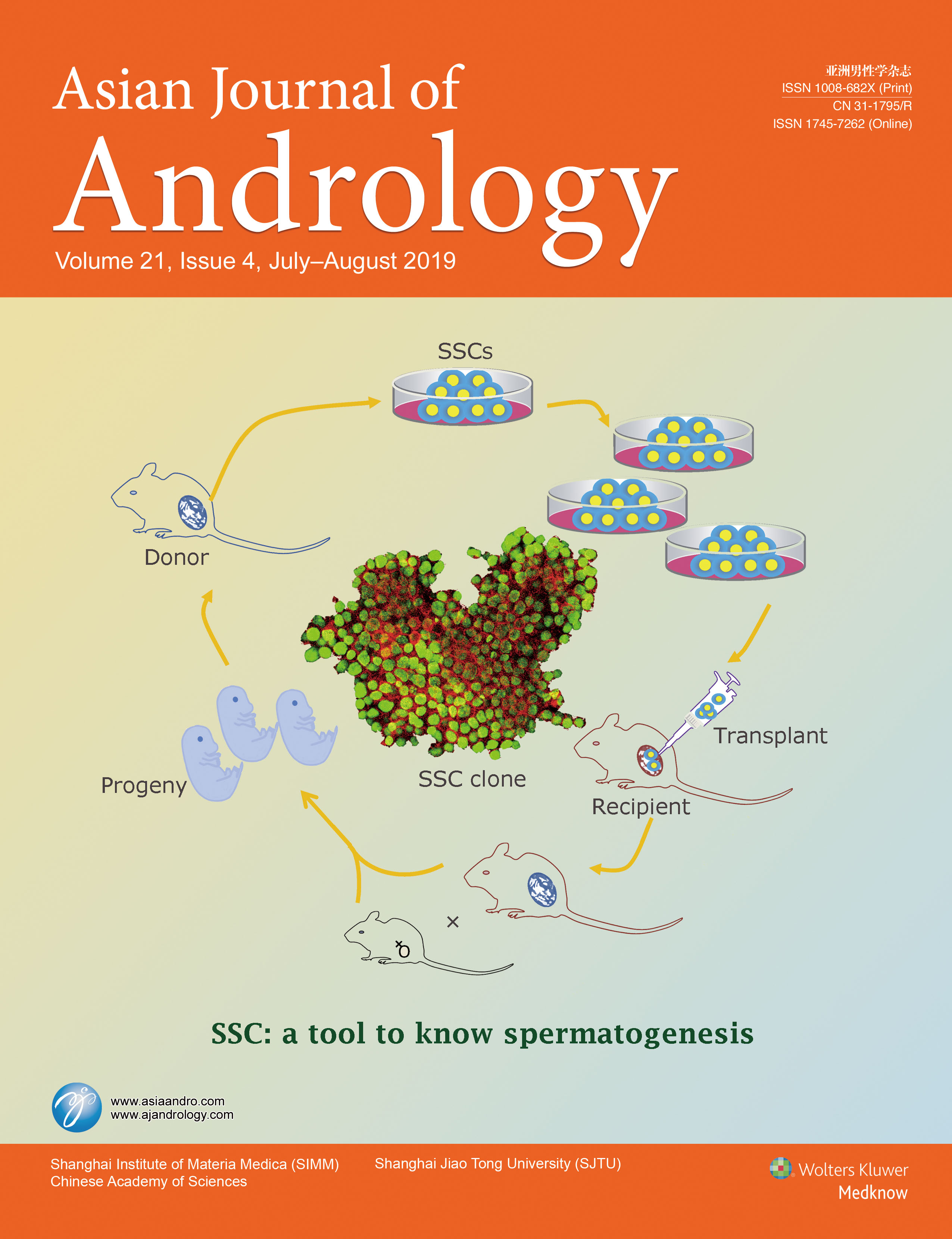
Vol.21 No.4 |
SSC: a tool to know spermatogenesis
Spermatogonial stem cells (SSCs) are required to maintain the whole spermatogenesis throughout the reproductive life of mammals. The identification of exogenous factors that contributed to continuous proliferation of SSCs in vitro constructs the foundation to investigate the basic characters of SSCs. Indeed, SSCs culture and transplantation provide a powerful model to clarify the mechanisms regulating SSC self-renewal and spermatogenesis, and elicit new insights into the treatment of male infertility. In this study, by using cultured mouse neonatal testes and SSCs, we identified a new factor, Strawberry Notch 1 (SBNO1), which could maintain SSCs by promoting the noncanonical Wnt pathway. Please refer to pages 345–350.
|
| |
|
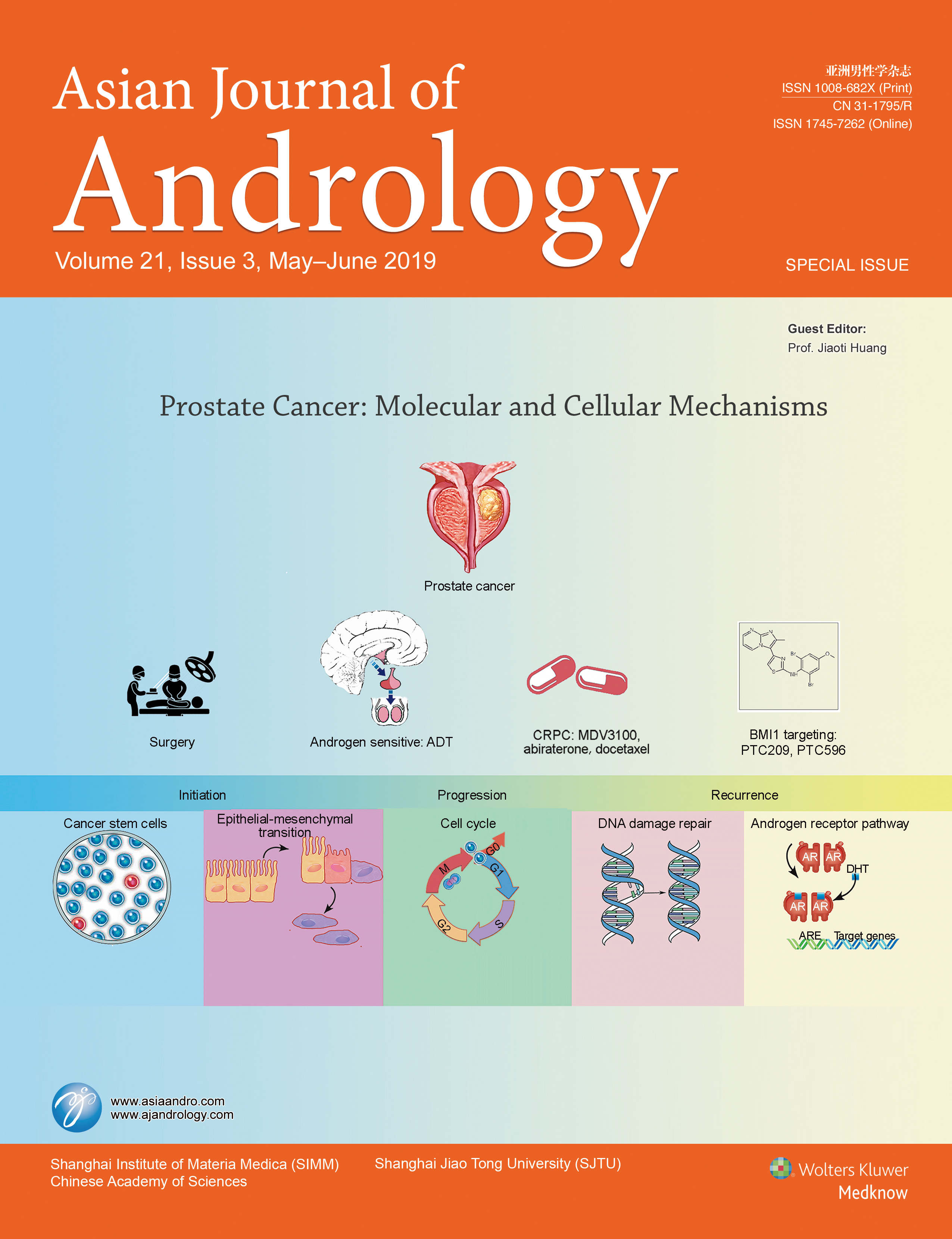
Vol.21 No.3 |
SPECIAL ISSUE: PROSTATE CANCER: MOLECULAR AND CELLULAR MECHANISMS
Prostate cancer: molecular and cellular mechanisms
This special issue contains a number of different articles dealing with many different molecular and cellular aspects of prostate cancer and we promise this to be a highly informative and stimulating issue for readers who are interested in prostate cancer and cancer in general. It is our belief that novel, innovative treatment strategies will only result from better understanding the disease biology and pathology, and future success will likely come from molecular approaches beyond directly targeting androgen receptor alone. |
| |
|
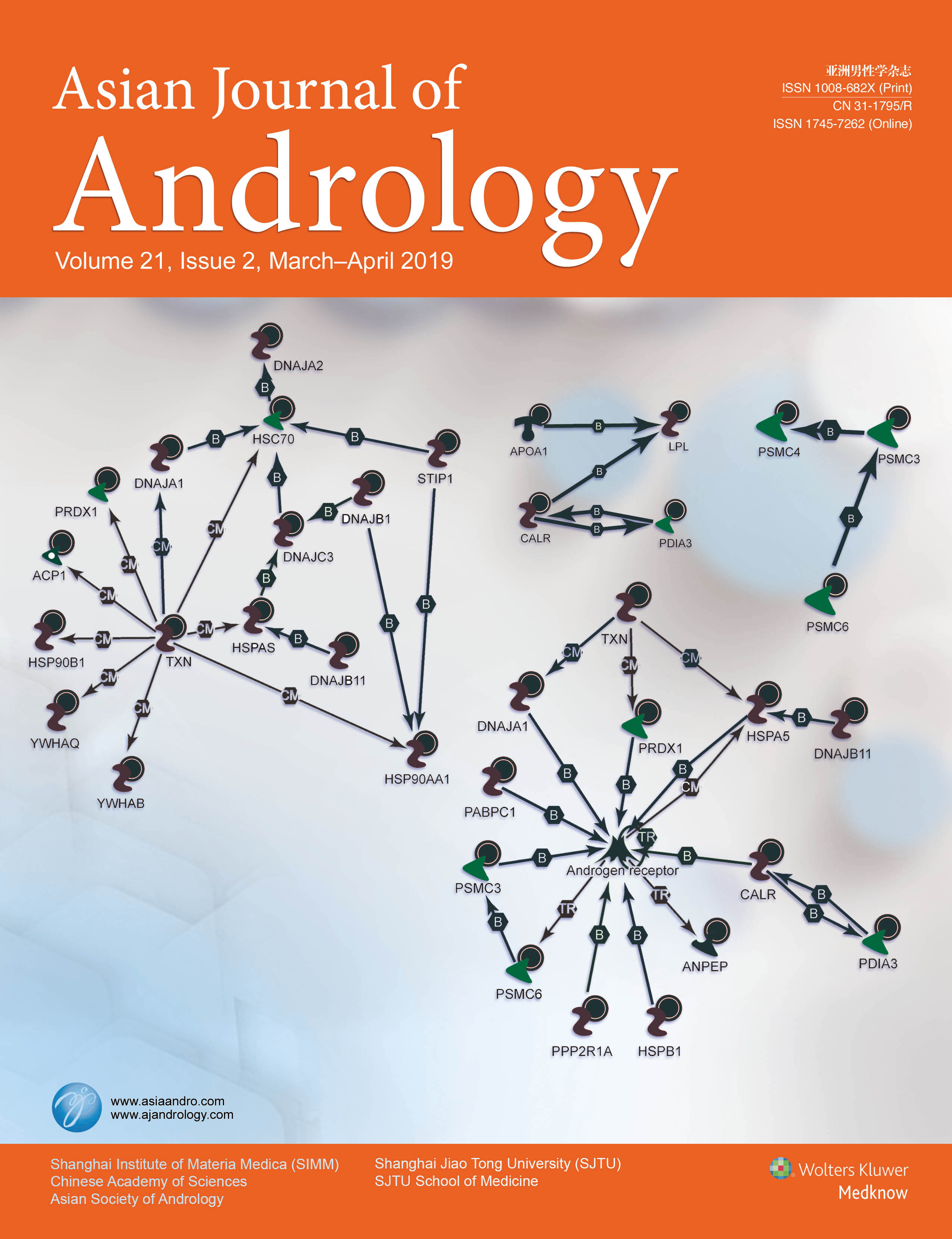
Vol.21 No.2 |
The cover page depicts molecular networks of DEPs generated by Metacore software using a transcription regulation algorithm in immature and mature spermatozoa proteins of infertile men. These proteins were obtained from a three-layer density gradient and analyzed on an LTQ-Orbitrap Elite hybrid mass spectrometer system. Four fractions of spermatozoa (F1-F4); fraction F1 displaying the least mature stage and having the lowest density whereas fraction F4 included the highest density and morphologically mature spermatozoa. The different molecular networks of DEPs were ranked by a value and then gene ontology was used for interpretation. The Metacore pathway analysis predicted the androgen receptor as the major pathway. Chaperone-mediated stress response, sperm function, proteosomal pathway and impaired androgen receptor signaling were identified in the spermatozoa of infertile men. These proteins shed light on the aberrant chaperone expression that may be a contributory factor for defective sperm function and in turn responsible for male infertility. |
| |
|
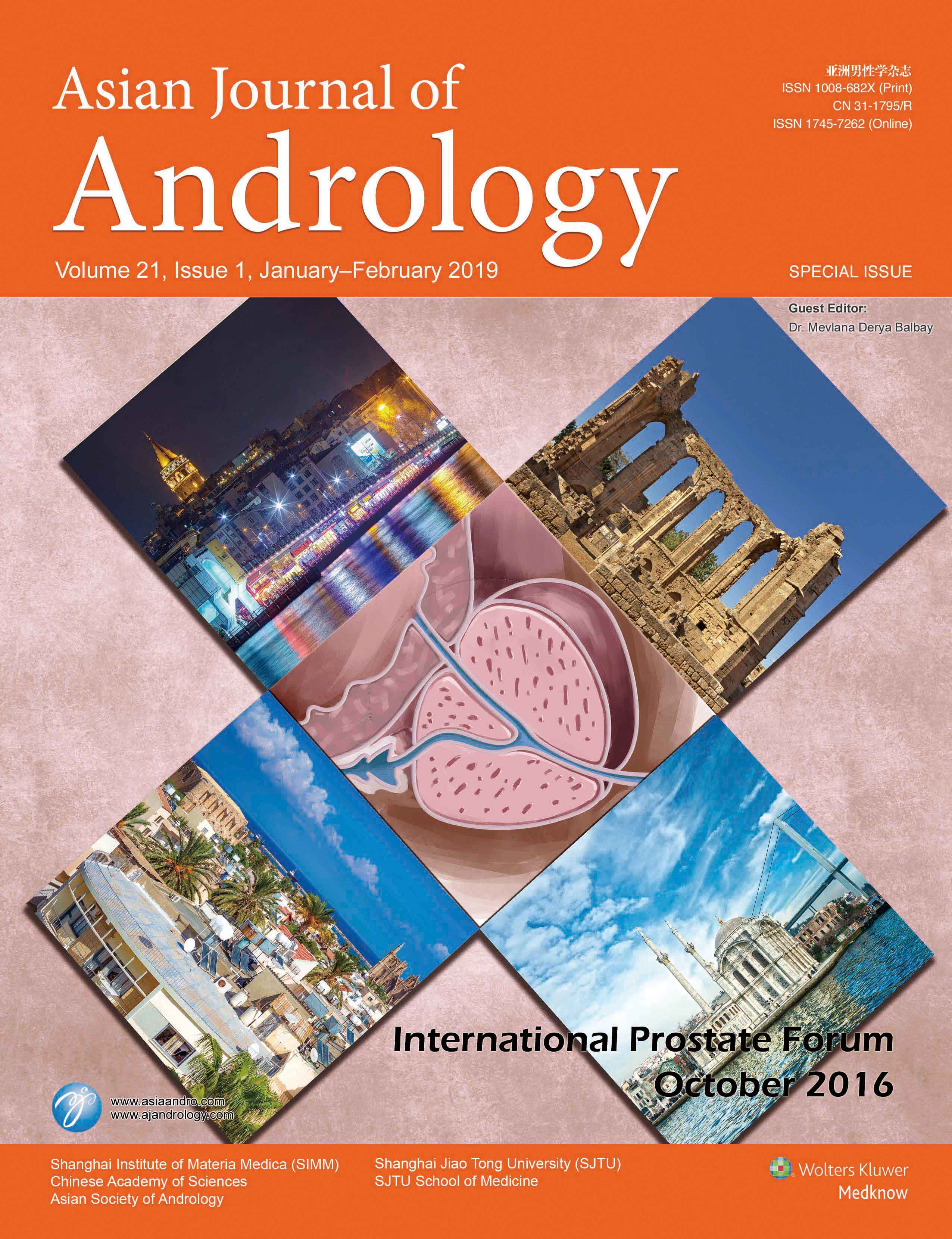
Vol.21 No.1 |
The International Prostate Forum
The 14th International Prostate Forum was held in Kyrenia, Turkish Republic of North Cyprus as a joint meeting with 25th Turkish Urological Association national meeting. All areas related to prostatic diseases both benign and malignant had been discussed in this forum, including epidemiology, diagnostics and therapeutic aspects. There were also case discussion sessions, all of which had drawn very much attention. Worldwide prominent physicians from USA and Europe had participated in this forum and more than 700 physicians had attended. In addition to scientific information exchange, participants had the opportunity to visit historic places, such as Gothic ruins of St John, Famagusta, and Lala Mustafa Pasha Mosque (St. Nicholas Cathedral) as shown in the cover. |
| |
| 2018 |
|
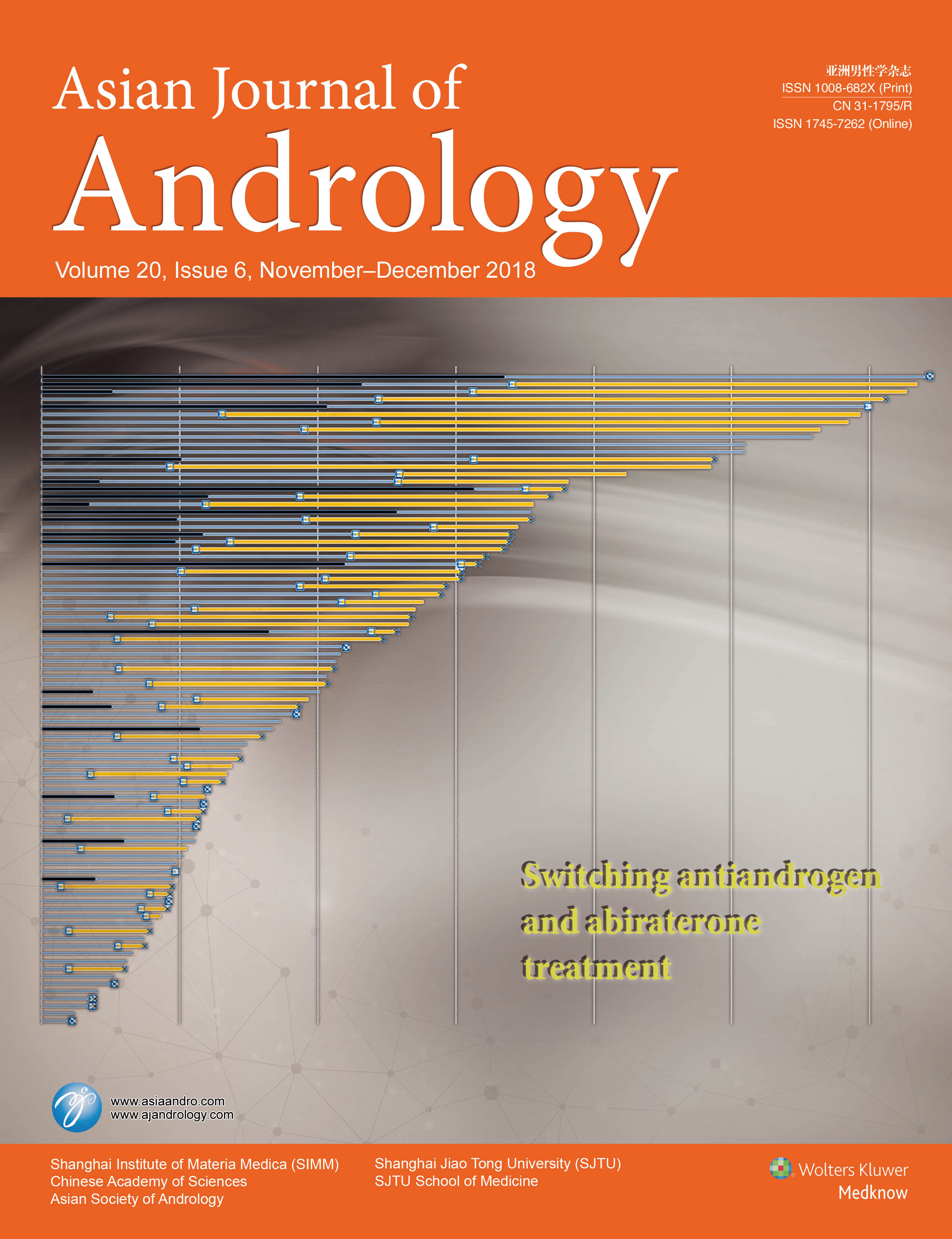
Vol.20 No.6 |
Metastatic castration-resistant prostate cancer (mCRPC) is the end stage of prostate cancer. Even in the era of novel targeted agents, the switching from one non-steroidal antiandrogen (NSAA) to another, as one of the earliest therapeutic strategies for mCRPC patients, is still widely used, especially for patients from medical-care undeveloped countries. It remains unknown whether the prior treatment with a second-line NSAA would impact the treatment efficacy of abiraterone. In this study, we found that the use of flutamide as a second-line NSAA before abiraterone has no adverse effect on the therapeutic efficacy of the sequential abiraterone treatment in mCRPC patients. Survival analyses indicated that regarding abiraterone treatment, patients firstly treated with second-line flutamide had almost the same PSA progression-free survival, radiographic progression-free survival, overall survival, and PSA response rate as those directly receiving abiraterone after being diagnosed with mCRPC. Please refer to pages 545–550 for details. |
| |
|
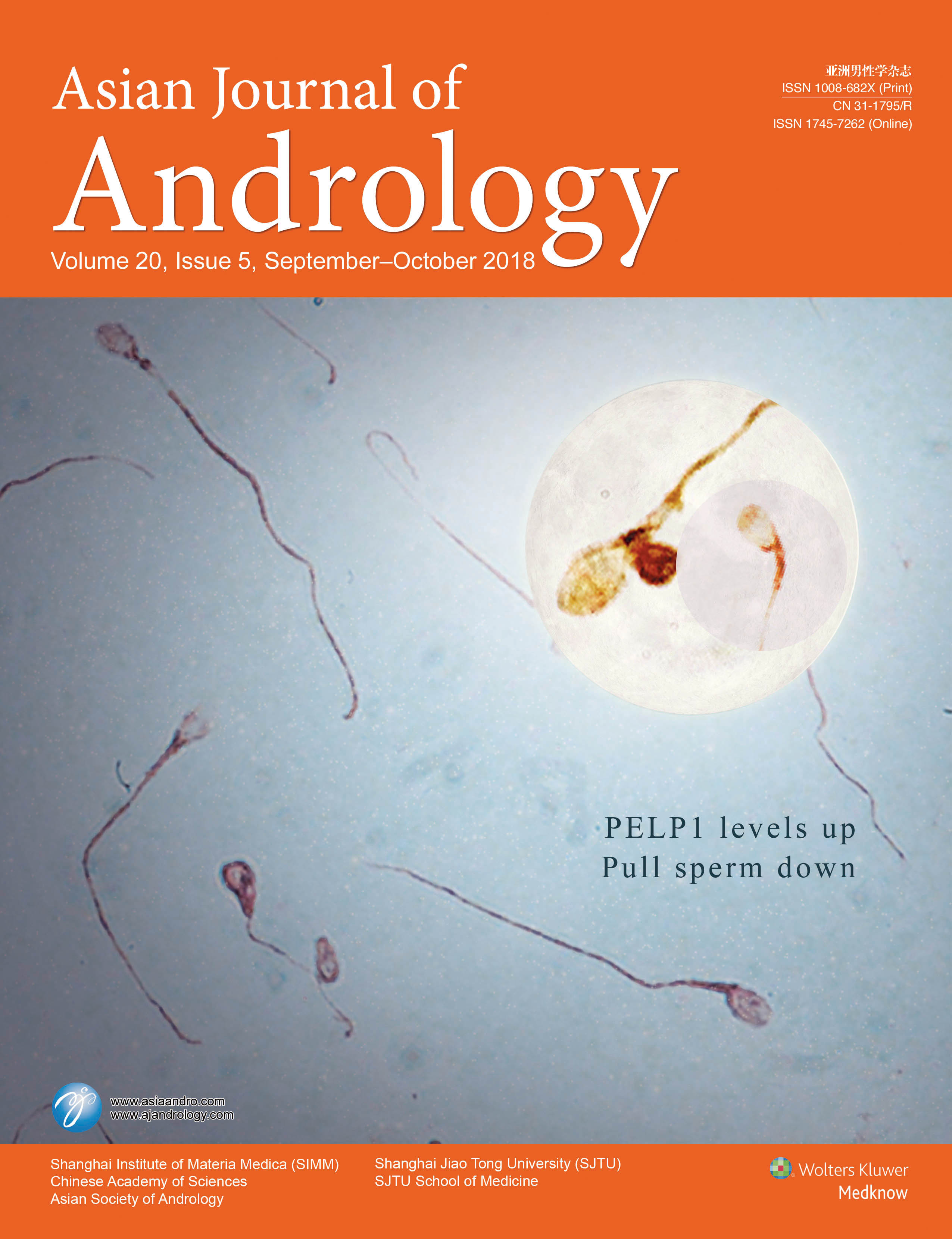
Vol.20 No.5 |
Standard semen parameters may no longer be plausible sperm biomarkers. For this reason, other, such as the expression patterns of sperm RNAs and protein, need to be evaluated instead. This study aimed to gain insight into molecular sperm defects which may lead to conception failure. The assessment of PELP1 may be a time-saving method used to obtain information about sperm quality. The presence of mRNA, protein, and cellular localization of PELP1 in ejaculated spermatozoa was confirmed. Moreover, flow cytometry analysis showed that the percentage of sperm cells stained with PELP1 antibody is negatively correlated with increasing sperm quality. The results suggest that PEPL1 may as well be utilized as an indicator of sperm quality and also an additional biomarker useful in the evaluation of male infertility. Please refer to Pages 425–431 by Skibinska et al. for details. (Artwork is displayed by Xiang Chen) |
| |
|
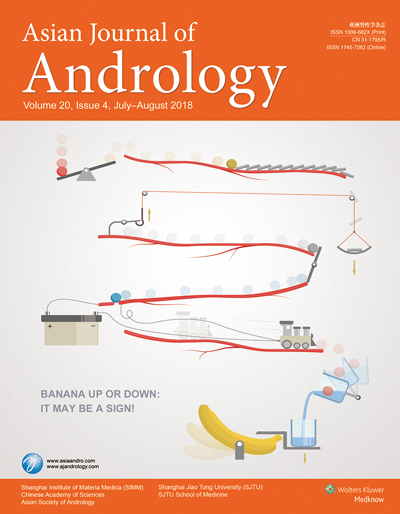
Vol.20 No.4 |
Assessment of erectile dysfunction (ED) may help identify early atherosclerosis in men, because ED has been observed several years before coronary symptoms and assumed to be an independent marker of cardiovascular disease risk. This study aimed to gain insight into
the underlying pathogenesis of ED in young men under the age of 40 years without widely‑known risk factors. For young men with normal results from physical examination, those with relatively high carotid intima–media thickness and homeostatic model assessment index, and relatively low flow mediated vasodilation have a higher risk of ED. The results suggest ED may appear before the detection of traditional cardiovascular risk factors and may be the earliest clinical sign
of subclinical cardiovascular disease. Please refer to pages 400–404 by Yao et al. for details. (Artwork is displayed by Xiang Chen) |
| |
|
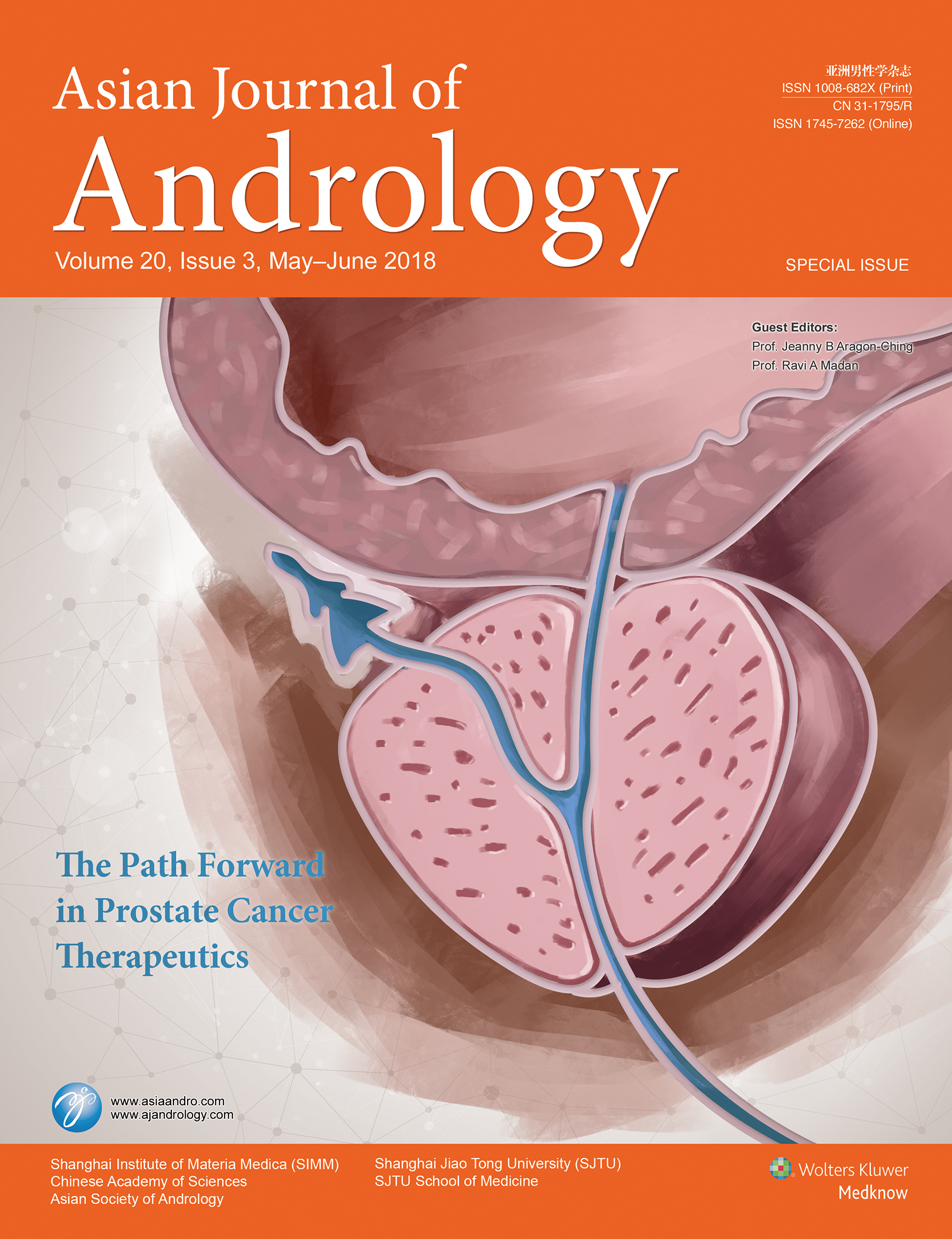
Vol.20 No.3 |
The Path Forward in Prostate Cancer Therapeutics
This issue of AJA features insightful articles regarding prostate cancer biology, diagnosis and therapeutics that has helped shape the landscape of treatment in prostate cancer. The defining role of chemotherapy, immunotherapy, bone-targeted therapies and vitamin D are discussed
in this issue. In addition, efforts to better understand the role of
biomarkers and novel targets in prostate cancer are explored. |
| |
|
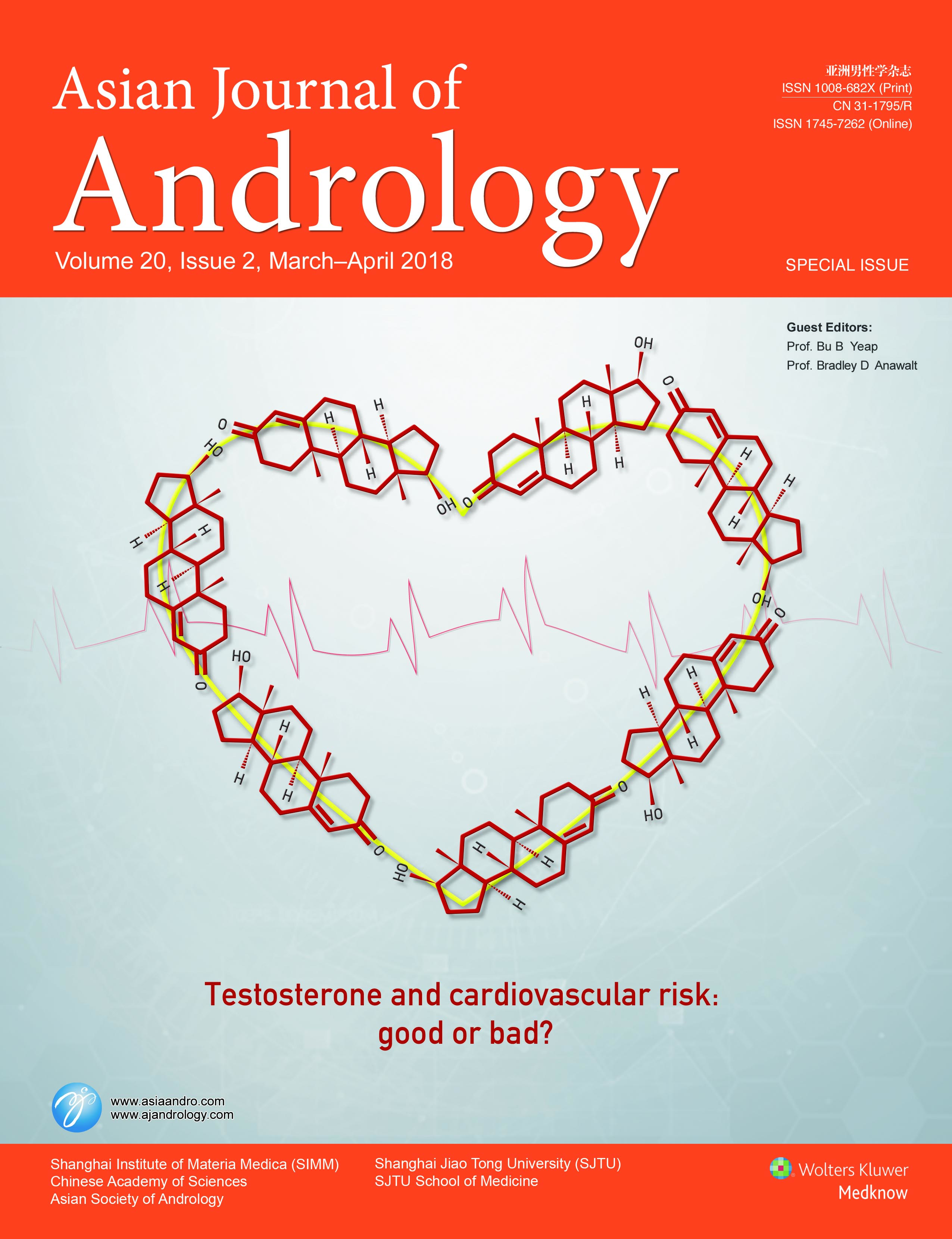
Vol.20 No.2 |
Testosterone and cardiovascular risk: good or bad?
My youngest daughter draws by hand precise and intricate mandalas. Her
mandalas inspired this simplistic figure of testosterone molecules wreathed around an iconic heart. The word "mandala" is Sanskrit and is roughly translated as "circle" or "discoid". A mandala can be used as a schematic representation of the universe, and the cover art captures the image of our efforts to synthesize the scientific knowledge regarding the cardiovascular effects of testosterone in this special edition of AJA. (Cover concept and artwork are provided by Prof. Bradley
D Anawalt) |
| |
|
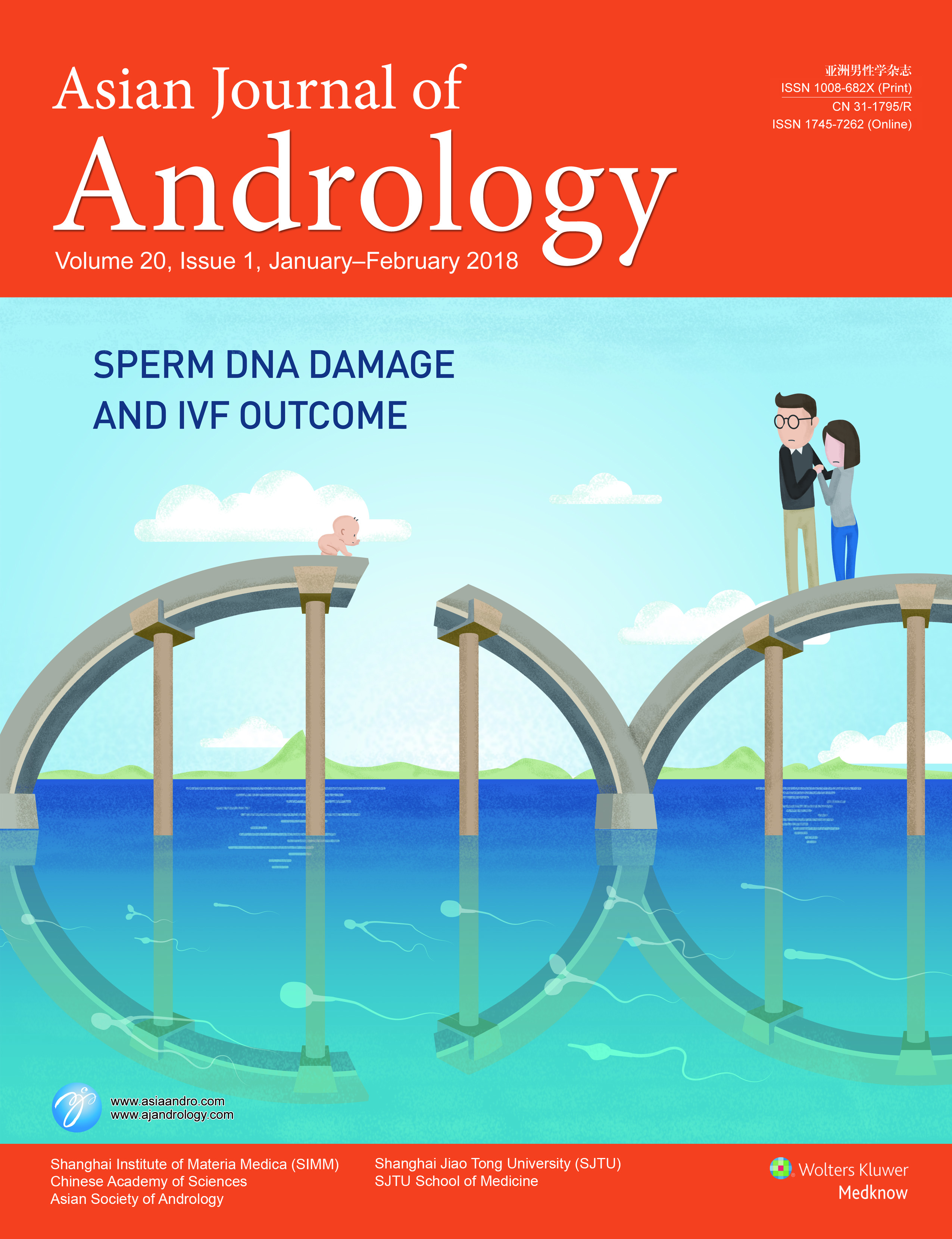
Vol.20 No.1 |
Sperm DNA damage is recognized as an important biomarker of male infertility. The aim of the present study was to examine the relationship between sperm DNA damage and IVF outcomes. The sperm chromatin dispersion (SCD) test was employed to assess sperm DNA damage in semen and motile spermatozoa harvested by combined density gradient centrifugation and swim-up in semen samples. Couples were divided into two groups according to pregnancy or not. The sperm DNA damage was significantly different between two groups and was negatively correlated with IVF outcomes. Logistic regression analysis confirmed that it was an independent predictor for achieving clinical pregnancy. Following IVF, the results showed that embryo quality, blastocyst formation, implantation and pregnancy rates decreased with the increase of sperm DNA damage, but the fertilization rate was not affected. Sperm DNA damage as measured by the SCD appears useful for predicting the clinical pregnancy rate following IVF. Please refer to
pages 75–79 by Zheng et al. for details. (Artwork is displayed by Xiang Chen) |
| |
| 2017 |
|
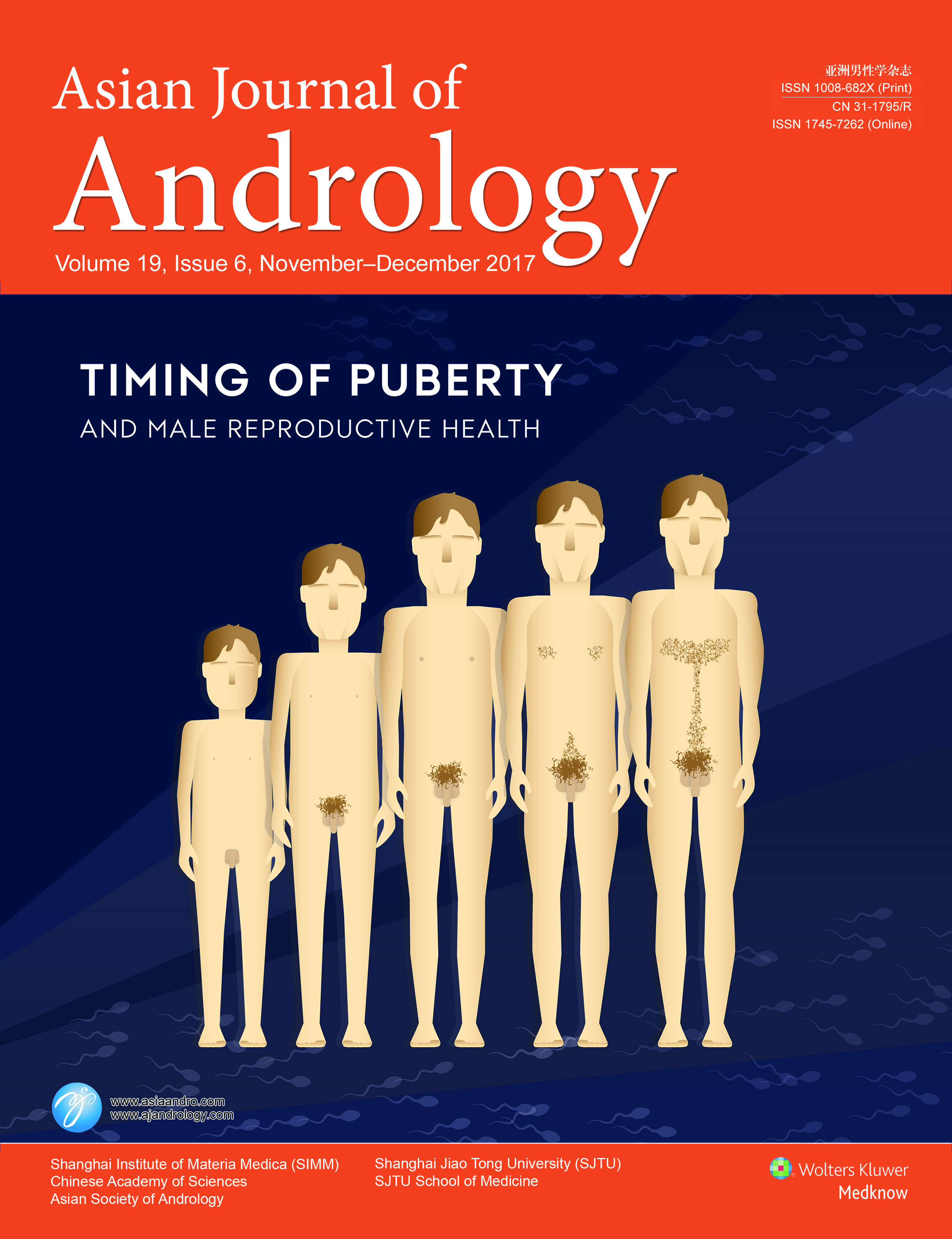
Vol.19 No.6 |
Timing of pubery and male reproductive health
Poor semen quality is a main cause of reduced male fecundity. In some countries, the proportion of men with a suboptimal semen quality is high. Despite this, only few potential causes of poor semen quality have been identified. The role of pubertal timing is largely unknown. In this study, 320 men aged 18 – 21 years enrolled in a Danish birth cohort provided self-reported data on pubertal indicators and delivered semen- and blood samples. The results indicated an association between older age at pubertal development and lower semen quality and altered levels of reproductive hormones in young adult life. Please refer to pages 625–632 by Lauridsen et al. for details. (Artwork is made by Gudrun Frost-Søgaard at Aarhus University Design)
|
| |
|
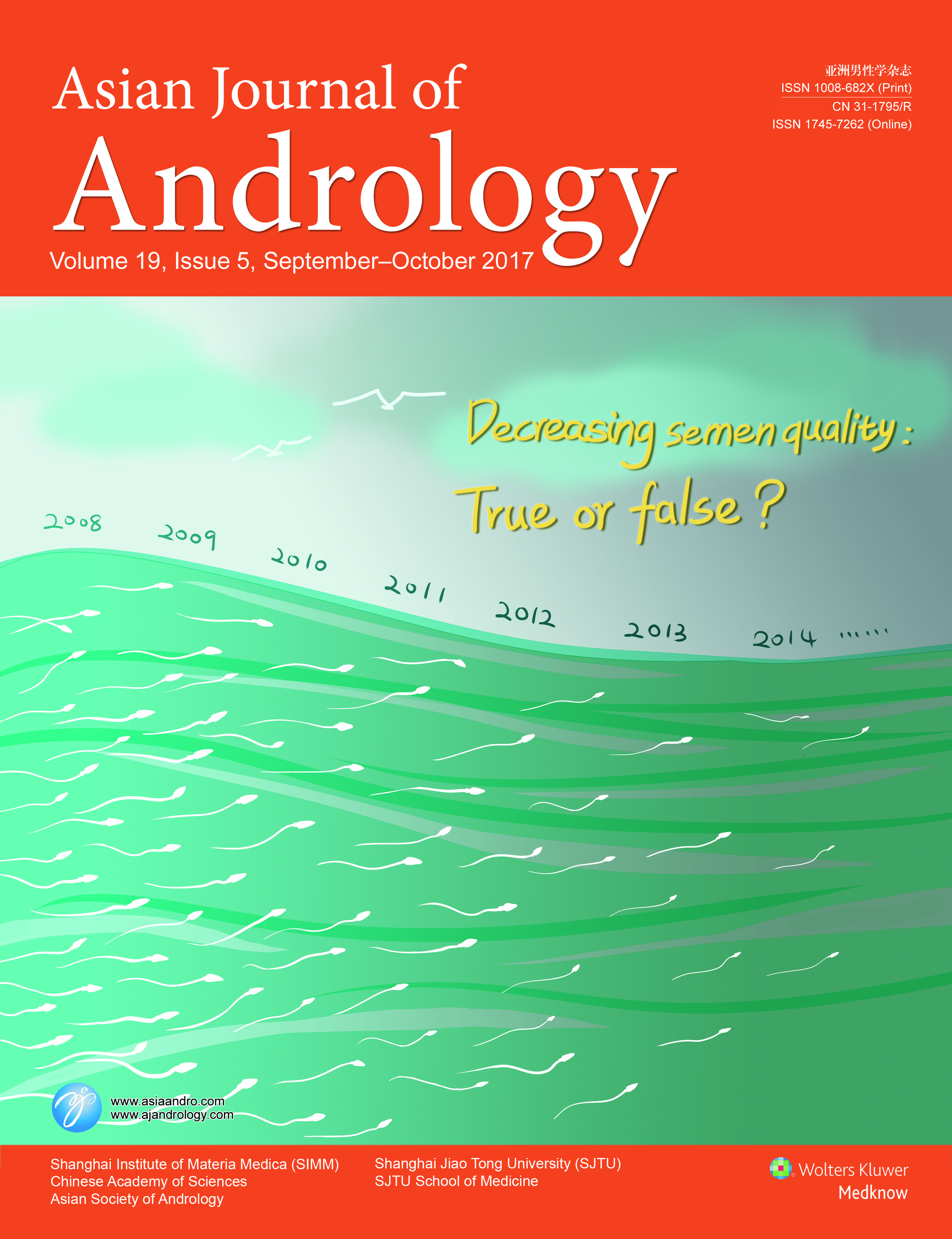
Vol.19 No.5 |
Decreasing semen quality: true or false?
In 1992, Carlsen et al. reviewed 61 heterogeneous observational studies on semen quality published between 1938 and 1991. The review indicated that mean sperm density decreased significantly in the past 50 years. After that, numerous studies suggest a decline in semen quality in some parts of the world. In contrast, other studies have reported no significant change in semen quality. However, the debate regarding semen quality remains ongoing due to the possible effects of race, geographic differences, selected subject population and so on. In this issue, Li Wang et al. found that semen quality showed a tendency to decrease within 7 years (2008–2014) in 5210 healthy Chinese sperm bank donors. For more information, please refer to pages 521–525 by Wang et al for details. (Artwork is provided by Li Wang and Ya-Wen Gao) |
| |
|
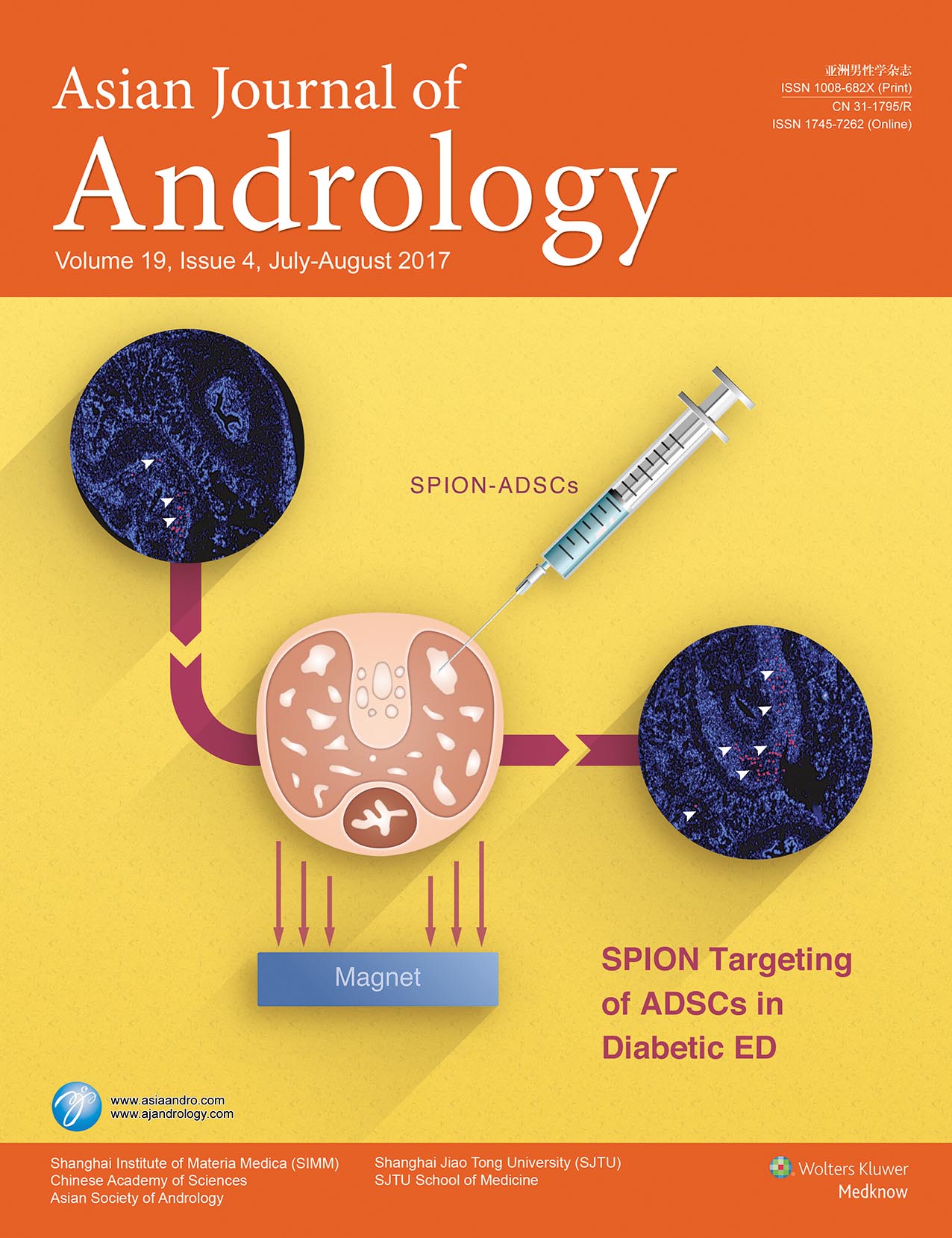
Vol.19 No.4 |
SPION targeting of ADSCs in diabetic ED
Stem cell therapy is a promising new frontier for the treatment of diabetic erectile dysfunction. However, inadequate cell homing to damaged sites has limited their efficacy. In the current study, we labelled adipose tissue-derived stem cells (ADSCs) with a conventional magnetic resonance imaging contrast agent, superparamagnetic iron oxide nanoparticles (SPIONs), and demonstrated that application of an external magnetic field could improve the in vivo homing efficiency of ADSCs to the corpus cavernosum region and contribute to the improvement in erectile function of diabetic rats. Besides, our further research suggested that the paracrine effect of ADSCs appeared to play the major role in functional and structural recovery. In conclusion, our study provides evidence that magnetic field-guided ADSC therapy is an efficient approach for diabetic ED therapy. Please refer to pages 425-432 by Zhu et al. for details. (Artwork is displayed by Xiang Chen)
|
| |
|
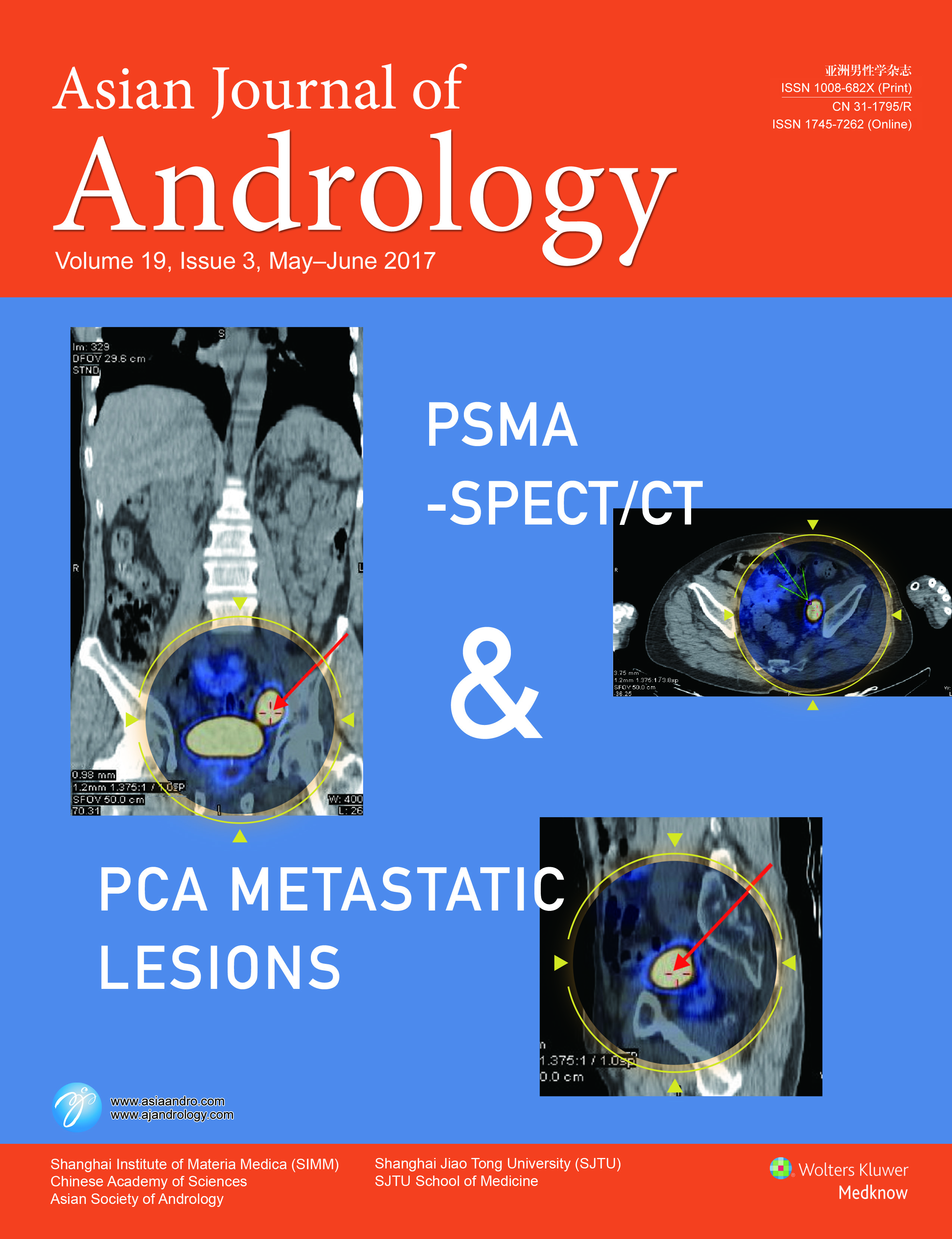
Vol.19 No.3 |
PSMA-SPECT/CT and PCa metastatic lesions
Using conventional imaging modalities, it is difficult to detect recurrent lesions in prostate cancer patients who have undergone biochemical relapse. We retrospectively reviewed fifty patients with histopathologically confirmed prostate cancer who underwent 99mTc labeled PSMA-SPECT/CT, MRI, and bone scan. PSMA-SPECT/CT indicated metastatic lesions in 39 patients and had a higher detection rate than bone scan or MRI. The diagnostic efficiency of PSMA-SPECT/CT imaging for bone and lymph node metastases was better than bone scan or MRI. PSMA SPECT/CT provided a higher detection rate at different PSA levels. No correlation was found between Gleason score, PSA level, and the tracer tumor/background ratio of metastatic lesions. With the aid of PSMA SPECT/CT imaging, the therapeutic strategy was changed for 31 patients, and this may have enhanced their clinical outcome. In conclusion, PSMA SPECT/CT imaging could achieve a higher detection rate than conventional imaging modalities in prostate cancer patients who had undergone biochemical relapse. Please refer to pages 267–271 by Su et al. for details. (Artwork is displayed by Xiang Chen) |
| |
|
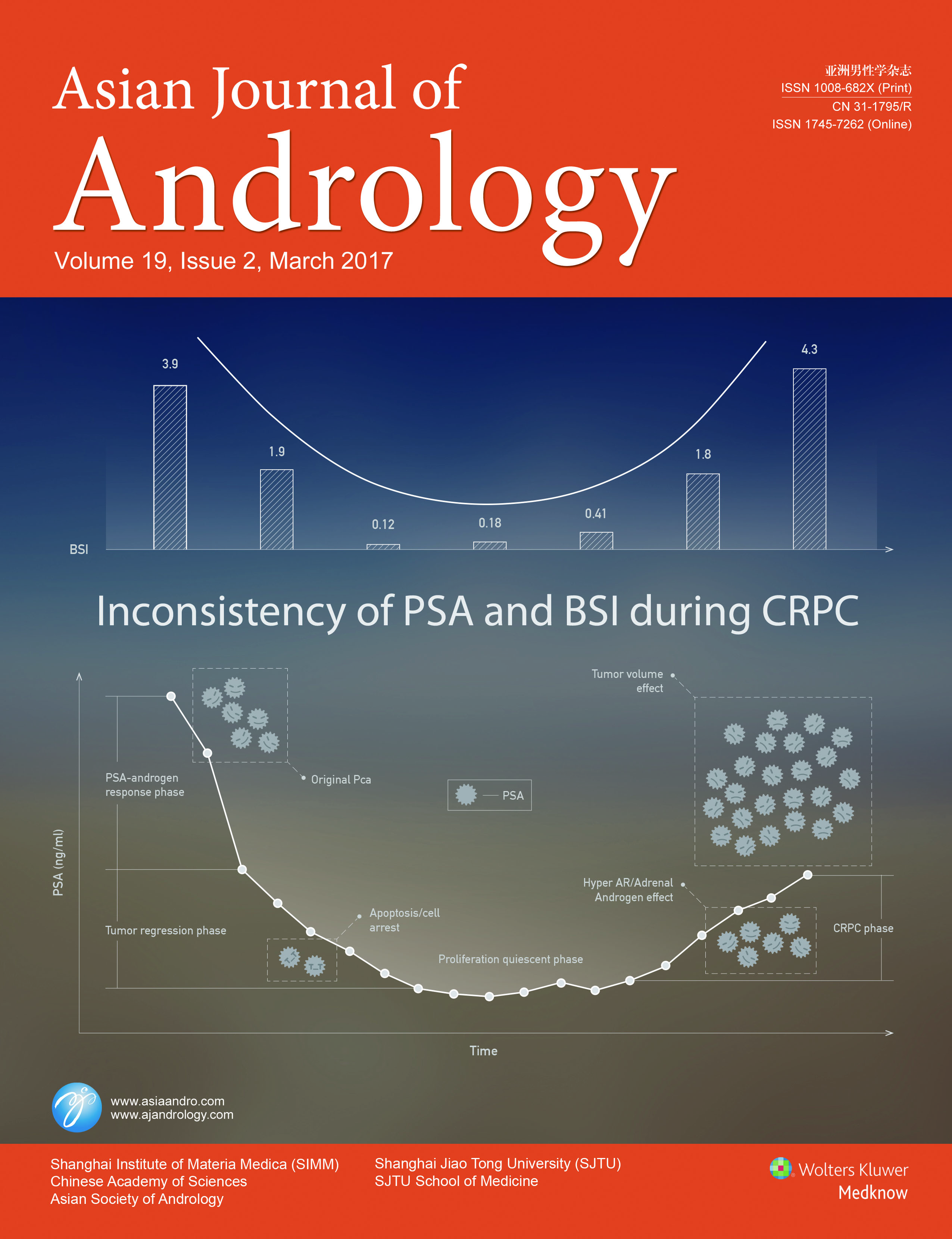
Vol.19 No.2 |
Inconsistency of PSA and BSI during CRPC
Upper figure: The level of bone metastasis, Bone Scan Index (BSI) on bone scintigraphy, was decreased by androgen deprivation therapy (ADT), and subsequently was increased to the level of pre-ADT on CRPC. Lower figure: Prostate Specific Antigen (PSA) quickly decreases because ADT inactivates PSA promoter, and subsequently decreases gradually due to apoptosis. Then PSA become stable on proliferation quiescence. Finally, PSA increases on relapse. However, PSA level is still low compared with high BSI (Upper figure). One reason of this inconsistency is supposed with tumor volume effect rather than the effect of hypersensitive AR. Please refer to pages 143-148 of the article by A. Mizokami for details. (Artwork is displayed by Xiang Chen)
|
| |
|
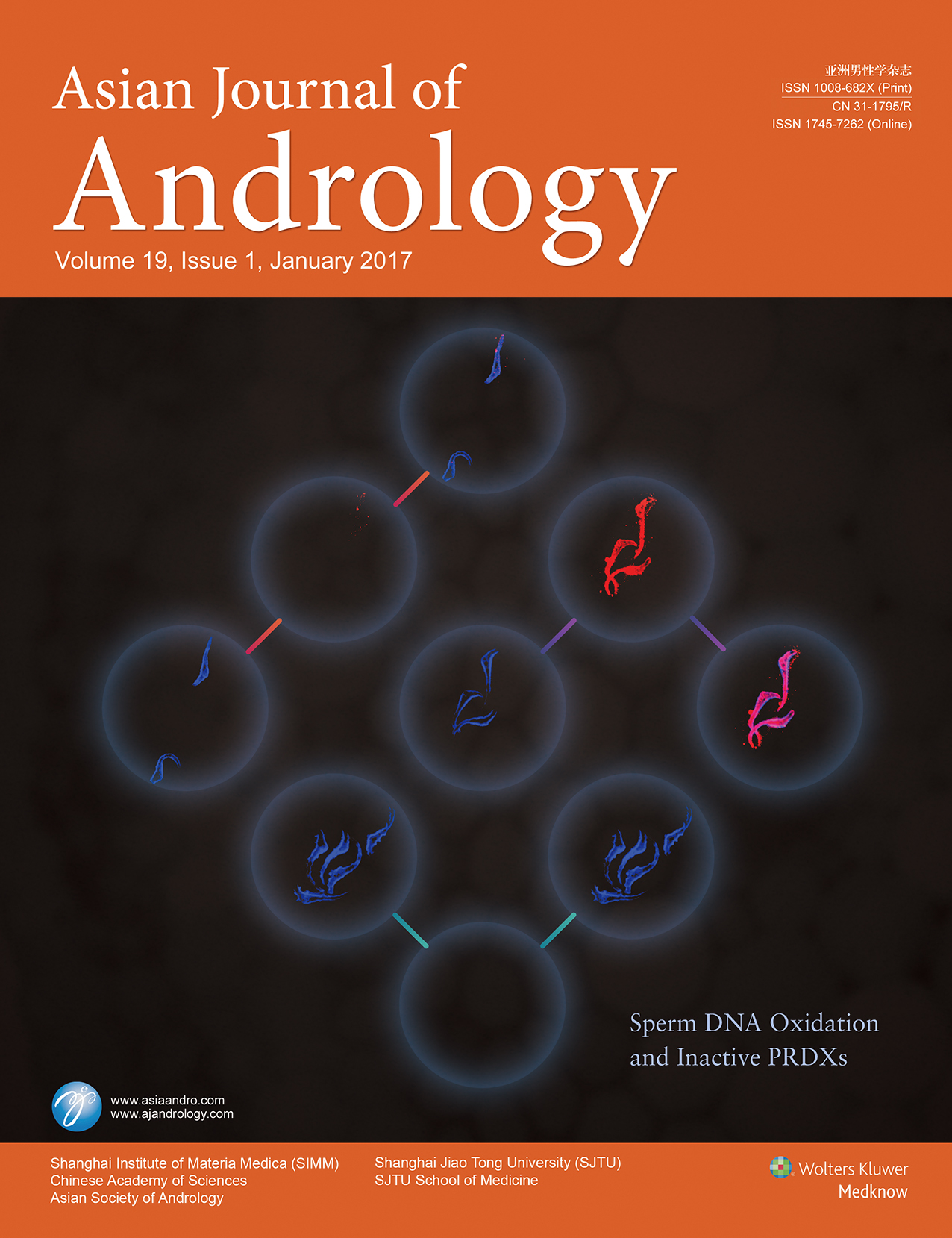
Vol.19 No.1 |
The effects of in vivo oxidative stress on epididymal maturation promote a shut-down of the PRDX system that will be translated in a deterioration of sperm quality characterized by increased sperm DNA oxidation and impaired sperm motility. The in vivo-induced oxidative stress triggers a differential expression of peroxiredoxins (PRDXs) in different segments of the epididymis and the transfer of PRDXs to the maturating spermatozoa to protect them against the high levels of ROS produced. However, when the PRDXs system is overcome by the established oxidative stress, PRDXs become highly oxidized (displaying oxidation of the thiol groups in their active site) and unable to protect spermatozoa against oxidative damage. This outcome is seen in infertile men with very low amount of PRDXs or when these enzymes are inactivated. Our findings highlight the major role of PRDXs in the antioxidant protection of spermatozoa. For more information, please refer to the article on pages 73-79. (The image is from Dr. O’Flaherty’s article, and artwork is displayed by Xiang Chen).
|
| |
| 2016 |
|
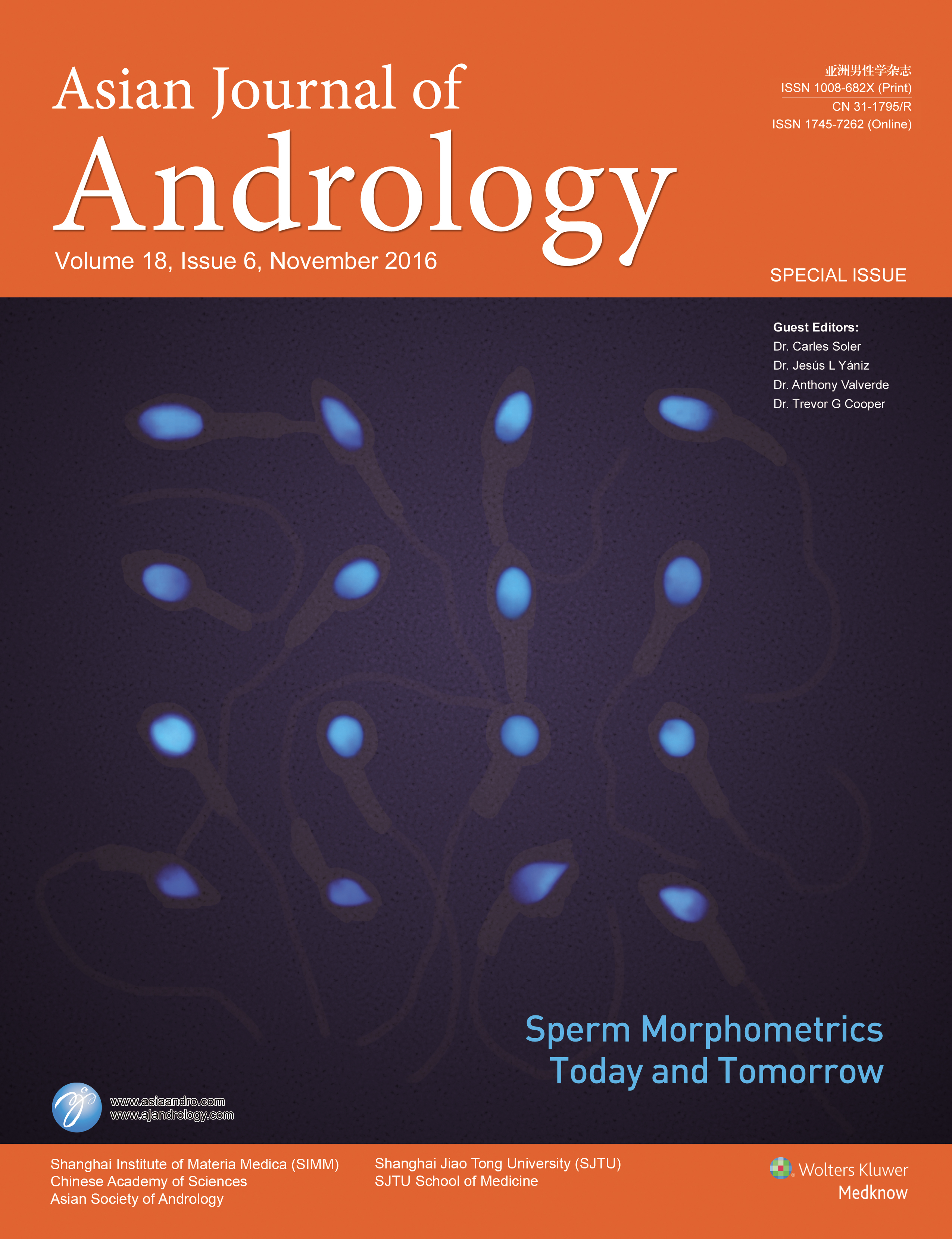
Vol.18 No.6 |
Sperm Morphometrics Today and Tomorrow
Sperm morphology has long been
considered an important factor in
male fertility, but assessing it has been
bedevilled by the subjective nature of
deciding if a particular sperm cell is
normal or abnormal, why it falls into
either category and how that decision
is made. The development of machines
that assess sperm morphology
quantitatively (computer-aided sperm
analysis for morphology) offered a
solution by providing dimensions
of spermatozoa, but this approach
is limited when statistical analysis is
applied separately to each parameter.
The combination of CASA-Morph
and multi-parametric statistical
analyses, such as principal component
analysis, offers a way forward, since
subpopulations of spermatozoa of
different morphometry are generated,
the presence or size of which may
well be diagnostic for infertility and
prognostic for fertility. This Special
Issue explains these procedures and
shows how they can be applied to
the analysis of spermatozoa from
man and a range of commercially
important species whose fertility is well
documented. (The image is from Jesús L
Yániz et al., and artwork is displayed by
Xiang Chen) |
| |
|
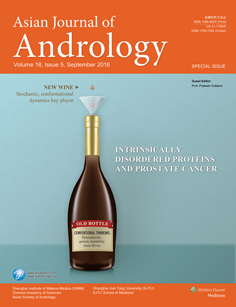
Vol.18 No.5 |
Intrinsically Disordered Proteins and Prostate Cancer
Conventional wisdom dictates that cancer is a genetic disease emphasizing the deterministic nature of its underlying plasticity. Thus, phenotypic plasticity, a hallmark of the disease is thought to be driven by a series of genomic mutations and therefore, irreversible. Contrary to this wisdom, new thinking presented here explores the possibility that stochasticity which is inherent to nonlinear systems may also play an important role. The theory underscores conformational dynamics of intrinsically disordered proteins (IDPs) as the main driver of phenotypic plasticity in cancer cells. By rewiring protein interaction networks characteristic of a given phenotype, it is postulated that IDPs can reversibly facilitate state switching in a manner analogous to a phase transition phenomenon. Thus, targeting key IDPs or intrinsically disordered regions within ordered proteins such as the N-terminal domain of the androgen receptor rather than highly ordered domains such as its ligand-binding domain may provide novel and highly effective therapeutics for prostate cancer. (The photos are provided by Prof. Prakash Kulkarni. The artwork is displayed by Xiang Chen) |
| |
|
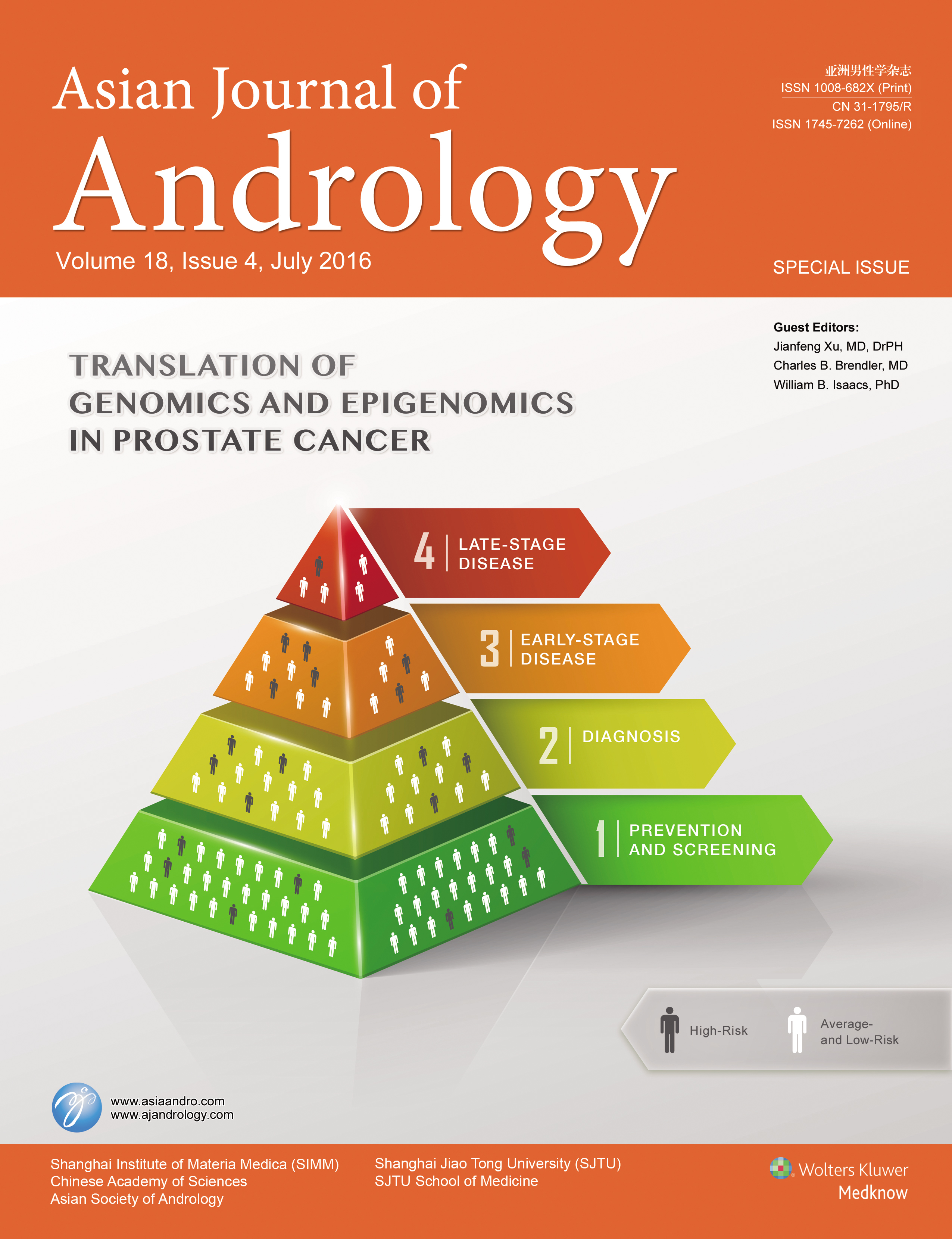
Vol.18 No.4 |
Translation of Genomics and Epigenomics in Prostate Cancer
Translation of Genomics and Epigenomics in Prostate Cancer
The Pyramid Model illustrates a paradigm for personalized medicine that promotes a proactive approach for prostate cancer care from screening and diagnosis, to the treatment of early- and late-stage diseases. The personalization of clinical practice is conducted primarily by assessing inherited and acquired changes in both DNA and RNA. In the lowest tier, inherited genetic variants can be used to assess risk for prostate cancer to determine who should undergo PSA screening. In higher tiers, DNA- and RNA- based methods can be used to assess prognosis (i.e. predict lethality) and/or select specific therapies for men who have been diagnosed. For example, DNA copy number alterations can be assessed in early-stage disease to help determine the likelihood of cancer progression, and an androgen receptor variant in tumor DNA can confer resistance to specific antiandrogen drugs. Implementation of the Pyramid Model into clinical care has the potential to improve quality of life, decrease mortality, and decrease costs. (Art by Xiang Chen). |
| |
|
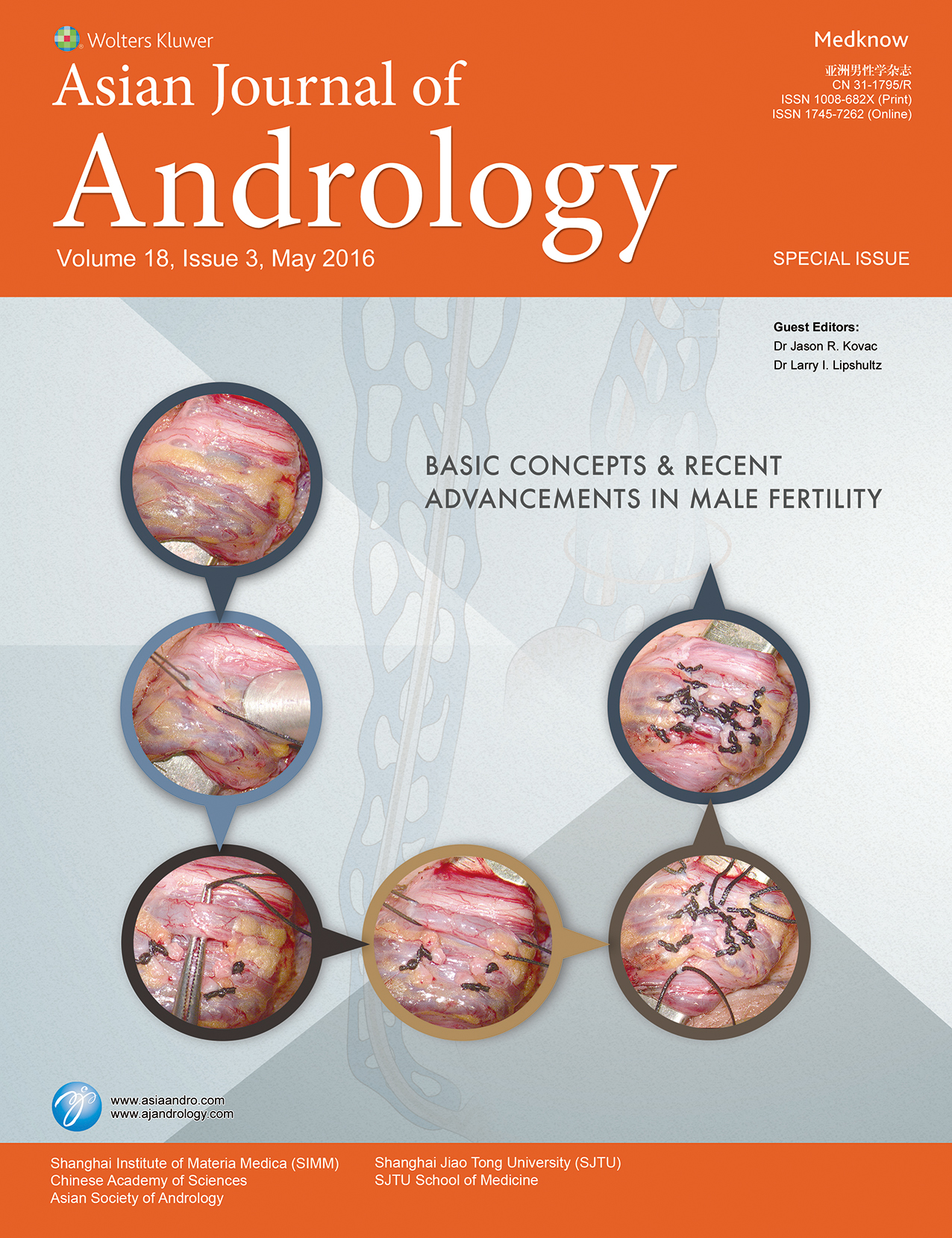
Vol.18 No.3 |
Basic Concepts &Recent Advancements in Male Fertility
Images highlighting stages of a microsurgical varicocele repair. Following sub-inguinal incision, the spermatic cord is identified and brought into the operative field (Panel 1). Under magnification, cremasteric fibers are separated and placed underneath a knife handle keeping the cord elevated in the incision. Vas deferens and veins are easily identified. Intra-operative auscultation of the testicular artery initially characterizes the location (Panel 2). 2-0 silk ties are threaded underneath each vein superior and inferiorly. The vein is subsequently tented and occluded while the artery is auscultated distally. Patency of the testicular artery is confirmed prior to final venous occlusion. Fine Jacobson mosquitos pass 2-0 silk ties underneath spermatic cord veins (Panel 3). Veins can be transected to gain access to deeper venous structures or tied if large/peripheral (Panel 4). Lymphatic structures are tagged. Some ties are left long allowing for retraction and improved visualization of cord structures (Panel 5). Completed repair finds numerous tied and/or transected vessels (Panel 6). Care was taken to preserve the testicular artery, vas deferens and lymphatic structures. (The photos are provided by Dr. Jason R. Kovac. The artwork is displayed by Xiang Chen) |
| |
|
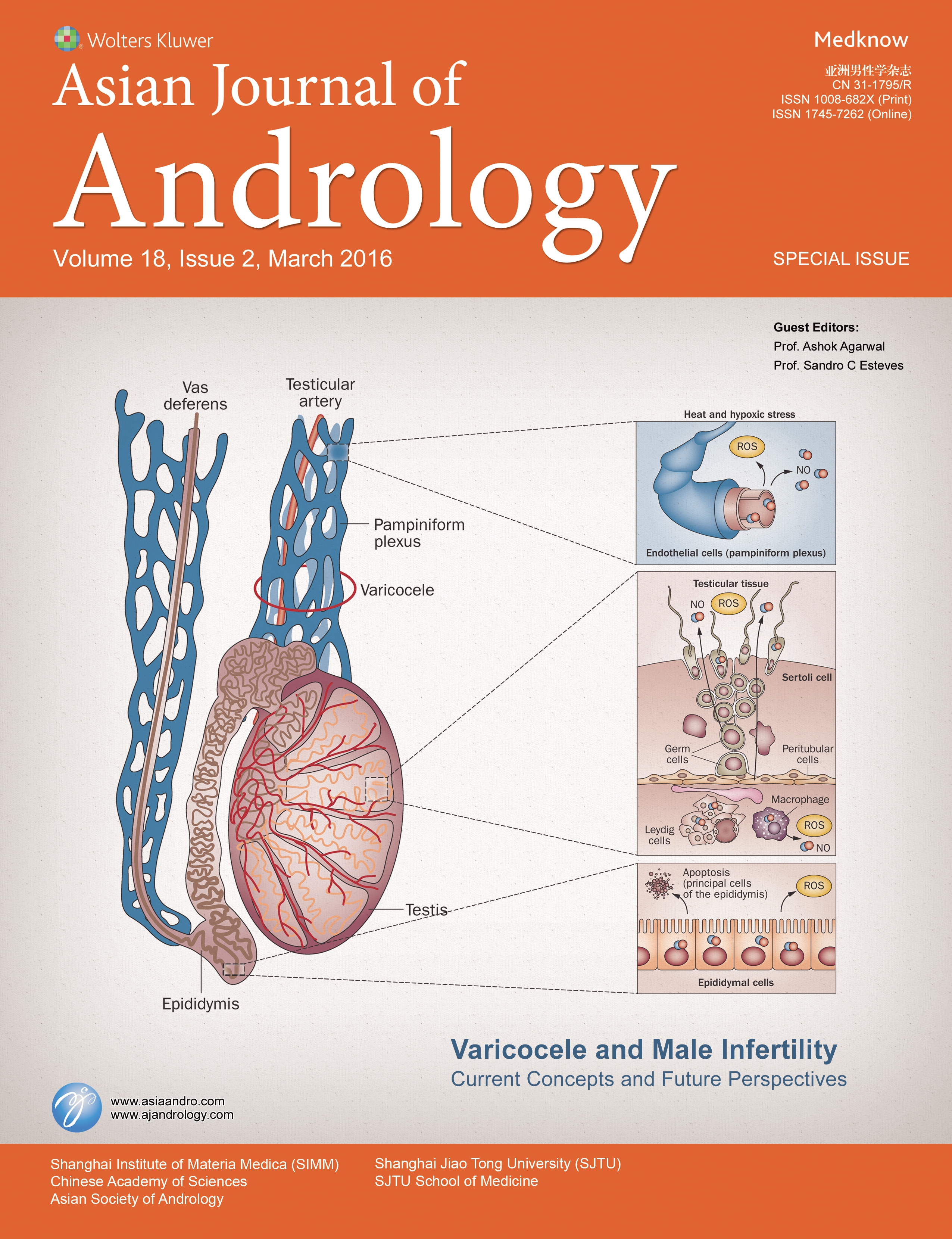
Vol.18 No.2 |
Varicocele and Male Infertility
Oxidative stress is the central and common pathogenic mediator of testicular damage in varicocele, and exposure to heat, hypoxia and toxic adrenal and renal metabolites are stimulators of reactive oxygen and nitrogen species generation. ROS encompass a broad category of highly reactive substances formed as byproducts of oxidative and reductive metabolic reactions. Reactive nitrogen species constitute a subset of ROS that contains nitrogen atoms. Three components can release ROS in men with varicocele under heat and hypoxic stress: the principal cells in the epididymis, the endothelial cells in the dilated pampiniform plexus and the testicular cells (developing germ cells, Leydig cells, macrophages and peritubluar cells). An imbalance between ROS and their neutralizing antioxidants in men with varicocele results in oxidative stress that is mediated through a variety of mechanisms and target lipids, proteins, sugars and nucleic acids. Excessive ROS overwhelm primary sperm defenses against oxidative stress — the tight packing of sperm DNA and seminal antioxidants. The harmful effects of oxidative stress include peroxidation of sperm membranes and changes in membrane fluidity, and nuclear and mitochondrial sperm DNA damage. (Adapted by permission from Macmillan Publishers Ltd: Nature Reviews Urology. Agarwal A, Hamada A, Esteves SC: Insight into oxidative stress in varicocele-associated male infertility: part 1. issue 9, pages 678–690, 2012). The artwork is displayed by Xiang Chen. |
| |
|
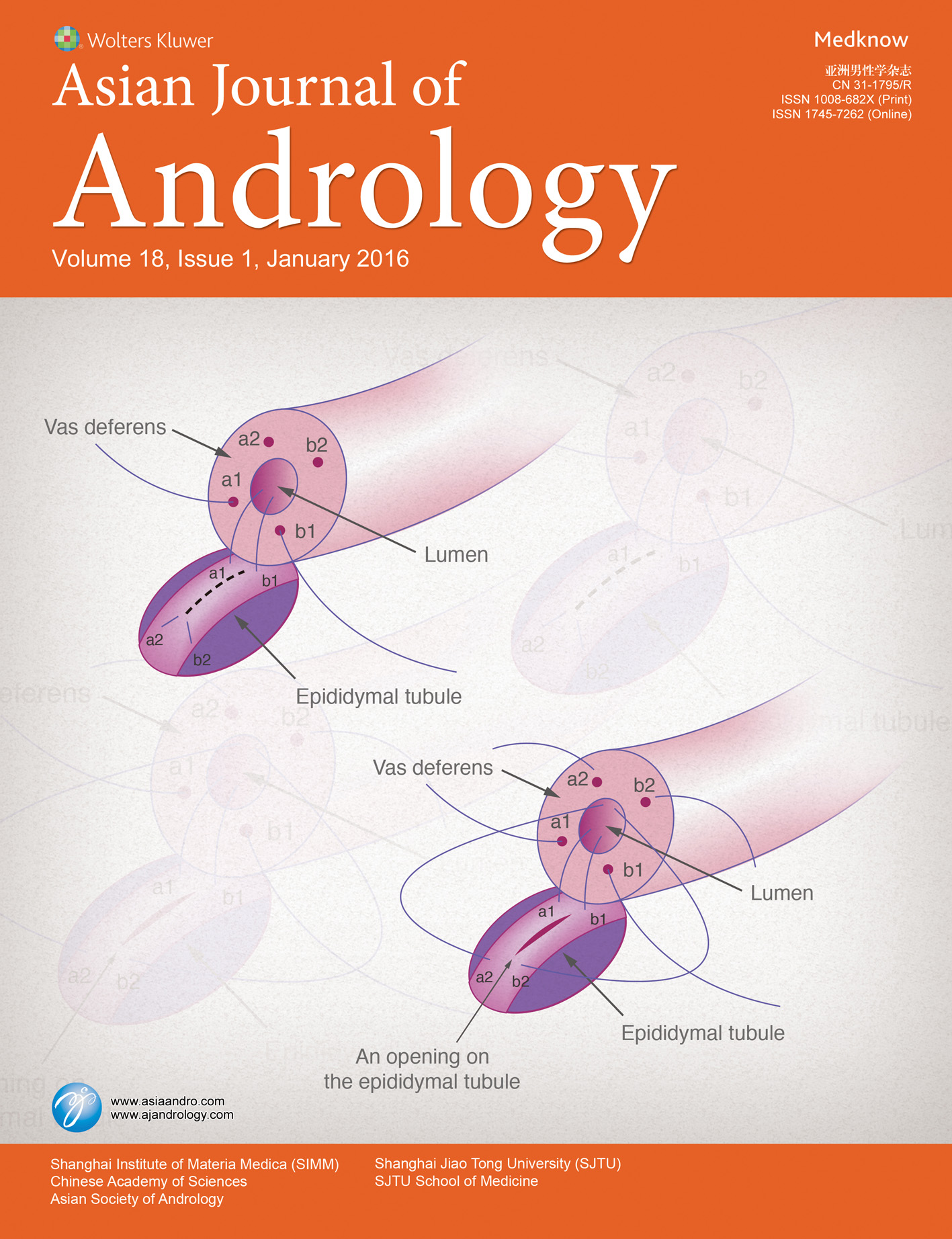
Vol.18 No.1 |
Vasoepididymostomy (VE), as the most challenging procedure in microsurgeries, is often carried out with a double-armed two-suture technique. However, suitable and cost-effective high quality double-armed micro-sutures for male infertility microsurgeries are not easy to obtain. In this study, we evaluated the efficacy and safety of the single-armed two-suture longitudinal intussusception microsurgical VEs on humans by a single surgeon (Dr. Kai Hong), and studied the factors that could possibly affect the patency rates. The single-armed two-suture longitudinal VE technique is feasible for microsurgical practice. The patency and pregnancy rates are comparable to the doubled-armed technique. Anastomosis sites and motile sperm found in epididymal fluid were the most two important factors related to higher patency. For more information, please refer to the article on pages 129-133. (The image is from Dr Hong’s article, and artwork is displayed by Xiang Chen)
|
| |
| 2015 |
|
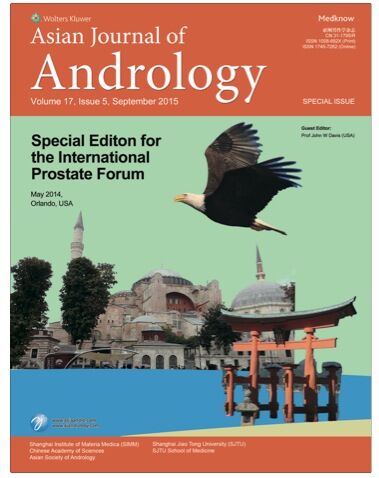
Vol.17 No.6 |
SPECIAL EDITION FOR THE INTERNATIONAL PROSTATE FORUM
The International Prostate Forum is a collaborative group from the United States, Japan, and Turkey that focuses on clinical and translational science research related to prostate cancer and benign diseases. On the cover of this issue, we blend iconic symbols from these three countries. The bald eagle shown is the national bird of the United States of America. It was chosen because of its long life, great strength, majestic looks, and is symbol of freedom. The Hagia Sophia museum is in Istanbul, Turkey. It was initially a Greek Orthodox cathedral, and later became a mosque. It is a symbol of great architecture, and a unique co-existence of Christian and Muslim history and art. From Japan, the orange floating torii at the Itsukushima Shrine is located on Miyajima island near Hiroshima. A torii makes the entrance to a sacred space. |
| |
|
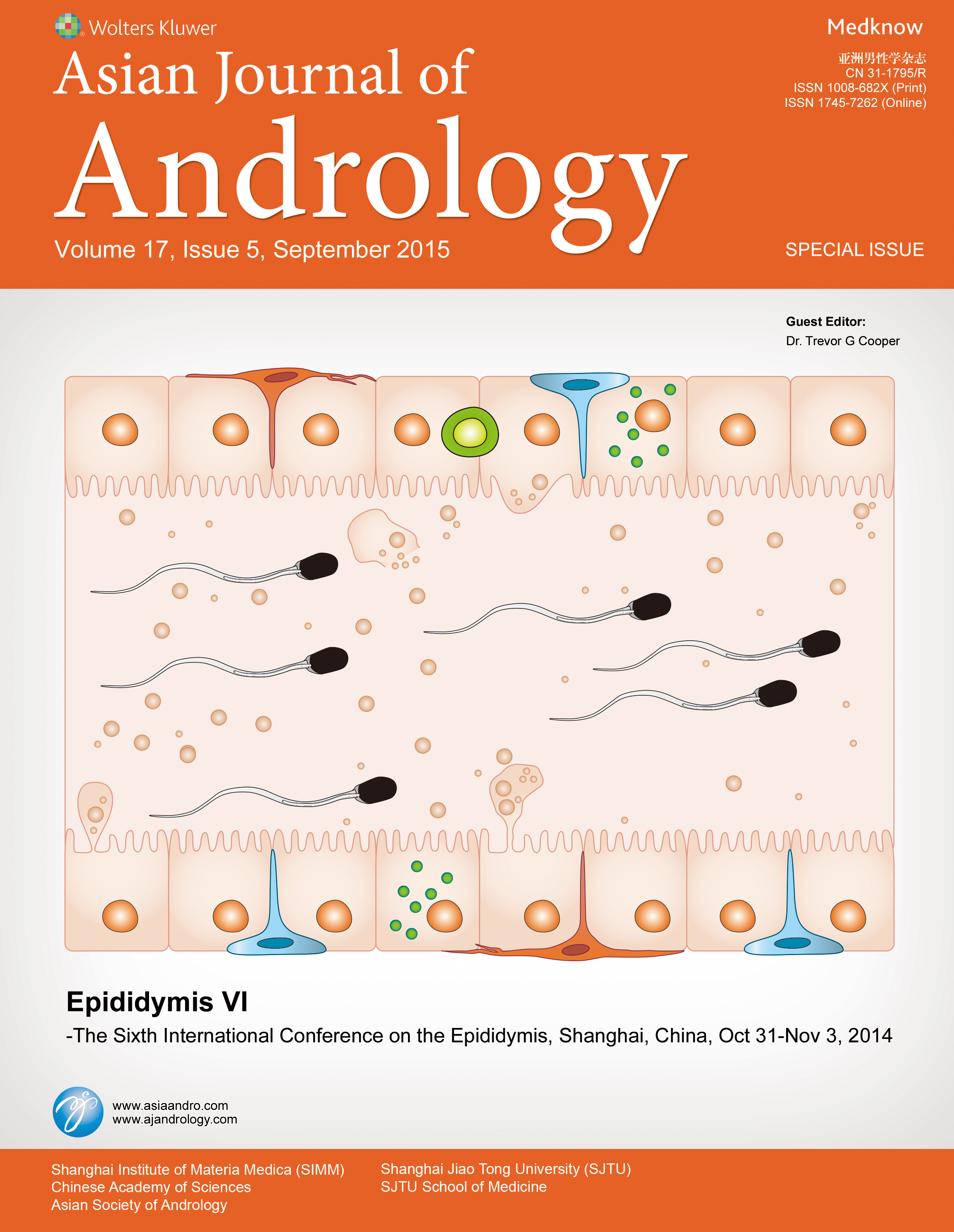
Vol.17 No.5 |
EPIDIDYMIS VI - THE SIXTH INTERNATIONAL CONFERENCE ON THE EPIDIDYMIS
Within the intraluminal compartment of the epididymis, maturing spermatozoa interact with heterogeneous populations of extracellular vesicles (EVs) referred to as epididymosomes. In addition to playing a role in the acquisition of new proteins on the sperm surface, these EVs transport small-non-coding RNAs called microRNAs, which may participate in a well-orchestrated intercellular communication system between somatic and germinal cells. According to several knock-out mouse models, these major regulators of post-transcriptional gene expression have been shown to be involved in the control of male fertility. Distinct microRNAs species being produced and secreted by the internal organs of the male reproductive system, and present in seminal plasma at ejaculation, they constitute potential new molecular targets for the non-invasive diagnosis of idiopathic male infertility. Please refer to pages 730–736 of the article by C. Belleannée for details.(The graphic design contribution of France Couture from CHU de Quebec, Canada, is acknowledged, and artwork is displayed by Xiang Chen) |
| |
|
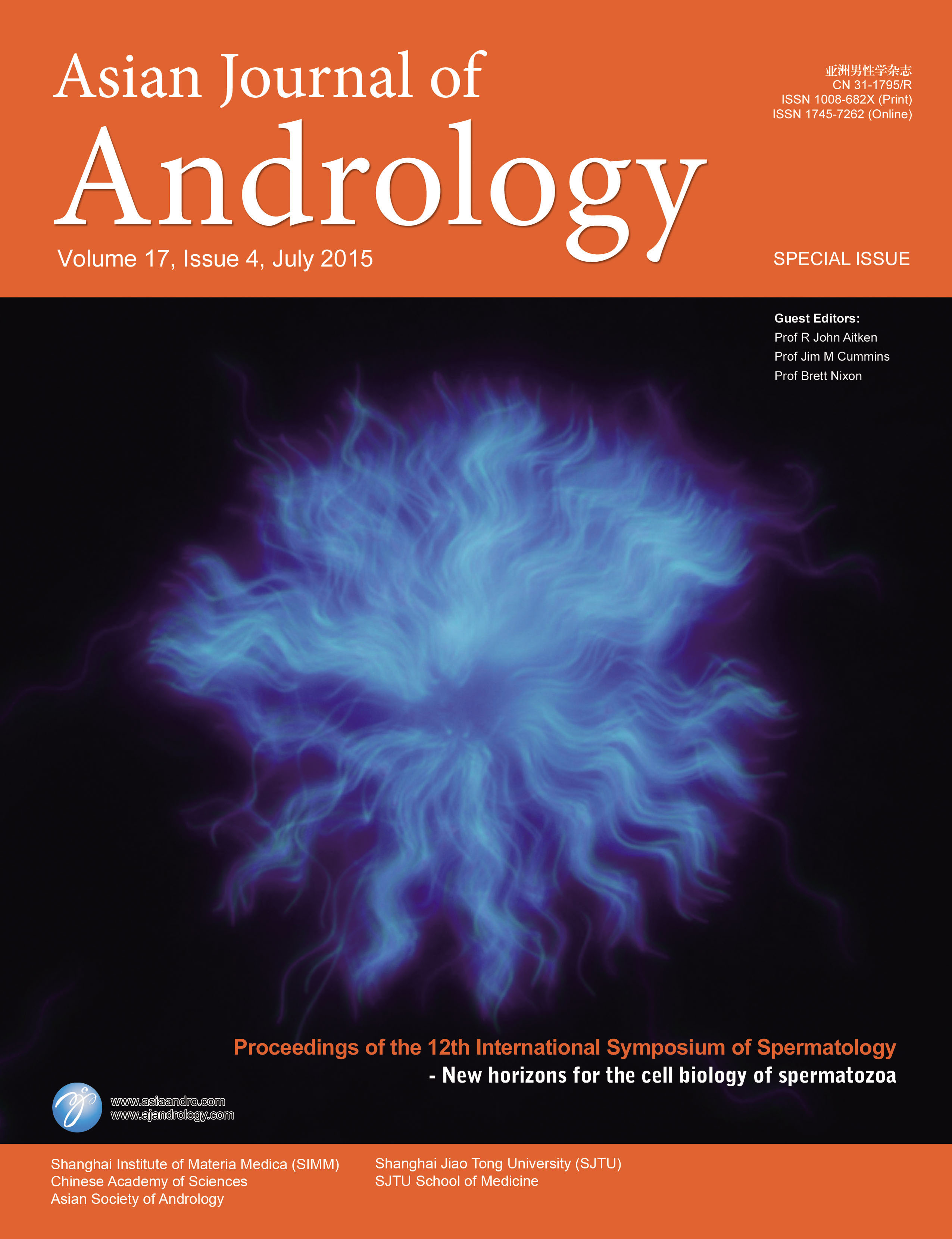
Vol.17 No.4 |
The 12 th International Symposium on Spermatology
Fluorescent image of an echidna spermatozoa bundle in which the nuclei are labelled with 4’,6-diamidino-2-phenylindole (DAPI). A unique feature of the monotreme epididymis lies in its ability to promote the formation of elaborate v-shaped bundles of up to 100 individual spermatozoa that are held together by an electron dense material that embeds the anterior region of the sperm heads. This image depicts a sperm bundle that has fanned out, a phenomenon that occurs immediately before the bundles disperse to release individual spermatozoa. (The cover image is provided by Dr Brett Nixon, Discipline of Biological Sciences, University of Newcastle, Australia, and artwork is displayed by Xiang Wang) |
| |
|
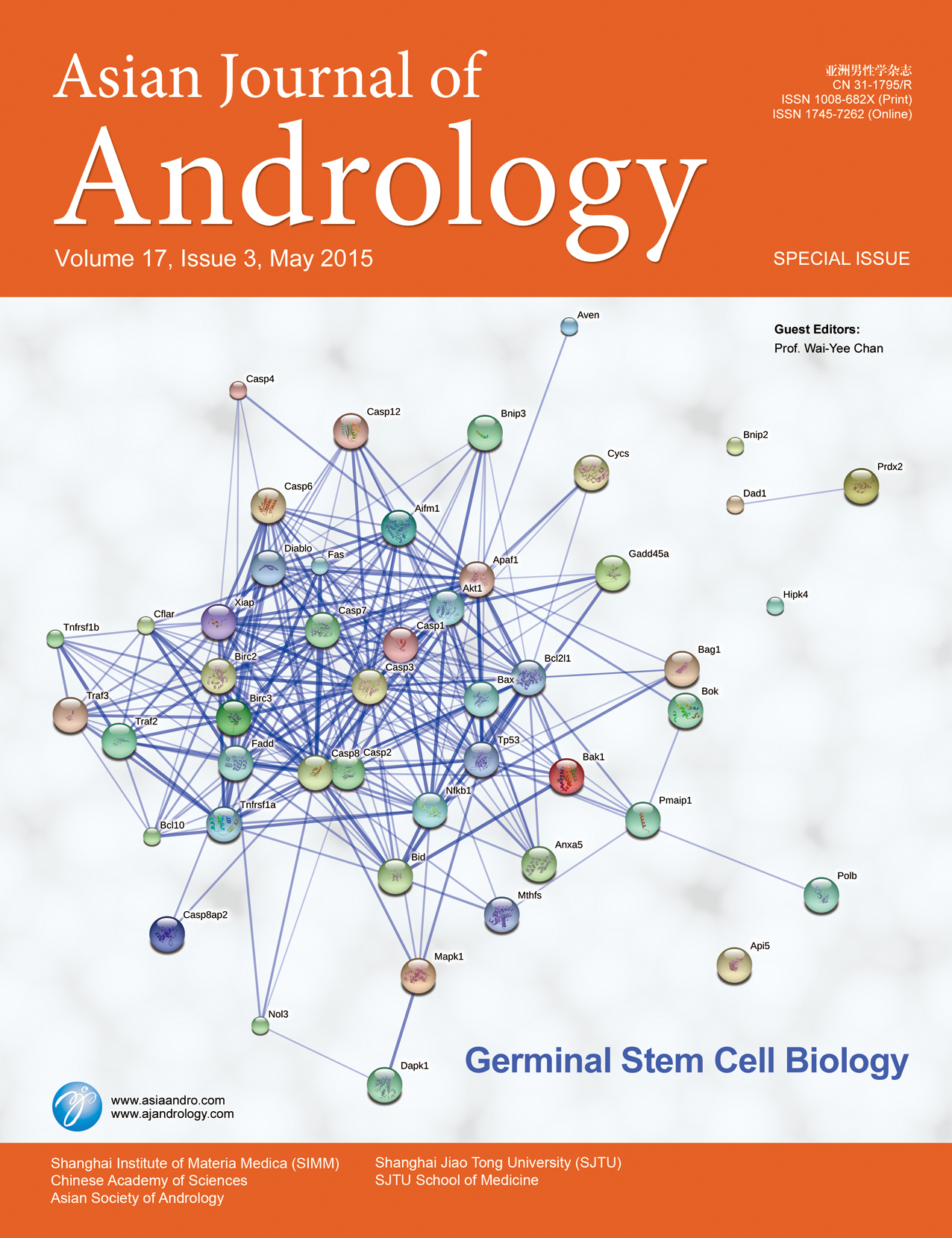
Vol.17 No.3 |
Germinal Stem Cell Biology
Spermatogenesis comprises a first phase leading to spermatogonial stem cells from transitional gonocytes, and a second spending from differentiating spermatogonia to sperm. This life-long process involves multiple steps of cell migration, differentiation, mitotic and meiotic divisions. Apoptosis plays a critical role as quality control system by eliminating defective germ cells, and in maintaining an adequate microenvironment by regulating germ to Sertoli cell ratio. While gonocytes undergo retinoic acid-induced differentiation, disrupting this process may lead to testicular cancer. In this issue, Manku and Culty examined the expression of 84 apoptosis-related genes in gonocytes, spermatogonia and seminomas. Functional partner predictions of upregulated genes in differentiating gonocytes using STRING analysis (Search Tool for the Retrieval of Interacting Genes/Proteins) identified a pro-survival cluster radiating from Akt, beside the main pro-apoptotic cluster around Caspase 3, suggesting a balance between pro- and anti-apoptotic genes at this point, preceding the first postnatal wave of apoptosis. For more information, please refer to the article on pages 403–414. (The image is from Manku and Culty’s article, and artwork is displayed by Xiang Chen) |
| |
|
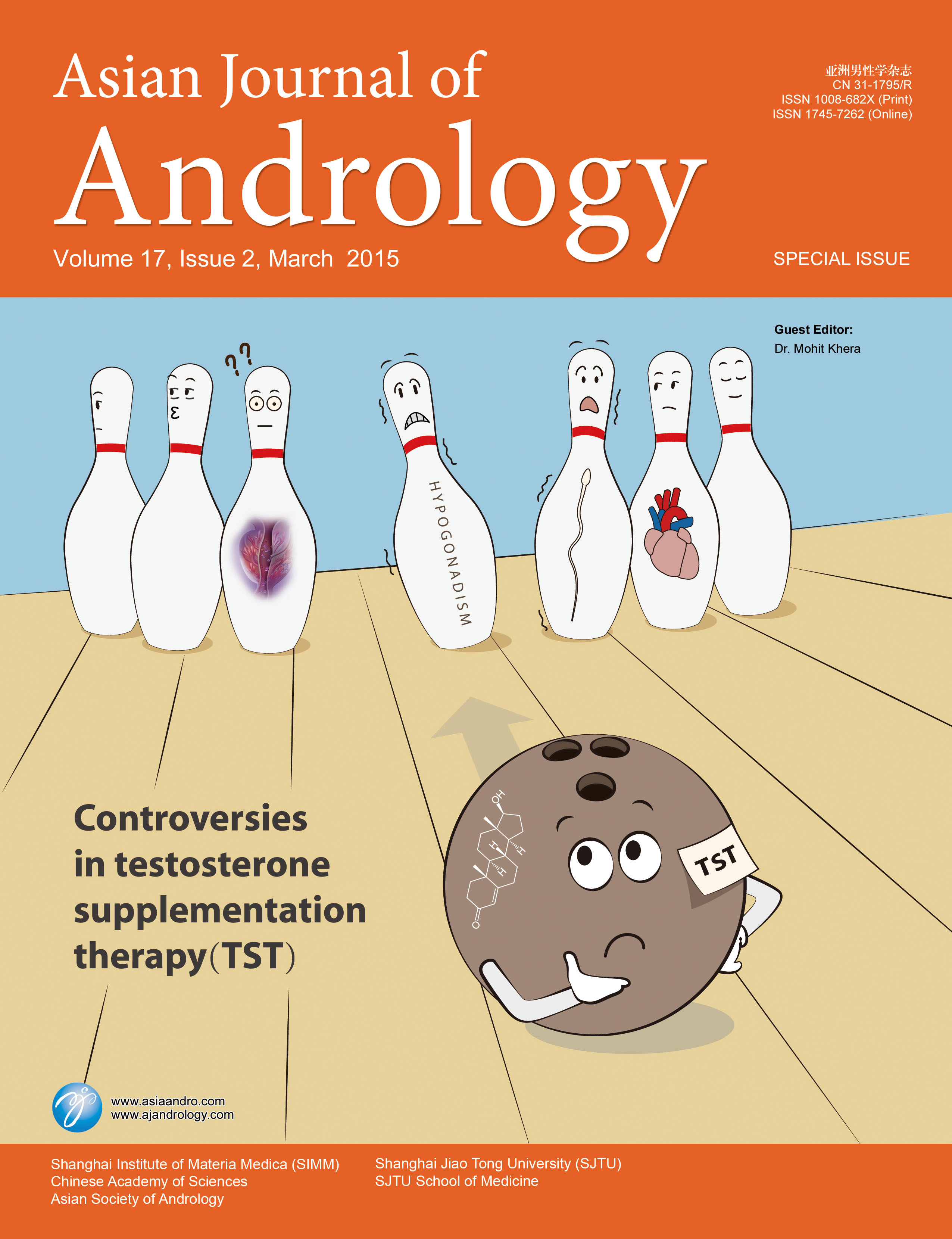
Vol.17 No.2 |
Controversies in testosterone supplementation therapy(TST)
Testosterone supplementation therapy (TST) has been rapidly expanding throughout the world. The rapid rise in TST may be due in part to the newly recognized beneficial effects seen with testosterone. Patients taking TST have experienced improvements in sexual desire, libido, depression, muscle mass, fat deposition, and overall energy. As our population ages, more and more men are now becoming candidates for testosterone supplementation therapy.
|
| |
|
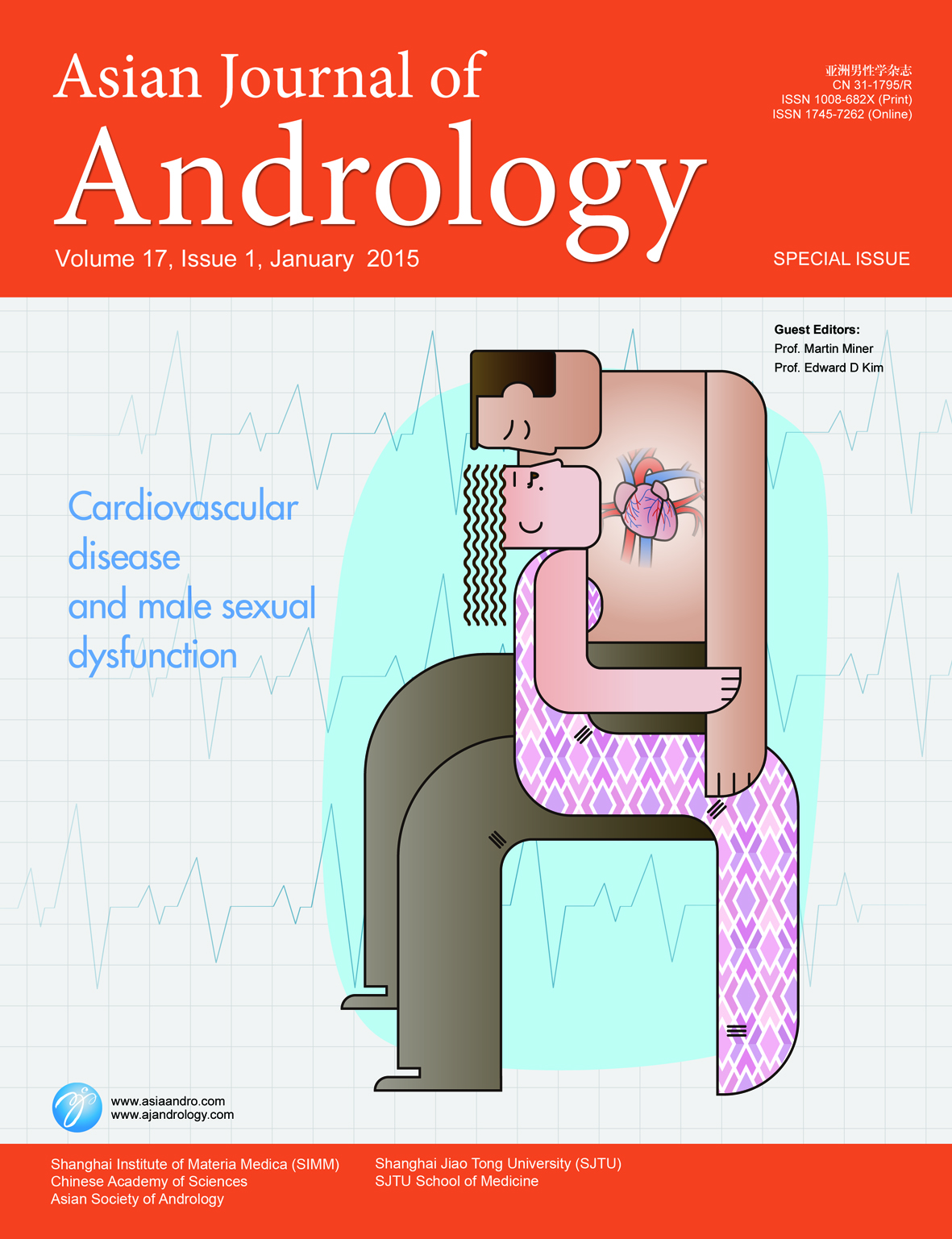
Vol.17 No.1 |
CARDIOVASCULAR DISEASE AND MALE SEXUAL DYSFUNCTION
Cardiovascular disease and male sexual dysfunction
Erectile dysfunction (ED) and cardiovascular disease (CVD) are increasingly common in the aging male population. The common link between these conditions is atherosclerosis and its underlying risk factors. This correlation between CVD and ED is now well-established and should be recognized by health care professionals, as well as by couples afflicted with ED. Modification of risk factors such as obesity, hypertension, diabetes, sedentary lifestyle and dyslipidemia may improve or limit further deterioration of ED. As a result, overall and sexual health can be positively impacted and increase the couple’s intimacy. Hypogonadism and its treatments, which are closely related to CVD and ED, are also important diagnostic and treatment considerations in this patient population. (Art by Xiang Chen) |
| |
| 2014 |
|
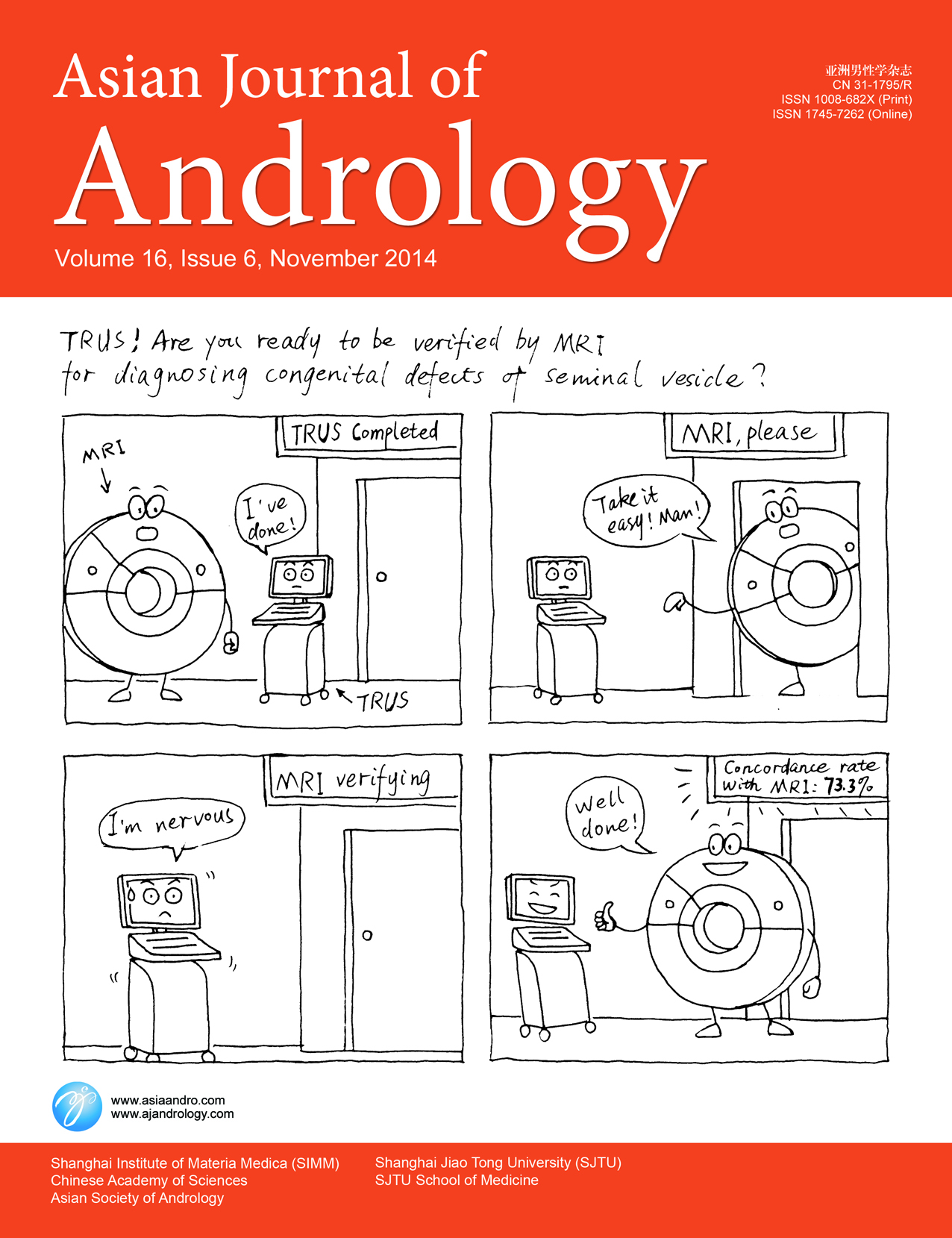
Vol.16 No.6 |
The average body mass index (BMI) is generally rising for both men and women in the Western world and along with this a concern for the possible harmful effect on the reproductive potential has emerged. It is well known that female weight disturbances affect fertility negatively and as a consequence, many European fertility clinics require female weight loss to a specific BMI threshold before initiating assisted reproductive technology (ART) treatment. From the male perspective, however, it is still unclear to what extent overweight and obesity affect sperm quality and the chances of conceiving-spontaneously as well as after ART. The relatively limited data published are conflicting and, therefore, it is still uncertain whether male weight loss will increase natural or assisted fertility. In this issue, Thomsen et al. investigate whether increased male BMI affects sperm quality and the outcome of assisted reproduction in 612 couples undergoing ART treatment at a Danish Fertility Centre. For more information, please refer to the article on pages 749–754. (Art by Xiang Chen) |
| |
|
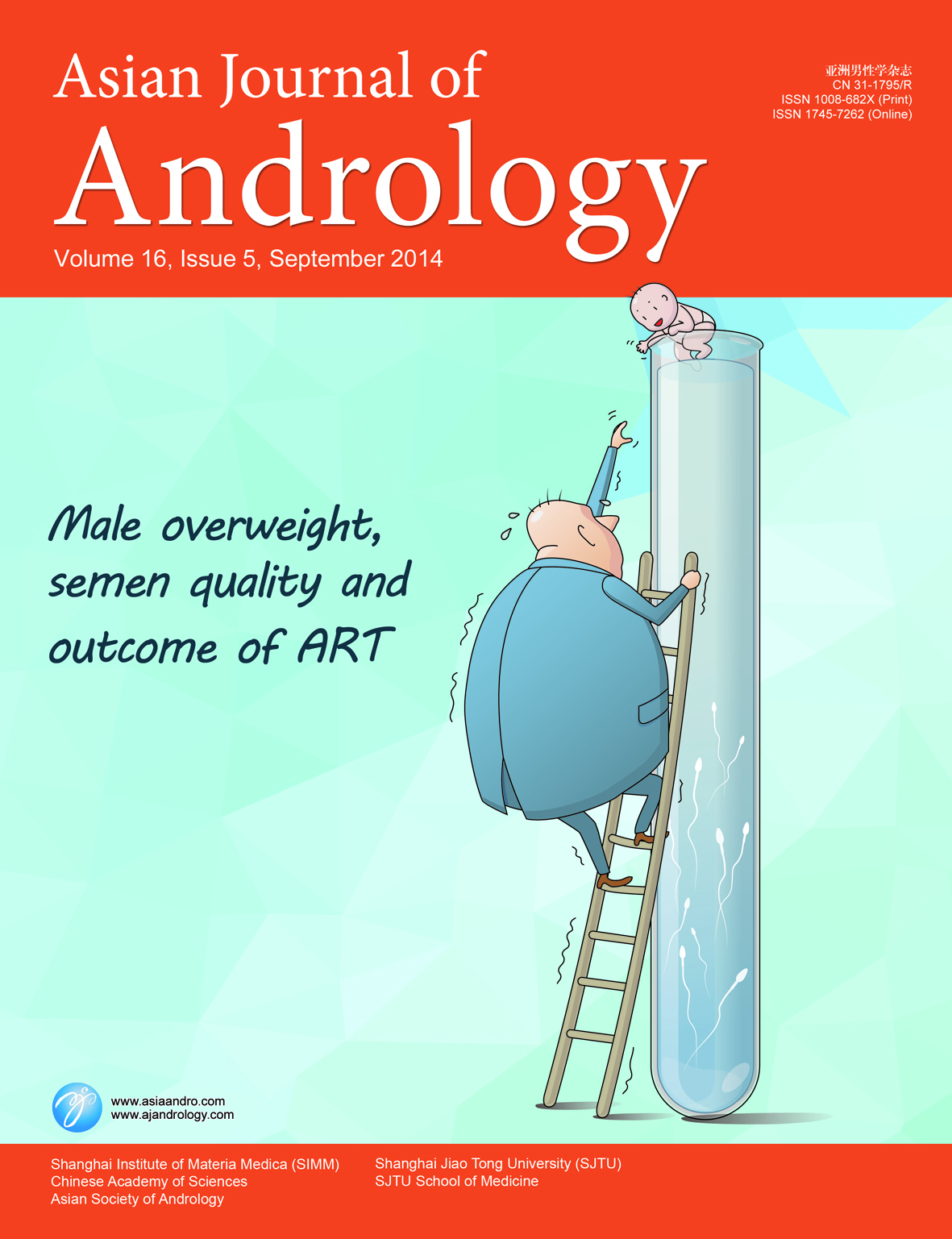
Vol.16 No.5 |
The average body mass index (BMI) is generally rising for both men and women in the Western world and along with this a concern for the possible harmful effect on the reproductive potential has emerged. It is well known that female weight disturbances affect fertility negatively and as a consequence, many European fertility clinics require female weight loss to a specific BMI threshold before initiating assisted reproductive technology (ART) treatment. From the male perspective, however, it is still unclear to what extent overweight and obesity affect sperm quality and the chances of conceiving-spontaneously as well as after ART. The relatively limited data published are conflicting and, therefore, it is still uncertain whether male weight loss will increase natural or assisted fertility. In this issue, Thomsen et al. investigate whether increased male BMI affects sperm quality and the outcome of assisted reproduction in 612 couples undergoing ART treatment at a Danish Fertility Centre. For more information, please refer to the article on pages 749–754.
(Art by Xiang Chen) |
| |
|
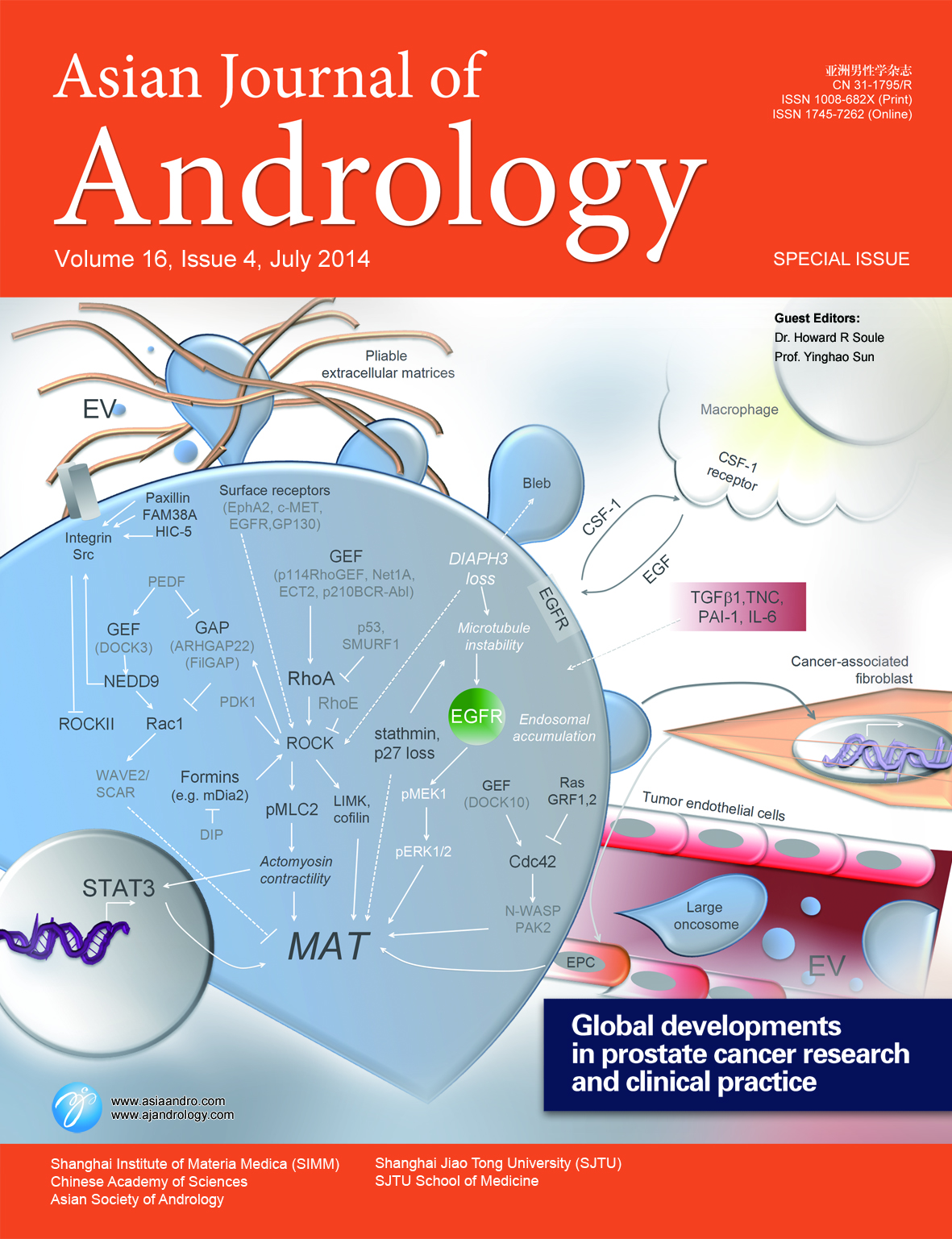
Vol.16 No.4 |
GLOBAL DEVELOPMENTS IN PROSTATE CANCER RESEARCH AND CLINICAL PRACTICE
Prostate cancer patients die as a result of metastasis to bone and soft tissue. To disseminate through complex microenvironments, cancer cells employ diverse strategies. Amoeboid invasion is a rapid mode of tumor cell motility in which actomyosin contractility and propulsive forces enable cells to traverse spaces between fibrillar matrices. Amoeboid behavior is mediated by RhoA/ROCK activation, integrin localization, cytoskeletal dynamics, receptor stimulation, and loss of Diaphanous-related formin-3 (DIAPH3). Amoeboid cells shed extracellular vesicles (EVs), called ‘large oncosomes,’ which enable cross-talk with the tumor stroma. Morley et al summarize the current understanding of amoeboid invasion. For more information, please refer to the article on pages 530–535. (The image was created by Samantha Morley, and artwork is displayed by Xiang Chen.) |
| |
|
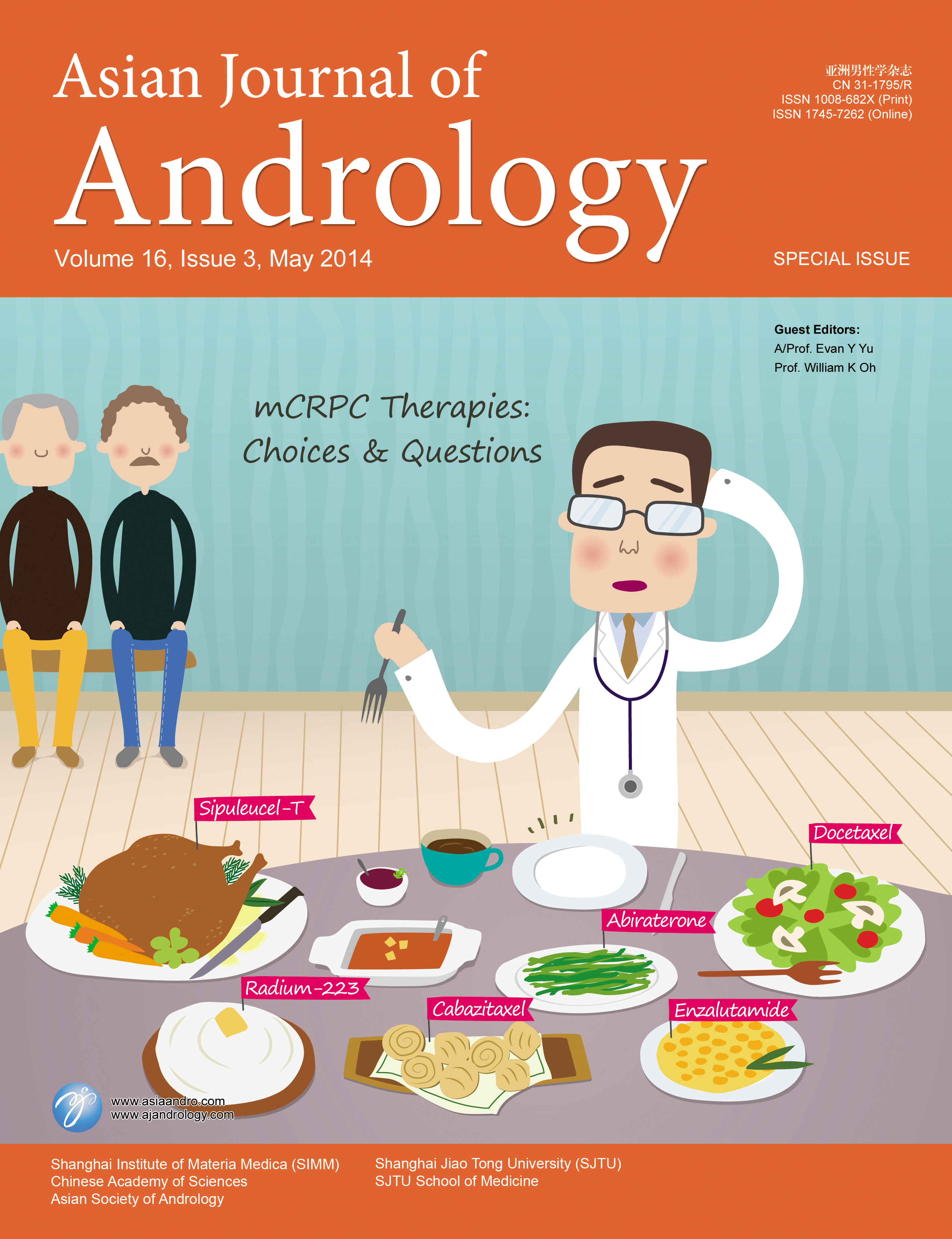
Vol.16 No.3 |
mCRPC Therapies: Choices and Questions
In 2004, docetaxel demonstrated a modest, yet meaningful survival and pain palliative benefit. Since then, we have seen the approval of sipuleucel-T, cabazitaxel, abiraterone, enzalutamide and radium-223 broaden the menu of agents that prolong overall survival in metastatic castration-resistant prostate cancer (mCRPC). Although each is moderately effective, none of these agents offer a cure and the biologic and clinical data to explain mechanisms of drug resistance remains scanty at best. As a result, the field must now rely on practical considerations, with much data extrapolation, to fuel logical utilization and sequencing of these therapies in hopes of achieving optimal patient outcomes. In this special issue, these new agents will be discussed thoroughly. This includes review of biologic mechanism of action, clinical efficacy and safety data, biomarkers and opinions on pragmatic use and combinations for future exploration. Although, the topics may be drug-focused, there is the inclusion of broad discussion on entire fields of therapy with historical and pre-clinical perspective. (Art by Xiang Chen)
|
| |
|
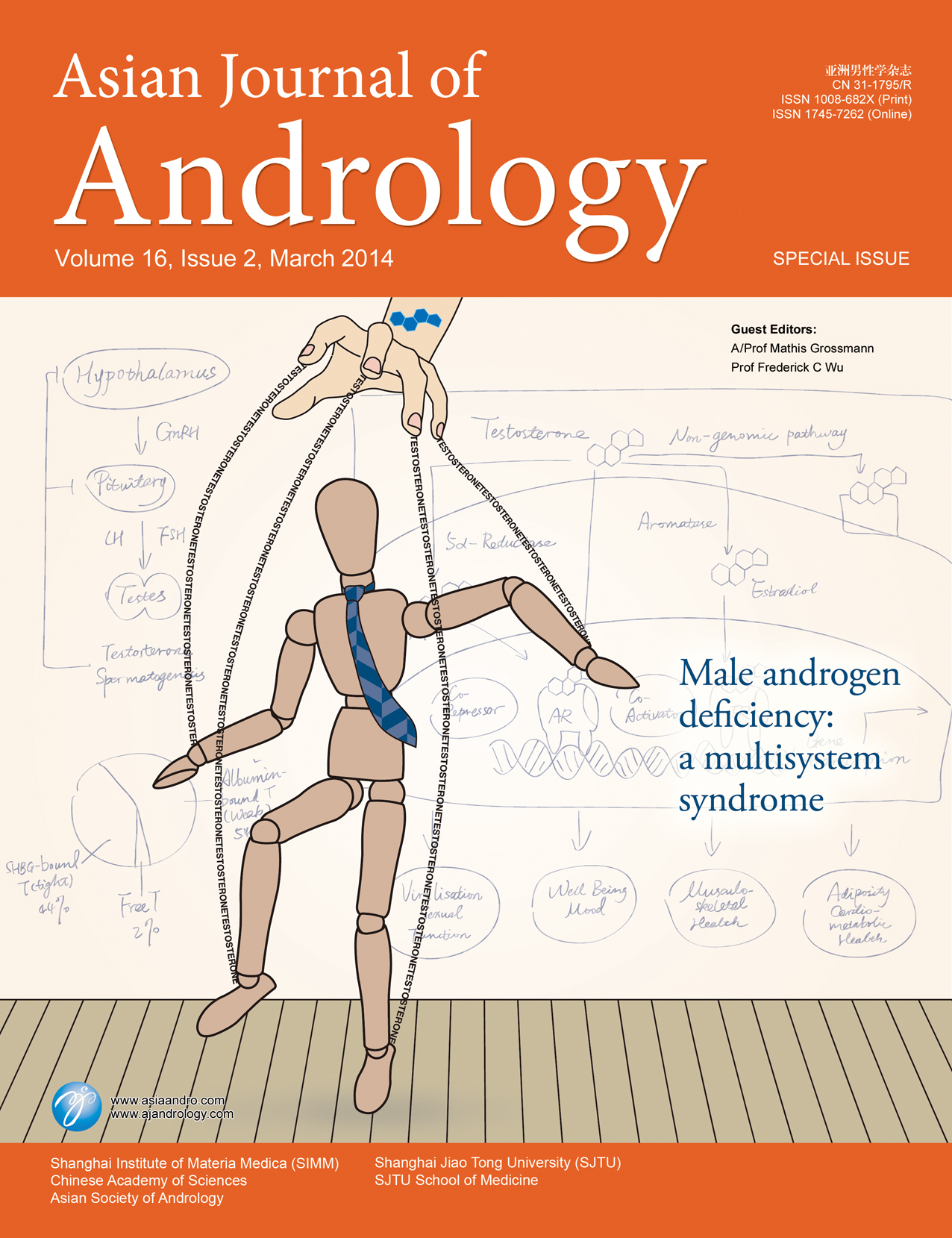
Vol.16 No.2 |
Male androgen deficiency: a multisystem syndrome
Androgens have important effects on multiple organ systems which play critical roles in the regulation of a myriad of male sexual, somatic and behavioral functions critical to lifelong health. Androgen deficiency is a multi-system syndrome, presenting with typical clinical features in association with a confirmed low serum testosterone levels. This special supplement of the Asian Journal of Andrology is intended to reflect the complexity of male androgen deficiency disorders. It provides a critical update on many recent advances in clinical and experimental aspects of male androgen deficiency. A particular focus is on organ systems that, while not traditionally or directly associated with sexual or reproductive functions, critically contribute to male health over the life course. While this issue highlights progress in male health, many important current knowledge gaps and areas of controversies are also emphasised. In this vibrant field of research, many exciting opportunity remains for further research and therapeutic development towards improving men’s health and quality of life. (Art by Xiang Chen) |
| |
|
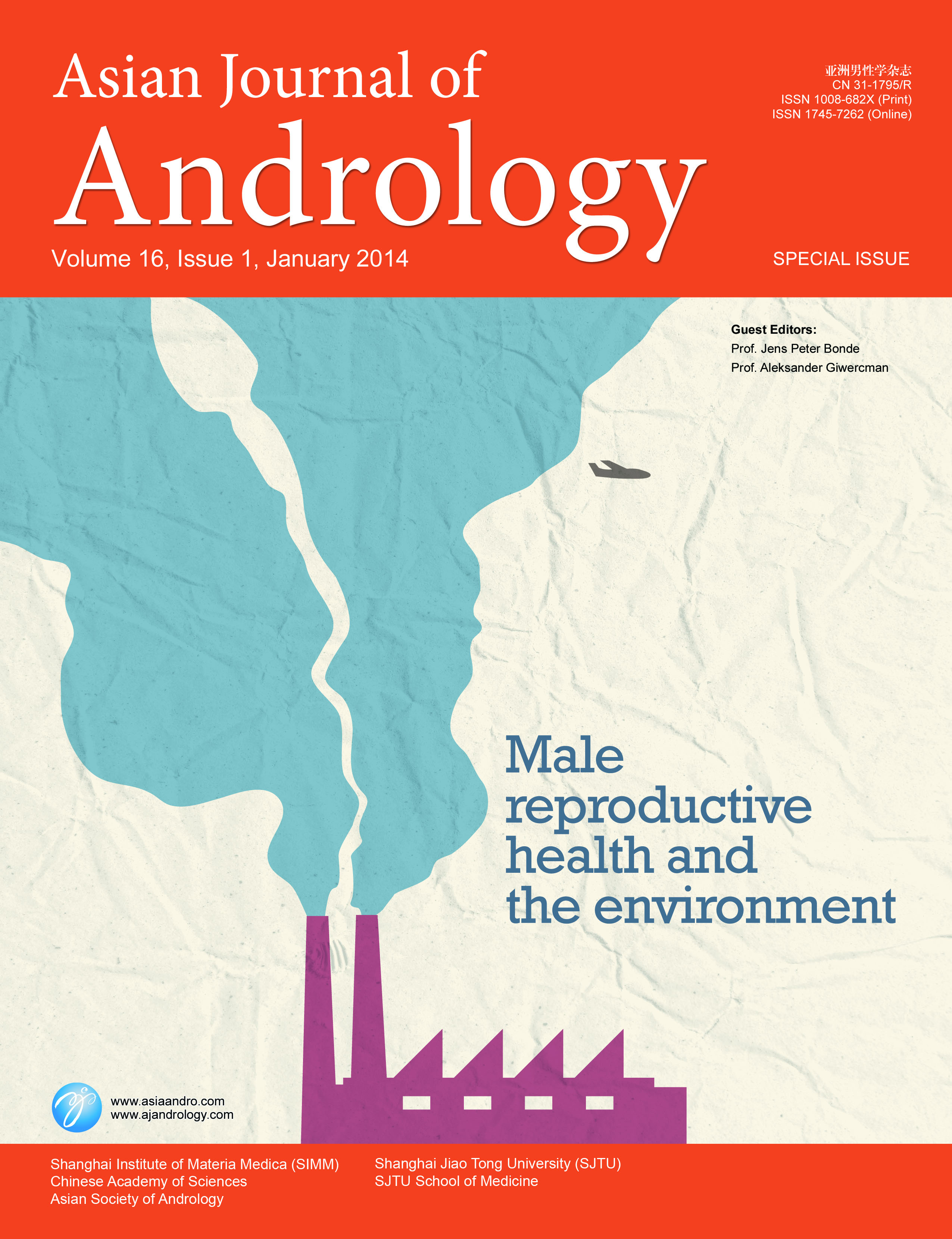
Vol.16 No.1 |
Male Reproductive Health and the Environment
Lessons from the occupational arena demonstrate the potential of industrial chemicals to damage human testicular function. An important but still unresolved question is whether low-level xenobiotic exposure of the general population poses a hazard. This special issue is addressed by a series of reviews on xenobiotic exposure profiles, possible biological mechanisms, research methods and knowledge on impact of specific exposures. Interdisciplinary research fields as gene-environment interaction and male-mediated developmental toxicity is also addressed. Papers are cross-linked by answers to questions mutually put forward by ten contributors. They consider the key issues about “Environmental Xenobiotics and Male Reproductive Health”. (Art by Xiang Chen) |
| |
| 2013 |
|
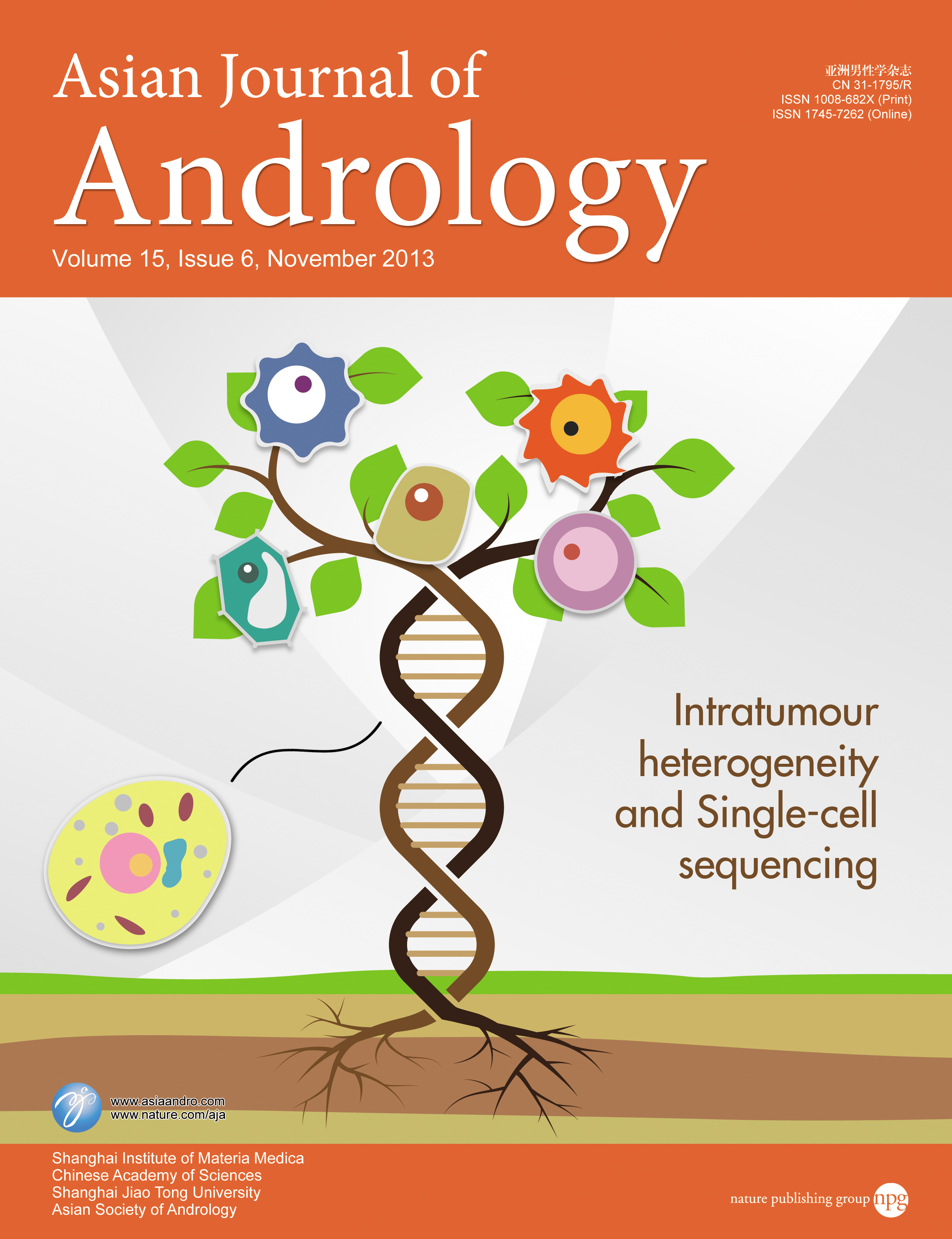
Vol.15 No.6 |
Intratumour heterogeneity represents that the tumour lesion is composed of different tumour cells which play different roles in keeping the microenvironment of the tumour. The existence of intratumour heterogeneity affects the clinical intervention of the disease, thus raises the risk of disease-related mortality. Single-cell sequencing, as a newly developed technology, is widely used in tumour molecular biology and microbiology based on next generation sequencing. Like the different flowers and DNA double helix structure on the cover, single-cell sequencing is a scalpel to analyze the different functions of intratumoural cells, which increases the accuracy of early diagnosis, targeted treatment and prognosis prediction. (Art by Xiang Chen) |
| |
|
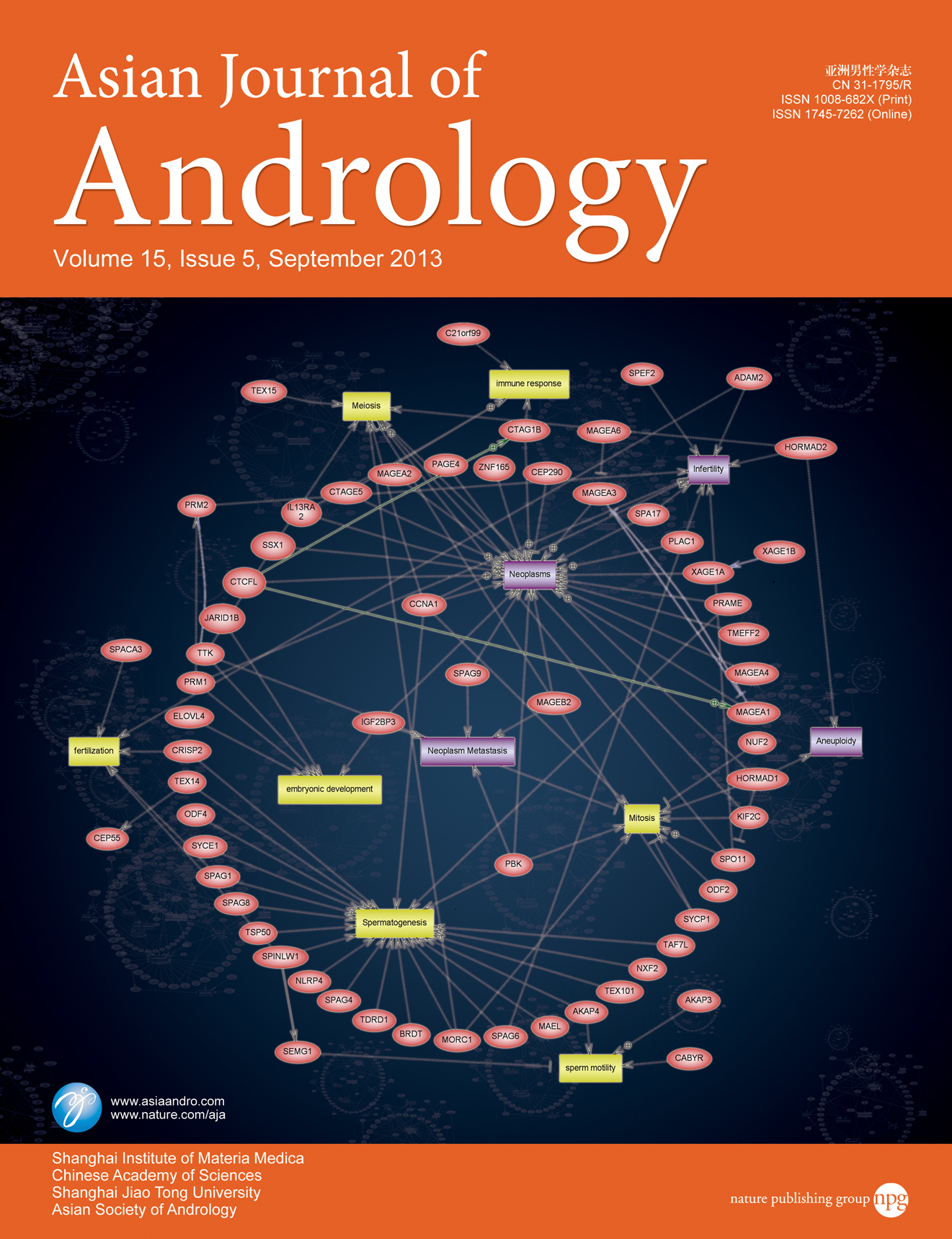
Vol.15 No.5 |
Proteomics strategies have been widely used in the field of male reproduction. For example, proteomes of human sperm and testis have been established. Bioinformatics is indispensable in the interpretation of high-throughput data from proteomics-based studies. It can help us understand the biology of spermatogenesis and also aid the discovery of potential biomarkers for male infertility. For example, with the help of bioinformatics, six novel cancer/testis
genes can be identified based on human testis proteome. These genes could be candidate diagnostic biomarkers for cancers, as well as a valuable resource for the analysis of spermatogenesis. The cover image depicts the representative network of known cancer/testis
genes in spermatogenesis and tumorigenesis. Bioinformatics can provide us with powerful connections between the proteomic data and the hidden biological significance. For more information, please refer to the review by Dr Zhou et al. on pages 594-602. (Art by
Xiang Chen) |
| |
|
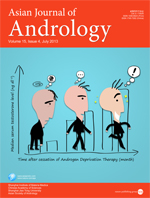
Vol.15 No.4 |
Androgen deprivation therapy (ADT) is widely used in the treatment of metastatic, recurrent and locally advanced prostate cancer. However, ADT, which leads to castrate testosterone level, is associated with numerous side effects, such as sexual dysfunction, osteoporosis, obesity and cardiovascular morbidity. Once the serum testosterone level recovers to normal range, ADT-related side effects will disappear gradually. In this issue, Dai et al (pages 466-470) found that in most clinically localized prostate cancer patients treated by surgery and subsequent short-term adjuvant ADT, serum testosterone can recover to normal range at 12 months after ADT cessation. Moreover, patients with higher baseline testosterone level need shorter time of testosterone normalization after ADT cessation. (Art by Xiang Chen)
|
| |
|
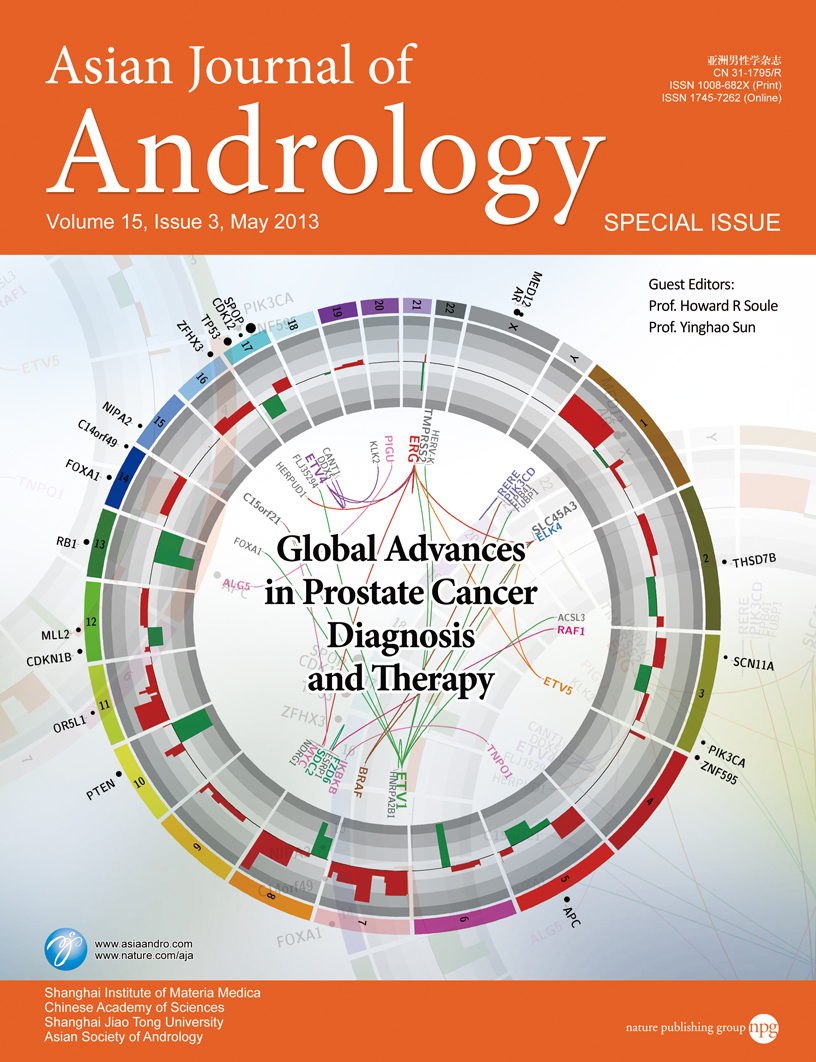
Vol.15 No.3 |
Global Advances in Prostate Cancer Diagnosis and Therapy special issue
Global next-generation sequencing efforts have revealed the molecular landscape of prostate cancer to be rife with complexity. However, we are taking huge strides towards a more comprehensive understanding of this lethal disease, and increasing evidence suggests that genomic lesions frequently converge on specific cellular functions and signalling pathways. We are now entering an exciting era in prostate cancer research, where our vast array of sequence data can be exploited for diagnostic and therapeutic gain. Indeed, the cover image depicts significant molecular lesions in prostate cancer, several of which have the potential to affect patient treatment in the near term. For more information, please refer to the article by Dr Wyatt et al. on pages 301-308. (Art by Xiang Chen) |
| |
|

Vol.15 No.2 |
FALLING SPERM COUNTS AND GLOBAL ESTROGEN POLLUTION: LESSONS LEARNED 20 YEARS ON
This special issue is directed towards the lessons learned since two publications in 1992 which prompted the most public, fervent and durable controversy in the short history of Andrology: the claims of world-wide falling sperm counts due to global pollution by industrial estrogenic chemicals. To this end, after the passage of two decades, we invited the progenitors of the controversy as well as range of experienced medical scientists familiar with the controversies to reflect on the lessons learned and offer their summations across a broad range of perspectives. Twelve contributors consider the key issues of whether there is any real decline in sperm counts, and, if there is, whether this has an impact on male fertility , and finally whether global oestrogen pollution causes any of these phenomena. (Art by Xiang Chen) |
| |
|

Vol.15 No.1 |
Surgeries in Andrology
This image on the cover is a parody of Rodin’s ‘‘Thinker’’. It is being used to represent the reluctance of men to seek medical attention, especially when the problem involves their genitalia. Recent advances in andrological surgeries make treatment of even the most challenging of these conditions more successful and less invasive than in times-past. In this context, we are pleased to present this 2013 Asian Journal of Andrology special issue focusing on "Surgeries in Andrology". This special issue is intended to provide a concise and substantive update for surgical treatment of conditions related to male sexual dysfunction and male fertility. (Art by Vanessa L. Dudley) |
| |
| 2012 |
|

Vol.14 No.6 |
Col1a1, one of the subunit of collagen type I, belongs to extracellular matrix proteins which play a critical role in cellular proliferation and differentiation. However, the role of Col1a1 in the control of proliferation and differentiation of spermatogonial stem cells remains unknown. In this issue, Chen et al. (pages 842-849) explored effects of downregulation of Col1a1 on proliferation and differentiation of mouse spermatogonia. Their data suggest that decreasement of Col1a1 could suppress spermatogonia self-renewal and promote differentiation. In the cover illustration, whether spermatogonia differentiation occurs depends on the opening of blood-testis barrier (the faucet), which is regulated by a number of factors including the Col1a1 (the child in red?) and others (the child in black). These factors work together to either promote or suppress the spermatogonia differentiation, which ultimately leads to the dynamic equilibrium of spermatogonia proliferation and differentiation. (Art by Yiliang Wang.) |
| |
|

Vol.14 No.5 |
Bortezomib has been approved for the treatment of multiple myeloma, and is currently being investigated in other cancers. In this issue, Hu et al. (pages 695-702) demonstrated that bortezomib causes prostate cancer cells to up-regulate apoptosis-related mRNA as well as death receptors and down-regulate the MHC–I molecule on the cell surface. These data suggest that bortezomib can be used to sensitize prostate cancer cells to NK cell-mediated killing and improve current cancer therapies. This therapeutic strategy may be more effective in patients with androgen-independent prostate cancer. In the cover illustration, prostate cancer (middle) is very frightened because it will be killed by natural killer cells (left and right) soon through apoptotic pathway and others. Bortezomib may enhance immunotherapy for prostate cancer by decreasing the surface expression of MHC-I and increasing the surface expression of death receptors DR5 and Fas. (Art by Xiang Chen.) |
| |
|

Vol.14 No.4 |
The induced pluripotent stem (iPS) cells could have unlimited potentials to differentiate into various kinds of cell lineages for both regenerative and reproductive medicine. In this issue, Zhu et al. (pages 574-579) demonstrated that mouse iPS cells can be induced by retinoic acid to differentiate into spermatogonial stem cells (SSCs) in vitro and that SSCs can further develop and become spermatogonia and eventually round spermatids in vivo when they are transplanted into recipient testes of infertile mice. The cover photograph illustrates the approaches and the generation of spermatids from mouse iPS cells. Art by Xiang Chen. |
| |
|

Vol.14 No.3 |
Special Issue on Differenntiation of Lethal and Non-Lethal Prostate Cancer
Although the introduction of serum prostate-specific antigen (PSA) in the 1980s has dramatically altered and benefited the initial diagnosis of prostate cancer, the widespread use of PSA testing resulted in overdetection and overtreatment of potentially indolent disease. Thus, a clinical dilemma today in the management of prostate cancer is to discern men with aggressive disease who need definitive treatment from men whose disease are not lethal. The goal of this AJA special issue is to determine if there are tools that can provide additional discrimination to the currently utilized clinical tools to identify those with the forms of prostate cancer most appropriate for a program such as active surveillance and those that will perhaps benefit for more aggressive therapeutic approaches. Basic and clinical scientists discuss current and future approaches to improve the health outcomes of men who are diagnosed with prostate cancer. A majority focuses on novel molecular approaches for the discrimination of lethal prostate cancer, for example, ETS gene rearrangements, CTAs, Cyr61, BRCA2 and genetic predisposition. |
| |
|

Vol.14 No.2 |
Special Section on the Complications of Androgen Deprivation Therapy
Prostate cancer is one of the most common malignancies in men worldwide. Androgen deprivation therapy (ADT) is widely used in the treatment of locally advanced and metastatic prostate cancer. Its use has increased over the past decade as patients with localized cancer and with biochemical recurrences are also being treated with ADT. While efficacious in a subset of patients, ADT is associated with many adverse effects such as sexual dysfunction, decreased muscle mass and strength, increased fat mass, osteoporosis, gynecomastia, memory changes and vasomotor symptoms. Recently, metabolic derangements, coronary artery disease and cardiovascular mortality have also emerged as adverse effects of ADT. This volume contains articles from renowned experts on the indications and adverse effects of ADT. In this special supplement, in addition to summarizing the indications of ADT, the leading experts have contributed on the following adverse effects of ADT: metabolic and cardiovascular, body composition, hematological, cognitive, vasomotor, quality of life and sexual. Given the large number of men on ADT, it is important that both patients and the physicians are cognizant of these adverse effects. |
| |
|

Vol.14 No.1 |
Special Issue on Clinical Male Infertility
Clinical Male Infertility Clinical evaluation of the infertile man is an essential skill in reproductive medicine, with male factors being involved in half of all infertile unions. Accurate diagnosis may allow specific treatments to restore natural fertility and/or identify serious medical conditions more prevalent tin infertile men, such as androgen or gonadotropin deficiency or testicular cancer. This volume contains articles by leading experts on the clinical and laboratory evaluation of infertile men along with background on the pathophysiology of the diverse causations of male infertility. For men for whom specific treatments are not available assisted reproductive treatments, especially intracytoplasmic sperm injection, provide a powerful means to bypass their disability leading to the birth of their own offspring. The emerging science about the environmental and genetic basis of spermatogenic failure is considered along with the implications for ARTconceived offspring. Finally the impact of infertility on couple and male partner is also considered. |
| |
| 2011 |
|

Vol.13 No.6 |
Prostate cancer (PCa) has become the most common malignancy that affects elderly men. Interestingly, PCa occurs predominantly in the peripheral zone (PZ) rather than transition zone (TZ). The mechanisms underlying this phenomenon are largely unknown. In the article of Jiang et al. on pages 798-805, utilizing prostate stromal cells derived from the peripheral zone (PZsc) and the transition zone (TZsc), they found that PZsc provide better stromal microenviroments than TZsc by secreting growth factors, and PZsc have a greater capacity to induce PCa development and progression than TZsc via growth factors regulated by sex hormones. Therefore, targeting stroma in PZ may aid the search for novel prevention and therapeutic strategies for PCa. |
| |
|

Vol.13 No.5 |
Di-n-butyl phthalate (DBP) is an industrial chemical used primarily as plasticizers and is present in a wide variety of products in our daily life, including building materials, medical devices, and particularly food packaging. In the article of Bao et al. on pages 702-709, when male rats were treated with low doses of DBP which are similar to environmental exposure doses, the expression levels of proteins participating in spermatogenesis have changed although no obvious morphological changes appeared. So it is also an endocrine-disrupting chemical that has the potential to affect male reproduction. Therefore, now whether to add DBP in these industrial products, and whether to use these products in male daily life really are the questions. For more information, please refer to the article of Prof. Sha JH et al. on pages 702-709 |
| |
|

Vol.13 No.4 |
Asian Men Health
The seed for the development of men9s health in Asia was sowed about 10 years ago. This nascent ‘germination’ has certainly grown into a small, but healthy and luxuriant ‘shrub’. The miniature canopy of variant colours signifies the diversed development of men9s health status in Asia. The time is right to plant a strong and deep foundation in the field of men9s health in Asia. With the widespread interest in men9s health issues among the ever enlarging stakeholders, it is our hope and believe that the growth of men9s health development is poised to flourish into a strong unshakable discipline (tree) of medicine. For more information, please refer to the article of Prof. Zhu JC et al. on pages 512-518. |
| |
|

Vol.13 No.3 |
Although a number of genes are known to be involved in spermatogenesis, only a few possess clean-cut arrest phenotypes indicative of their role in global regulation of key spermatogenic steps. LM23 is a gene with testis-specific expression in Rattus norvegicus. The LM23 knock down testes contained germ cells arrested at the spermatocyte stage. LM23 may regulate the G1/S and G2/M transition of the cell cycle. Both Fas-FasL pathway and the mitochondrial pathway may be activated for the down-regulation of LM23. LM23 may be important to both the life and death of the spermatogenic cell. For more information, please refer to the article by Dr Cheng et al. on pages 446-452. |
| |
|

Vol.13 No.2 |
Currently, docetaxel-based combination chemotherapy remains the predominant modality for castration-resistant prostate cancer. However, taxane-related drug resistance and neurotoxicity limit its clinical utility. The mitotic kinesin-5 motor protein Eg5, which plays a critical role in bipolar spindle formation and duplicated chromosome separation during the early phase of mitosis, has emerged as an attractive target for cancer chemotherapy because inhibition of Eg5 can arrest dividing cells in mitosis followed by cell death, without affecting the function of interphase microtubules. A novel Eg5 inhibitor, S-(methoxytrityl)-L-cysteine [S(MeO)TLC], its potent anticancer efficacy was assessed in prostate cancer both in vitro and in vivo in the article of Dr Xing et al. on pages 236-241. |
| |
|

Vol.13 No.1 |
Special Issue on Cell Biology and Genetics of Sperm
The cover picture depicts a cryostat section of mouse testis treated with lucigenin, NADH (nicotinamide adenine dinucleotide) and ethidium bromide. Under these conditions the lucigenin probe localizes to the mitochondria and generates a striking image of the mitochondrial gyres as they are assembled in differentiating spermatozoa within the germinal epithelium (Joel Thogersen and John Aitken, unpublished observations). The mitochondria are the major source of free radicals in spermatozoa and via this mechanism make a significant contribution to oxidative stress in these cells as described in the Chapter by Aitken and Koppers (see pages 36-42). |
| |
| 2010 |
|

Vol.12 No.6 |
Because the androgen-signaling pathway is integral in prostate cancer progression, to gain beneficial effects when managing high risk prostate cancer, androgen deprivation therapy has been highlighted as an optimal systemic modality. Results from several randomized clinical trials have already showed that the combination of radiotherapy and androgen deprivation therapy consistently results in improved disease-free survival and in a decreased biochemical recurrence rate. As an integrated approach combining local therapy and systemic treatment, prolonged androgen deprivation with cryoablation may also lead to a synergistic effect, providing a wider therapeutic territory over that which has been directly affected by cryoablation, especially for high risk patients in whom systemic disease is likely. For more information, please refer to the article by Ko et al. on pages 827-834. |
| |
|

Vol.12 No.5 |
Recently, a few of RING finger proteins have been reported to be E3 ubiquitin-protein ligases exclusively present in the testis tissue and play important roles in the process of sperm production and qualitycontrol. ZNF645, a novel RING finger protein, is identified to be exclusively expressed in normal human testicular tissue, present in Leydig cells, spermatocytes, and the postacrosomal perinuclear theca region & the entire tail of sperm. ZNF645 contains a C3HC4 RING finger domain, a C2H2 zinc-finger domain, and a proline-rich region, and might be an E3 ubiquitin ligase. For more information, please refer to the article of Dr. Liu et al. on pages 658-666. |
| |
|

Vol.12 No.4 |
Since time immemorial, plants have been used as valuable and safe natural source of medicines across various civilizations. The healing abilities of wide majority of plants could be ascribed to the pharmacological principles present in them. Plants have a long folklore in aiding fertility. On the other hand, several commonly used plants are known to impair male reproductive functions. The toxicological attributes of various commonly used plants could be due to their effects on various cell types in the testes leading to impaired spermatogenesis and steroidogenesis. From the reproductive standpoint, plants could be rightly described as a double-edged sword. For more information, please refer to the article of Prof. D’Cruz et al. on pages 468-479 |
| |
|

Vol.12 No.3 |
Currently, there are only two clinically approved and effective methods of male contraception, condoms and vasectomy. Each method has drawbacks. Condoms provide protection against sexually-transmitted disease, but are intrusive and associated with a relatively high rate of unintended pregnancy. Vasectomy is highly effective, but is difficult to reverse and may lead to chronic testicular discomfort. Newer approaches to male contraception as well as optimization of existing contraceptive approaches such as vasectomy are needed to prevent unintended pregnancy. For more information, please refer to the article of Professor Amory et al. on pages 315-321. |
| |
|

Vol.12 No.2 |
With the release of the latest edition of the World Health Organization (WHO) Laboratory Manual for the Examination and Processing of Human Semen (5th edition), Asian Journal of Andrology (AJA) is pleased to present this special issue on "Semen Analysis in 21st Century Medicine" which launches into a sometimes incendiary debate surrounding the recommendations and guidelines for quality control and interpretation set down in the manual. We are honored to invite Prof David J Handelsman and Prof. Trevor G Cooper to be the guest-editors. The purpose of the collection is to discuss some of the behind the scenes controversies, many of which continue, including the origins, utility and specific applications of population reference ranges for semen analysis, problems with modern morphological methodology and the possibility and limitations using semen analysis in population or clinical research studies beyond the original uses for male infertility evaluation. It is our sincere hope that perspectives in this issue will educate readers to approach the new WHO manual with a realistic and critical appreciation of the balance its recommendations represent. In short, we are very excited to present this outstanding collection, and would like to thank two guest-editors and all of our authors for their contributions and support to AJA. We wish the readers a happy and productive New Year and please sit back and enjoy this Special Issue! |
| |
| 2007 |
|

Vol.9 No.4 |
Epididymis
The Fourth Epididymis (Epid IV) Workshop was held between December 4th and 7th 2006 in Chatel-Guyon,
France. This was the first European venue for these workshops following Epid III held in Charlottesville, Virginia,
USA in 2002, Epid II held in Newcastle, Australia in 1998 and a one-day meeting (later named Epid I) in Hong Kong,
China in 1992. The 2006 meeting was organised by Drs Jo雔 R. Drevet (Aubi鑢e, France) and Trevor G. Cooper
(M黱ster, Germany) and was a satellite meeting of the Fourth European Congress of Andrology (ECA2006) which
followed in Toulouse (France) from December 8th to 10th. Epid IV was attended by 90 basic science researchers
from 14 countries. The hotel accommodation was adjacent to the meeting hall and the meeting proved an equal
distraction to the lure of the Casino in the same building! Posters were viewed from the beginning to the end of the
workshop and frequent coffee breaks were organised among them to facilitate scientific exchange. In these hospitable
conditions old acquaintances were revived and new friendships made.
The meeting started with an introductory lecture given by Russell Jones (Newcastle, Australia) on comparative
epididymology and was followed by 8 sessions of 4 to 5 presentations each (see the programme below for a detailed
list of speakers) in which various aspects of epididymal physiology were covered: sperm maturation and storage,
cellular and gene expression activities of the epididymal epithelium, recent advances in global approaches of the
epididymal transcriptome and proteome as well as the presentation of some putative epididymal contraceptive targets.
The last session of the programme was devoted to research carried out on the human epididymis and most of the
speakers in this session were also invited speakers at the ECA2006 meeting. A session was also devoted to presentations
given by young investigators who were selected from the 36 poster abstracts received. The final lecture was
given by David Hamilton (Mineapolis, MA, USA) on December 7th. As he could not attend the meeting, he provided
it as a video presentation. His talk entitled 揟he ~Omes are coming!?illustrated what, from his point of view, would
be epididymal research in the 21st century. During the meeting the site of the next epididymis workshop was
discussed. Drs P. S. Cuasnic?(Argentina) and M. C. W. Avellar (Brazil) stepped forward to propose the idea that
South America could host the next Epididymis workshop in 2010.
Most of the speakers agreed to produce a manuscript of their presentations that are collected in this Special Issue
of the Asian Journal of Andrology. |
| |
 |
| |
| Asian Journal of Andrology CN 31-1795/R ISSN 1008-682X Copyright © 2023 Shanghai Materia Medica, Chinese Academy of Sciences. All rights reserved. |
| |
|
| | |